CHCECE021 Early Childhood Education and Care - Desklib
VerifiedAdded on 2023/06/07
|31
|12993
|175
AI Summary
This article covers various tasks related to CHCECE021 Early Childhood Education and Care, including National Quality Standard, Education and Care Services National Law and National Regulations, Early Years Learning Framework, Reflection, Support the development of inclusive resources, and more.
Contribute Materials
Your contribution can guide someone’s learning journey. Share your
documents today.
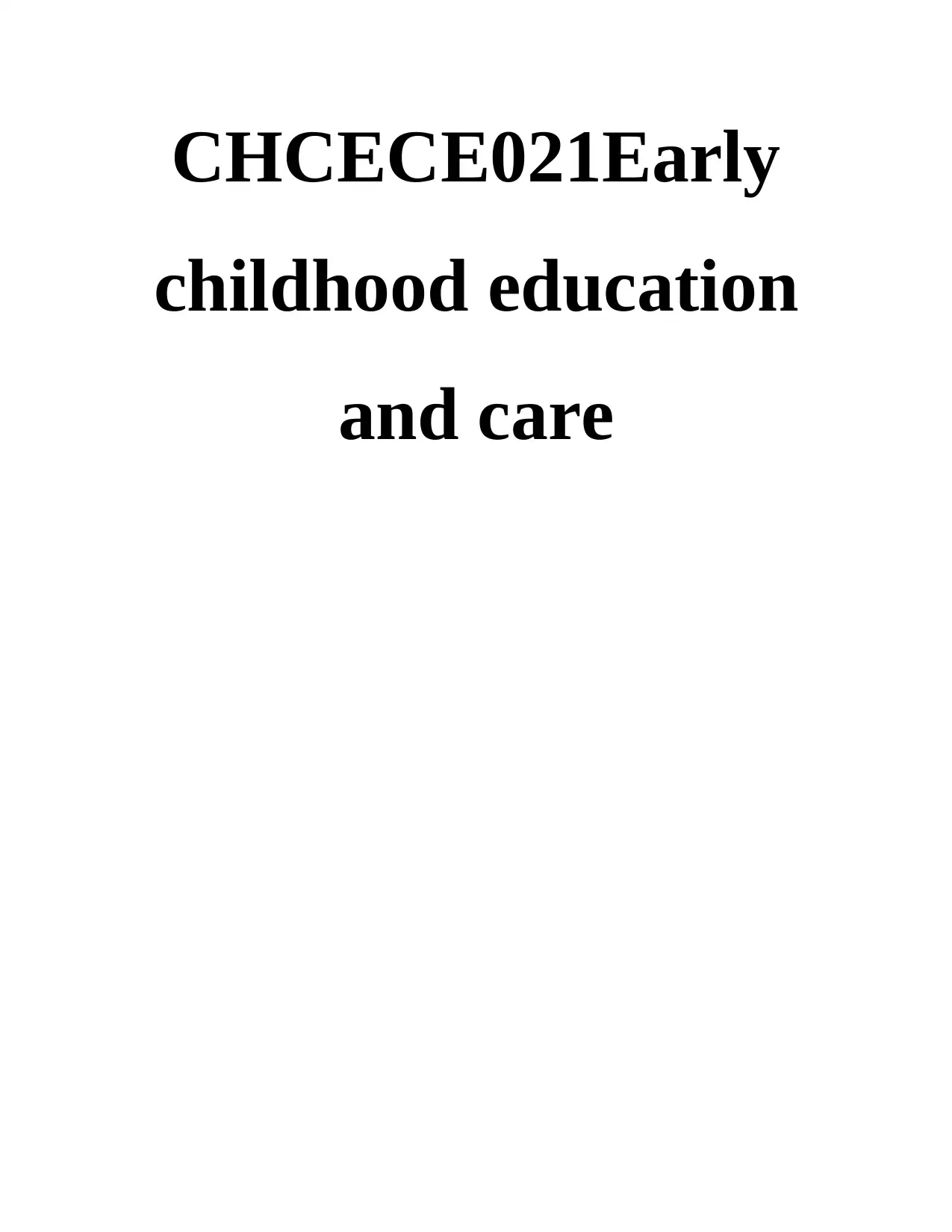
CHCECE021Early
childhood education
and care
childhood education
and care
Secure Best Marks with AI Grader
Need help grading? Try our AI Grader for instant feedback on your assignments.
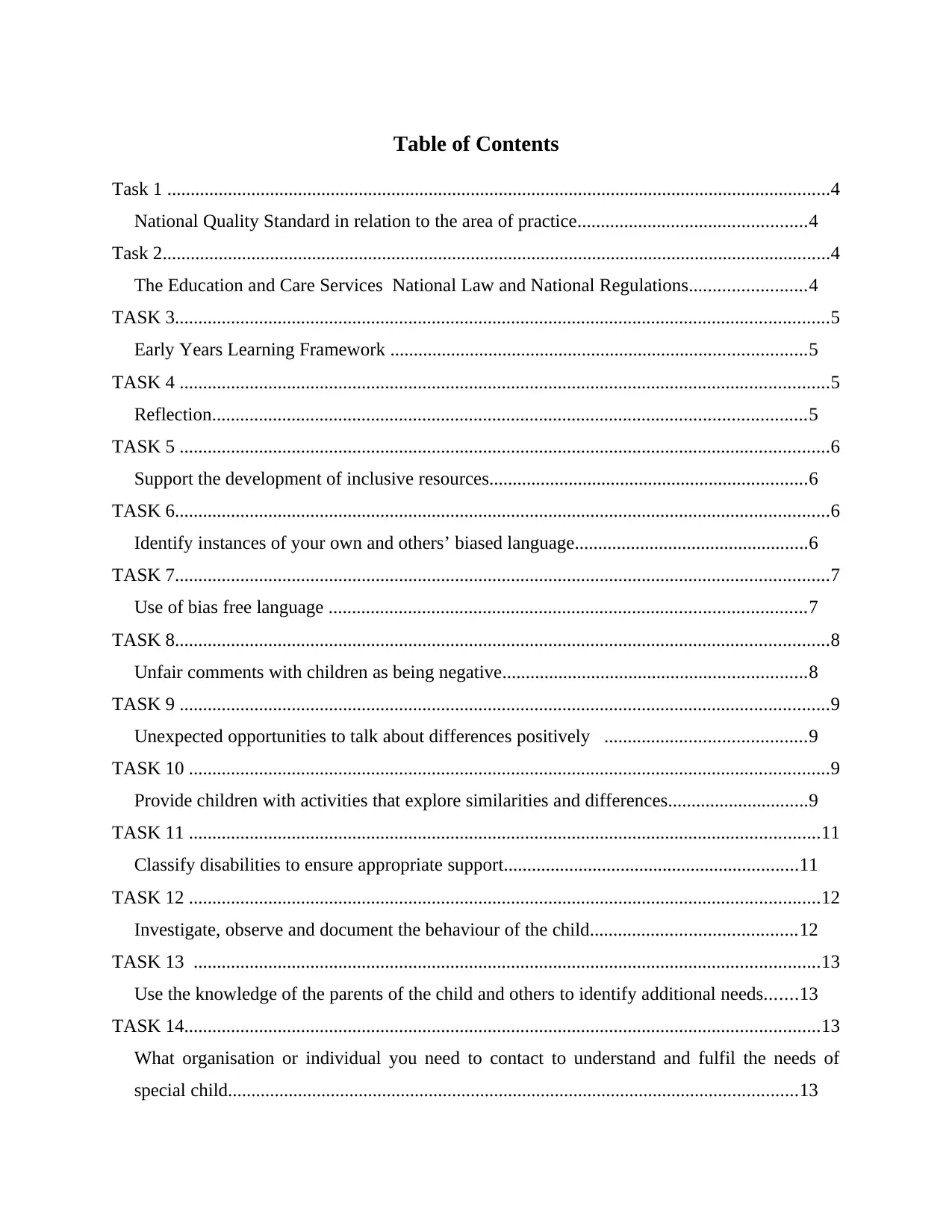
Table of Contents
Task 1 ..............................................................................................................................................4
National Quality Standard in relation to the area of practice.................................................4
Task 2...............................................................................................................................................4
The Education and Care Services National Law and National Regulations.........................4
TASK 3............................................................................................................................................5
Early Years Learning Framework .........................................................................................5
TASK 4 ...........................................................................................................................................5
Reflection...............................................................................................................................5
TASK 5 ...........................................................................................................................................6
Support the development of inclusive resources....................................................................6
TASK 6............................................................................................................................................6
Identify instances of your own and others’ biased language..................................................6
TASK 7............................................................................................................................................7
Use of bias free language ......................................................................................................7
TASK 8............................................................................................................................................8
Unfair comments with children as being negative.................................................................8
TASK 9 ...........................................................................................................................................9
Unexpected opportunities to talk about differences positively ...........................................9
TASK 10 .........................................................................................................................................9
Provide children with activities that explore similarities and differences..............................9
TASK 11 .......................................................................................................................................11
Classify disabilities to ensure appropriate support...............................................................11
TASK 12 .......................................................................................................................................12
Investigate, observe and document the behaviour of the child............................................12
TASK 13 ......................................................................................................................................13
Use the knowledge of the parents of the child and others to identify additional needs.......13
TASK 14........................................................................................................................................13
What organisation or individual you need to contact to understand and fulfil the needs of
special child..........................................................................................................................13
Task 1 ..............................................................................................................................................4
National Quality Standard in relation to the area of practice.................................................4
Task 2...............................................................................................................................................4
The Education and Care Services National Law and National Regulations.........................4
TASK 3............................................................................................................................................5
Early Years Learning Framework .........................................................................................5
TASK 4 ...........................................................................................................................................5
Reflection...............................................................................................................................5
TASK 5 ...........................................................................................................................................6
Support the development of inclusive resources....................................................................6
TASK 6............................................................................................................................................6
Identify instances of your own and others’ biased language..................................................6
TASK 7............................................................................................................................................7
Use of bias free language ......................................................................................................7
TASK 8............................................................................................................................................8
Unfair comments with children as being negative.................................................................8
TASK 9 ...........................................................................................................................................9
Unexpected opportunities to talk about differences positively ...........................................9
TASK 10 .........................................................................................................................................9
Provide children with activities that explore similarities and differences..............................9
TASK 11 .......................................................................................................................................11
Classify disabilities to ensure appropriate support...............................................................11
TASK 12 .......................................................................................................................................12
Investigate, observe and document the behaviour of the child............................................12
TASK 13 ......................................................................................................................................13
Use the knowledge of the parents of the child and others to identify additional needs.......13
TASK 14........................................................................................................................................13
What organisation or individual you need to contact to understand and fulfil the needs of
special child..........................................................................................................................13
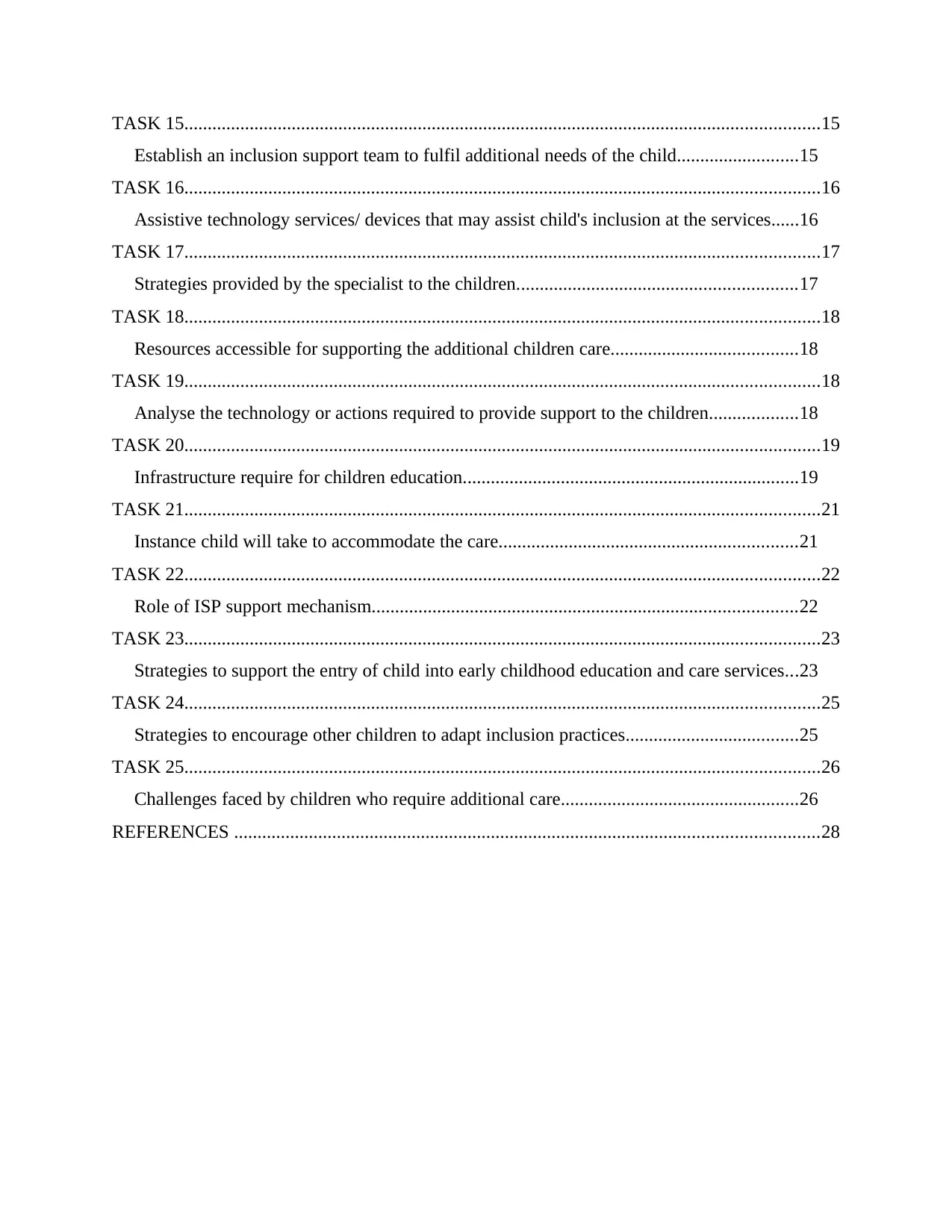
TASK 15........................................................................................................................................15
Establish an inclusion support team to fulfil additional needs of the child..........................15
TASK 16........................................................................................................................................16
Assistive technology services/ devices that may assist child's inclusion at the services......16
TASK 17........................................................................................................................................17
Strategies provided by the specialist to the children............................................................17
TASK 18........................................................................................................................................18
Resources accessible for supporting the additional children care........................................18
TASK 19........................................................................................................................................18
Analyse the technology or actions required to provide support to the children...................18
TASK 20........................................................................................................................................19
Infrastructure require for children education........................................................................19
TASK 21........................................................................................................................................21
Instance child will take to accommodate the care................................................................21
TASK 22........................................................................................................................................22
Role of ISP support mechanism...........................................................................................22
TASK 23........................................................................................................................................23
Strategies to support the entry of child into early childhood education and care services...23
TASK 24........................................................................................................................................25
Strategies to encourage other children to adapt inclusion practices.....................................25
TASK 25........................................................................................................................................26
Challenges faced by children who require additional care...................................................26
REFERENCES .............................................................................................................................28
Establish an inclusion support team to fulfil additional needs of the child..........................15
TASK 16........................................................................................................................................16
Assistive technology services/ devices that may assist child's inclusion at the services......16
TASK 17........................................................................................................................................17
Strategies provided by the specialist to the children............................................................17
TASK 18........................................................................................................................................18
Resources accessible for supporting the additional children care........................................18
TASK 19........................................................................................................................................18
Analyse the technology or actions required to provide support to the children...................18
TASK 20........................................................................................................................................19
Infrastructure require for children education........................................................................19
TASK 21........................................................................................................................................21
Instance child will take to accommodate the care................................................................21
TASK 22........................................................................................................................................22
Role of ISP support mechanism...........................................................................................22
TASK 23........................................................................................................................................23
Strategies to support the entry of child into early childhood education and care services...23
TASK 24........................................................................................................................................25
Strategies to encourage other children to adapt inclusion practices.....................................25
TASK 25........................................................................................................................................26
Challenges faced by children who require additional care...................................................26
REFERENCES .............................................................................................................................28
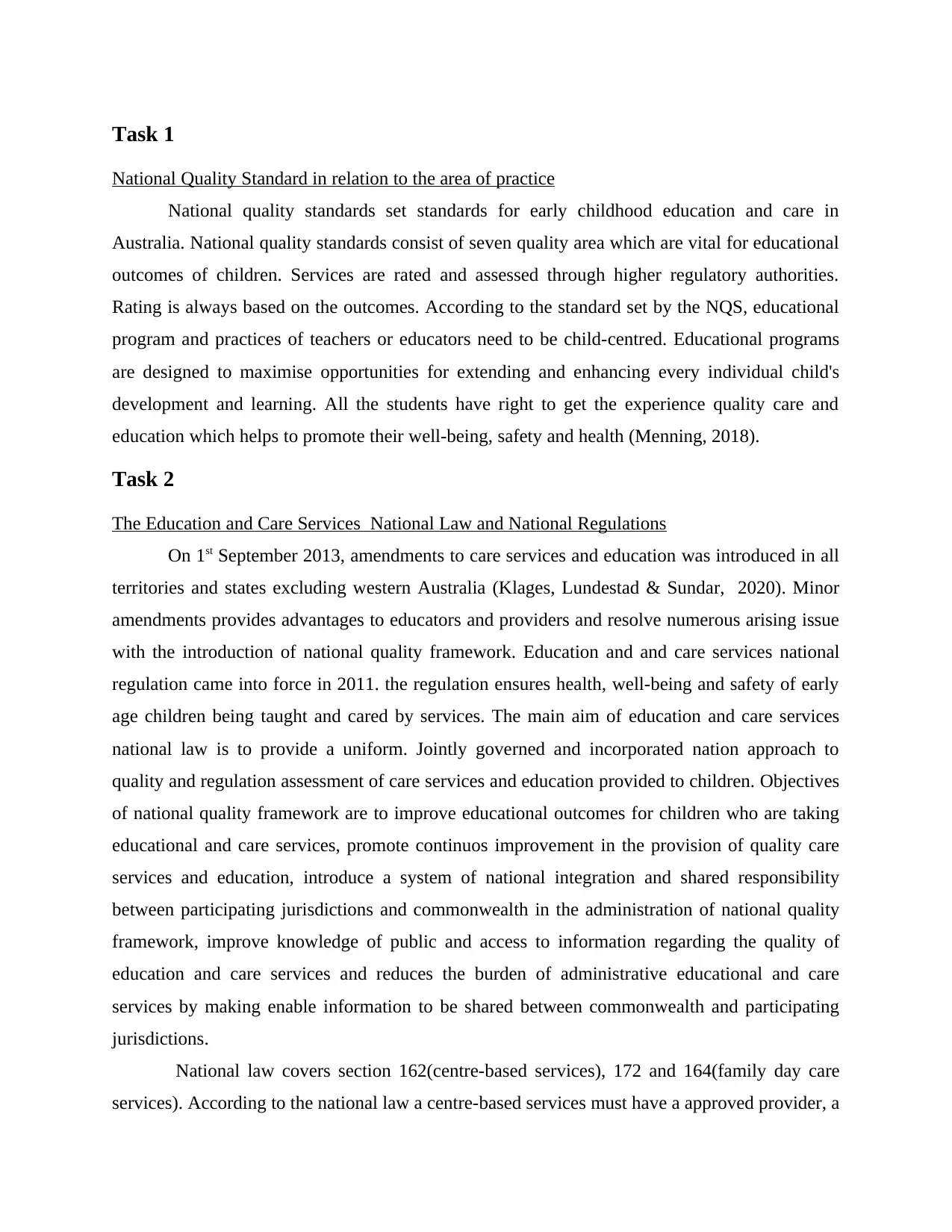
Task 1
National Quality Standard in relation to the area of practice
National quality standards set standards for early childhood education and care in
Australia. National quality standards consist of seven quality area which are vital for educational
outcomes of children. Services are rated and assessed through higher regulatory authorities.
Rating is always based on the outcomes. According to the standard set by the NQS, educational
program and practices of teachers or educators need to be child-centred. Educational programs
are designed to maximise opportunities for extending and enhancing every individual child's
development and learning. All the students have right to get the experience quality care and
education which helps to promote their well-being, safety and health (Menning, 2018).
Task 2
The Education and Care Services National Law and National Regulations
On 1st September 2013, amendments to care services and education was introduced in all
territories and states excluding western Australia (Klages, Lundestad & Sundar, 2020). Minor
amendments provides advantages to educators and providers and resolve numerous arising issue
with the introduction of national quality framework. Education and and care services national
regulation came into force in 2011. the regulation ensures health, well-being and safety of early
age children being taught and cared by services. The main aim of education and care services
national law is to provide a uniform. Jointly governed and incorporated nation approach to
quality and regulation assessment of care services and education provided to children. Objectives
of national quality framework are to improve educational outcomes for children who are taking
educational and care services, promote continuos improvement in the provision of quality care
services and education, introduce a system of national integration and shared responsibility
between participating jurisdictions and commonwealth in the administration of national quality
framework, improve knowledge of public and access to information regarding the quality of
education and care services and reduces the burden of administrative educational and care
services by making enable information to be shared between commonwealth and participating
jurisdictions.
National law covers section 162(centre-based services), 172 and 164(family day care
services). According to the national law a centre-based services must have a approved provider, a
National Quality Standard in relation to the area of practice
National quality standards set standards for early childhood education and care in
Australia. National quality standards consist of seven quality area which are vital for educational
outcomes of children. Services are rated and assessed through higher regulatory authorities.
Rating is always based on the outcomes. According to the standard set by the NQS, educational
program and practices of teachers or educators need to be child-centred. Educational programs
are designed to maximise opportunities for extending and enhancing every individual child's
development and learning. All the students have right to get the experience quality care and
education which helps to promote their well-being, safety and health (Menning, 2018).
Task 2
The Education and Care Services National Law and National Regulations
On 1st September 2013, amendments to care services and education was introduced in all
territories and states excluding western Australia (Klages, Lundestad & Sundar, 2020). Minor
amendments provides advantages to educators and providers and resolve numerous arising issue
with the introduction of national quality framework. Education and and care services national
regulation came into force in 2011. the regulation ensures health, well-being and safety of early
age children being taught and cared by services. The main aim of education and care services
national law is to provide a uniform. Jointly governed and incorporated nation approach to
quality and regulation assessment of care services and education provided to children. Objectives
of national quality framework are to improve educational outcomes for children who are taking
educational and care services, promote continuos improvement in the provision of quality care
services and education, introduce a system of national integration and shared responsibility
between participating jurisdictions and commonwealth in the administration of national quality
framework, improve knowledge of public and access to information regarding the quality of
education and care services and reduces the burden of administrative educational and care
services by making enable information to be shared between commonwealth and participating
jurisdictions.
National law covers section 162(centre-based services), 172 and 164(family day care
services). According to the national law a centre-based services must have a approved provider, a
Secure Best Marks with AI Grader
Need help grading? Try our AI Grader for instant feedback on your assignments.
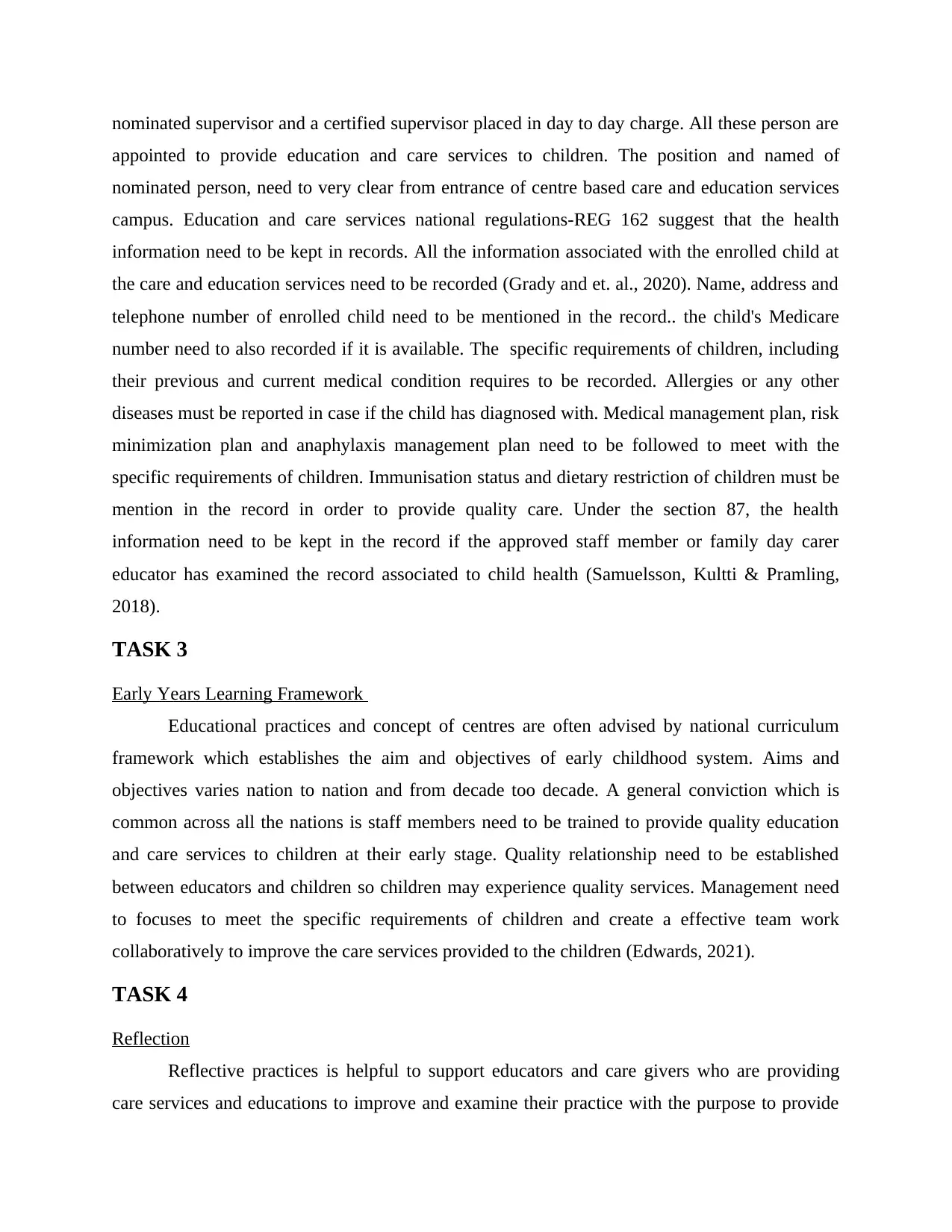
nominated supervisor and a certified supervisor placed in day to day charge. All these person are
appointed to provide education and care services to children. The position and named of
nominated person, need to very clear from entrance of centre based care and education services
campus. Education and care services national regulations-REG 162 suggest that the health
information need to be kept in records. All the information associated with the enrolled child at
the care and education services need to be recorded (Grady and et. al., 2020). Name, address and
telephone number of enrolled child need to be mentioned in the record.. the child's Medicare
number need to also recorded if it is available. The specific requirements of children, including
their previous and current medical condition requires to be recorded. Allergies or any other
diseases must be reported in case if the child has diagnosed with. Medical management plan, risk
minimization plan and anaphylaxis management plan need to be followed to meet with the
specific requirements of children. Immunisation status and dietary restriction of children must be
mention in the record in order to provide quality care. Under the section 87, the health
information need to be kept in the record if the approved staff member or family day carer
educator has examined the record associated to child health (Samuelsson, Kultti & Pramling,
2018).
TASK 3
Early Years Learning Framework
Educational practices and concept of centres are often advised by national curriculum
framework which establishes the aim and objectives of early childhood system. Aims and
objectives varies nation to nation and from decade too decade. A general conviction which is
common across all the nations is staff members need to be trained to provide quality education
and care services to children at their early stage. Quality relationship need to be established
between educators and children so children may experience quality services. Management need
to focuses to meet the specific requirements of children and create a effective team work
collaboratively to improve the care services provided to the children (Edwards, 2021).
TASK 4
Reflection
Reflective practices is helpful to support educators and care givers who are providing
care services and educations to improve and examine their practice with the purpose to provide
appointed to provide education and care services to children. The position and named of
nominated person, need to very clear from entrance of centre based care and education services
campus. Education and care services national regulations-REG 162 suggest that the health
information need to be kept in records. All the information associated with the enrolled child at
the care and education services need to be recorded (Grady and et. al., 2020). Name, address and
telephone number of enrolled child need to be mentioned in the record.. the child's Medicare
number need to also recorded if it is available. The specific requirements of children, including
their previous and current medical condition requires to be recorded. Allergies or any other
diseases must be reported in case if the child has diagnosed with. Medical management plan, risk
minimization plan and anaphylaxis management plan need to be followed to meet with the
specific requirements of children. Immunisation status and dietary restriction of children must be
mention in the record in order to provide quality care. Under the section 87, the health
information need to be kept in the record if the approved staff member or family day carer
educator has examined the record associated to child health (Samuelsson, Kultti & Pramling,
2018).
TASK 3
Early Years Learning Framework
Educational practices and concept of centres are often advised by national curriculum
framework which establishes the aim and objectives of early childhood system. Aims and
objectives varies nation to nation and from decade too decade. A general conviction which is
common across all the nations is staff members need to be trained to provide quality education
and care services to children at their early stage. Quality relationship need to be established
between educators and children so children may experience quality services. Management need
to focuses to meet the specific requirements of children and create a effective team work
collaboratively to improve the care services provided to the children (Edwards, 2021).
TASK 4
Reflection
Reflective practices is helpful to support educators and care givers who are providing
care services and educations to improve and examine their practice with the purpose to provide
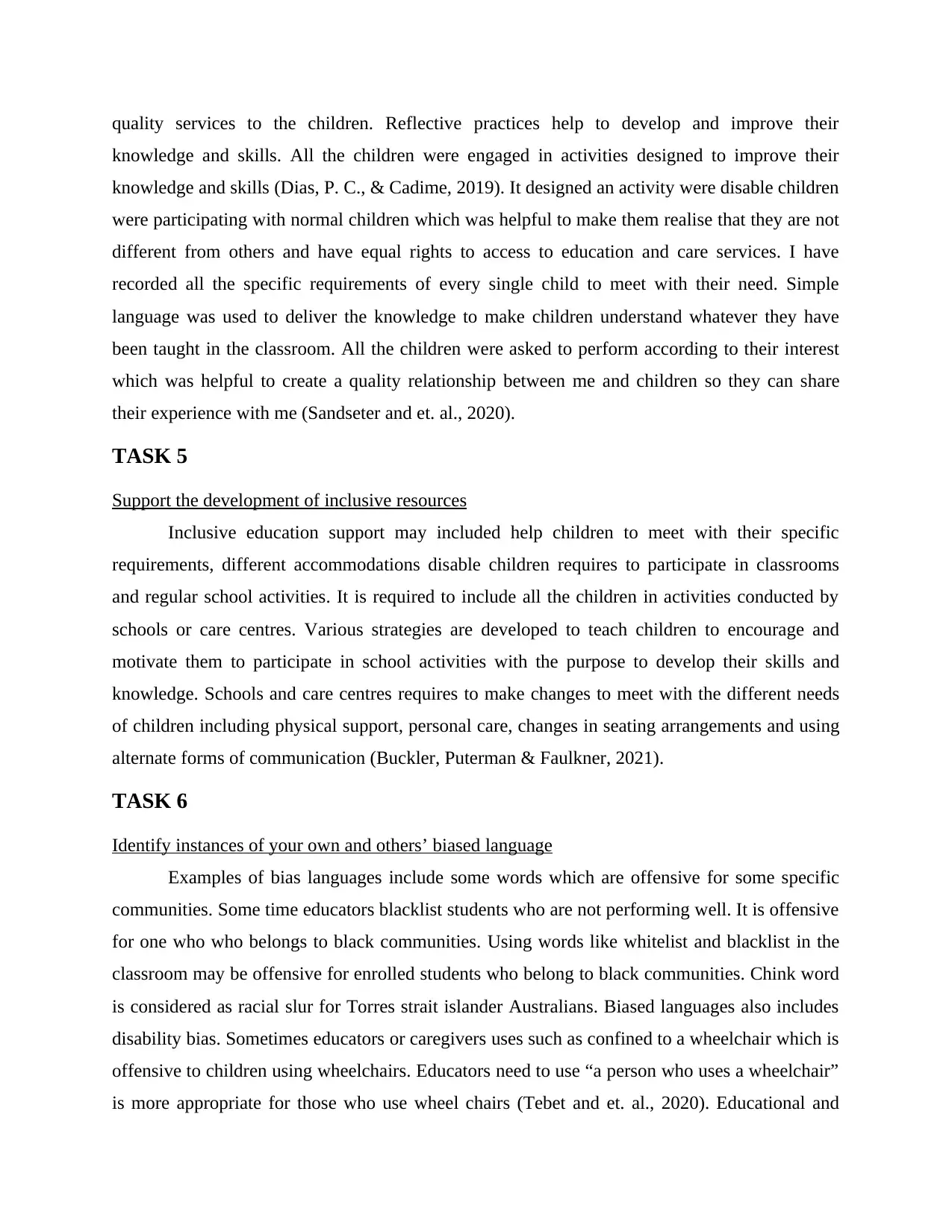
quality services to the children. Reflective practices help to develop and improve their
knowledge and skills. All the children were engaged in activities designed to improve their
knowledge and skills (Dias, P. C., & Cadime, 2019). It designed an activity were disable children
were participating with normal children which was helpful to make them realise that they are not
different from others and have equal rights to access to education and care services. I have
recorded all the specific requirements of every single child to meet with their need. Simple
language was used to deliver the knowledge to make children understand whatever they have
been taught in the classroom. All the children were asked to perform according to their interest
which was helpful to create a quality relationship between me and children so they can share
their experience with me (Sandseter and et. al., 2020).
TASK 5
Support the development of inclusive resources
Inclusive education support may included help children to meet with their specific
requirements, different accommodations disable children requires to participate in classrooms
and regular school activities. It is required to include all the children in activities conducted by
schools or care centres. Various strategies are developed to teach children to encourage and
motivate them to participate in school activities with the purpose to develop their skills and
knowledge. Schools and care centres requires to make changes to meet with the different needs
of children including physical support, personal care, changes in seating arrangements and using
alternate forms of communication (Buckler, Puterman & Faulkner, 2021).
TASK 6
Identify instances of your own and others’ biased language
Examples of bias languages include some words which are offensive for some specific
communities. Some time educators blacklist students who are not performing well. It is offensive
for one who who belongs to black communities. Using words like whitelist and blacklist in the
classroom may be offensive for enrolled students who belong to black communities. Chink word
is considered as racial slur for Torres strait islander Australians. Biased languages also includes
disability bias. Sometimes educators or caregivers uses such as confined to a wheelchair which is
offensive to children using wheelchairs. Educators need to use “a person who uses a wheelchair”
is more appropriate for those who use wheel chairs (Tebet and et. al., 2020). Educational and
knowledge and skills. All the children were engaged in activities designed to improve their
knowledge and skills (Dias, P. C., & Cadime, 2019). It designed an activity were disable children
were participating with normal children which was helpful to make them realise that they are not
different from others and have equal rights to access to education and care services. I have
recorded all the specific requirements of every single child to meet with their need. Simple
language was used to deliver the knowledge to make children understand whatever they have
been taught in the classroom. All the children were asked to perform according to their interest
which was helpful to create a quality relationship between me and children so they can share
their experience with me (Sandseter and et. al., 2020).
TASK 5
Support the development of inclusive resources
Inclusive education support may included help children to meet with their specific
requirements, different accommodations disable children requires to participate in classrooms
and regular school activities. It is required to include all the children in activities conducted by
schools or care centres. Various strategies are developed to teach children to encourage and
motivate them to participate in school activities with the purpose to develop their skills and
knowledge. Schools and care centres requires to make changes to meet with the different needs
of children including physical support, personal care, changes in seating arrangements and using
alternate forms of communication (Buckler, Puterman & Faulkner, 2021).
TASK 6
Identify instances of your own and others’ biased language
Examples of bias languages include some words which are offensive for some specific
communities. Some time educators blacklist students who are not performing well. It is offensive
for one who who belongs to black communities. Using words like whitelist and blacklist in the
classroom may be offensive for enrolled students who belong to black communities. Chink word
is considered as racial slur for Torres strait islander Australians. Biased languages also includes
disability bias. Sometimes educators or caregivers uses such as confined to a wheelchair which is
offensive to children using wheelchairs. Educators need to use “a person who uses a wheelchair”
is more appropriate for those who use wheel chairs (Tebet and et. al., 2020). Educational and
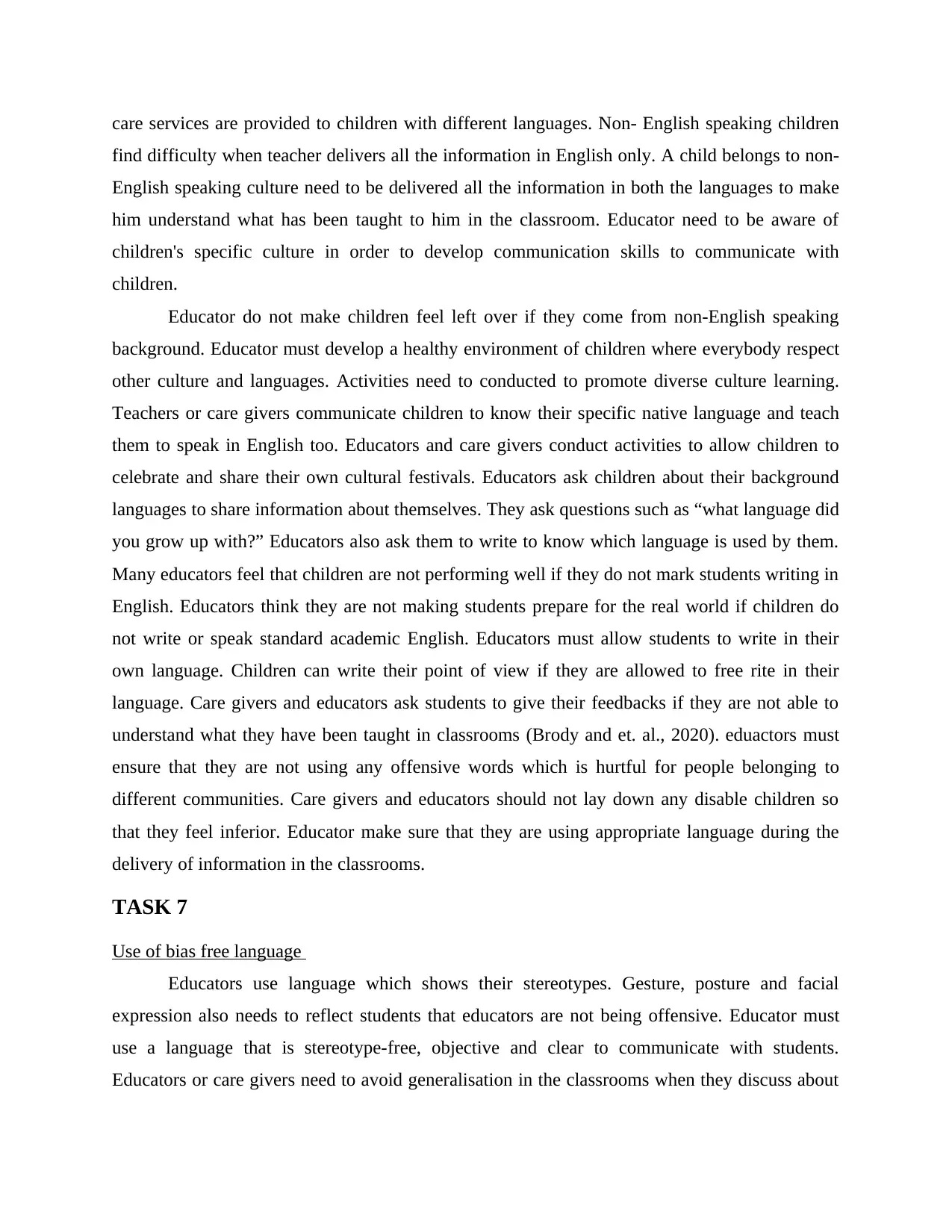
care services are provided to children with different languages. Non- English speaking children
find difficulty when teacher delivers all the information in English only. A child belongs to non-
English speaking culture need to be delivered all the information in both the languages to make
him understand what has been taught to him in the classroom. Educator need to be aware of
children's specific culture in order to develop communication skills to communicate with
children.
Educator do not make children feel left over if they come from non-English speaking
background. Educator must develop a healthy environment of children where everybody respect
other culture and languages. Activities need to conducted to promote diverse culture learning.
Teachers or care givers communicate children to know their specific native language and teach
them to speak in English too. Educators and care givers conduct activities to allow children to
celebrate and share their own cultural festivals. Educators ask children about their background
languages to share information about themselves. They ask questions such as “what language did
you grow up with?” Educators also ask them to write to know which language is used by them.
Many educators feel that children are not performing well if they do not mark students writing in
English. Educators think they are not making students prepare for the real world if children do
not write or speak standard academic English. Educators must allow students to write in their
own language. Children can write their point of view if they are allowed to free rite in their
language. Care givers and educators ask students to give their feedbacks if they are not able to
understand what they have been taught in classrooms (Brody and et. al., 2020). eduactors must
ensure that they are not using any offensive words which is hurtful for people belonging to
different communities. Care givers and educators should not lay down any disable children so
that they feel inferior. Educator make sure that they are using appropriate language during the
delivery of information in the classrooms.
TASK 7
Use of bias free language
Educators use language which shows their stereotypes. Gesture, posture and facial
expression also needs to reflect students that educators are not being offensive. Educator must
use a language that is stereotype-free, objective and clear to communicate with students.
Educators or care givers need to avoid generalisation in the classrooms when they discuss about
find difficulty when teacher delivers all the information in English only. A child belongs to non-
English speaking culture need to be delivered all the information in both the languages to make
him understand what has been taught to him in the classroom. Educator need to be aware of
children's specific culture in order to develop communication skills to communicate with
children.
Educator do not make children feel left over if they come from non-English speaking
background. Educator must develop a healthy environment of children where everybody respect
other culture and languages. Activities need to conducted to promote diverse culture learning.
Teachers or care givers communicate children to know their specific native language and teach
them to speak in English too. Educators and care givers conduct activities to allow children to
celebrate and share their own cultural festivals. Educators ask children about their background
languages to share information about themselves. They ask questions such as “what language did
you grow up with?” Educators also ask them to write to know which language is used by them.
Many educators feel that children are not performing well if they do not mark students writing in
English. Educators think they are not making students prepare for the real world if children do
not write or speak standard academic English. Educators must allow students to write in their
own language. Children can write their point of view if they are allowed to free rite in their
language. Care givers and educators ask students to give their feedbacks if they are not able to
understand what they have been taught in classrooms (Brody and et. al., 2020). eduactors must
ensure that they are not using any offensive words which is hurtful for people belonging to
different communities. Care givers and educators should not lay down any disable children so
that they feel inferior. Educator make sure that they are using appropriate language during the
delivery of information in the classrooms.
TASK 7
Use of bias free language
Educators use language which shows their stereotypes. Gesture, posture and facial
expression also needs to reflect students that educators are not being offensive. Educator must
use a language that is stereotype-free, objective and clear to communicate with students.
Educators or care givers need to avoid generalisation in the classrooms when they discuss about
Paraphrase This Document
Need a fresh take? Get an instant paraphrase of this document with our AI Paraphraser
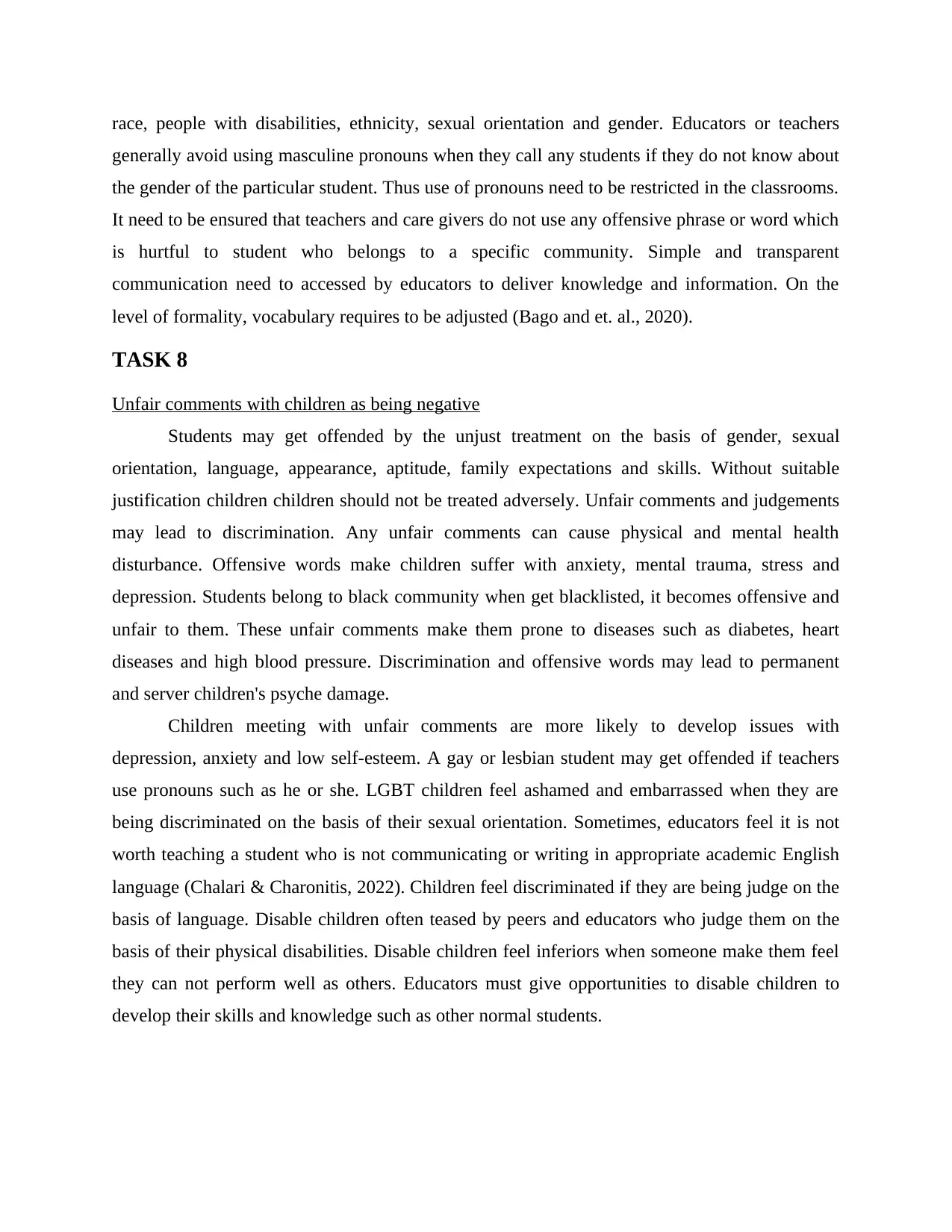
race, people with disabilities, ethnicity, sexual orientation and gender. Educators or teachers
generally avoid using masculine pronouns when they call any students if they do not know about
the gender of the particular student. Thus use of pronouns need to be restricted in the classrooms.
It need to be ensured that teachers and care givers do not use any offensive phrase or word which
is hurtful to student who belongs to a specific community. Simple and transparent
communication need to accessed by educators to deliver knowledge and information. On the
level of formality, vocabulary requires to be adjusted (Bago and et. al., 2020).
TASK 8
Unfair comments with children as being negative
Students may get offended by the unjust treatment on the basis of gender, sexual
orientation, language, appearance, aptitude, family expectations and skills. Without suitable
justification children children should not be treated adversely. Unfair comments and judgements
may lead to discrimination. Any unfair comments can cause physical and mental health
disturbance. Offensive words make children suffer with anxiety, mental trauma, stress and
depression. Students belong to black community when get blacklisted, it becomes offensive and
unfair to them. These unfair comments make them prone to diseases such as diabetes, heart
diseases and high blood pressure. Discrimination and offensive words may lead to permanent
and server children's psyche damage.
Children meeting with unfair comments are more likely to develop issues with
depression, anxiety and low self-esteem. A gay or lesbian student may get offended if teachers
use pronouns such as he or she. LGBT children feel ashamed and embarrassed when they are
being discriminated on the basis of their sexual orientation. Sometimes, educators feel it is not
worth teaching a student who is not communicating or writing in appropriate academic English
language (Chalari & Charonitis, 2022). Children feel discriminated if they are being judge on the
basis of language. Disable children often teased by peers and educators who judge them on the
basis of their physical disabilities. Disable children feel inferiors when someone make them feel
they can not perform well as others. Educators must give opportunities to disable children to
develop their skills and knowledge such as other normal students.
generally avoid using masculine pronouns when they call any students if they do not know about
the gender of the particular student. Thus use of pronouns need to be restricted in the classrooms.
It need to be ensured that teachers and care givers do not use any offensive phrase or word which
is hurtful to student who belongs to a specific community. Simple and transparent
communication need to accessed by educators to deliver knowledge and information. On the
level of formality, vocabulary requires to be adjusted (Bago and et. al., 2020).
TASK 8
Unfair comments with children as being negative
Students may get offended by the unjust treatment on the basis of gender, sexual
orientation, language, appearance, aptitude, family expectations and skills. Without suitable
justification children children should not be treated adversely. Unfair comments and judgements
may lead to discrimination. Any unfair comments can cause physical and mental health
disturbance. Offensive words make children suffer with anxiety, mental trauma, stress and
depression. Students belong to black community when get blacklisted, it becomes offensive and
unfair to them. These unfair comments make them prone to diseases such as diabetes, heart
diseases and high blood pressure. Discrimination and offensive words may lead to permanent
and server children's psyche damage.
Children meeting with unfair comments are more likely to develop issues with
depression, anxiety and low self-esteem. A gay or lesbian student may get offended if teachers
use pronouns such as he or she. LGBT children feel ashamed and embarrassed when they are
being discriminated on the basis of their sexual orientation. Sometimes, educators feel it is not
worth teaching a student who is not communicating or writing in appropriate academic English
language (Chalari & Charonitis, 2022). Children feel discriminated if they are being judge on the
basis of language. Disable children often teased by peers and educators who judge them on the
basis of their physical disabilities. Disable children feel inferiors when someone make them feel
they can not perform well as others. Educators must give opportunities to disable children to
develop their skills and knowledge such as other normal students.
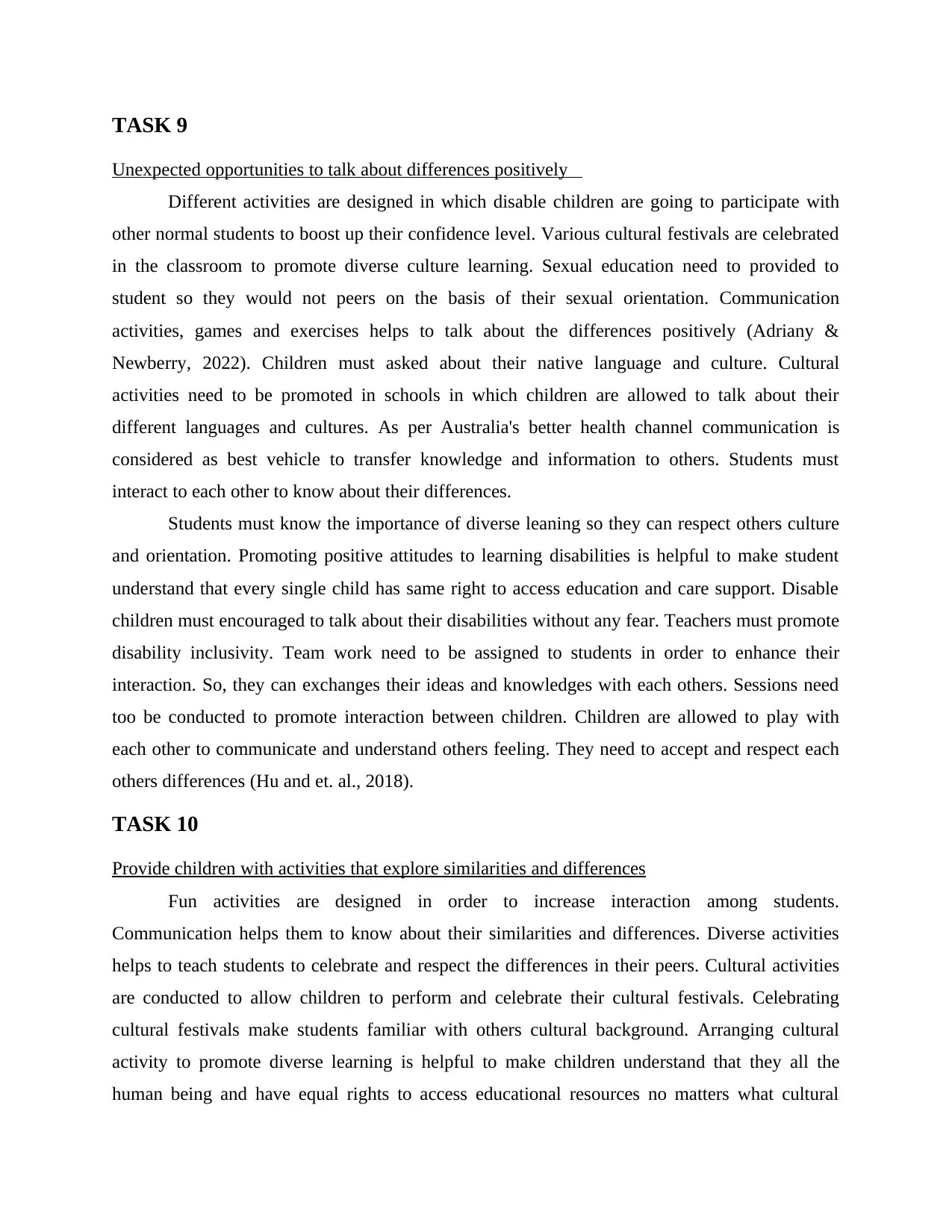
TASK 9
Unexpected opportunities to talk about differences positively
Different activities are designed in which disable children are going to participate with
other normal students to boost up their confidence level. Various cultural festivals are celebrated
in the classroom to promote diverse culture learning. Sexual education need to provided to
student so they would not peers on the basis of their sexual orientation. Communication
activities, games and exercises helps to talk about the differences positively (Adriany &
Newberry, 2022). Children must asked about their native language and culture. Cultural
activities need to be promoted in schools in which children are allowed to talk about their
different languages and cultures. As per Australia's better health channel communication is
considered as best vehicle to transfer knowledge and information to others. Students must
interact to each other to know about their differences.
Students must know the importance of diverse leaning so they can respect others culture
and orientation. Promoting positive attitudes to learning disabilities is helpful to make student
understand that every single child has same right to access education and care support. Disable
children must encouraged to talk about their disabilities without any fear. Teachers must promote
disability inclusivity. Team work need to be assigned to students in order to enhance their
interaction. So, they can exchanges their ideas and knowledges with each others. Sessions need
too be conducted to promote interaction between children. Children are allowed to play with
each other to communicate and understand others feeling. They need to accept and respect each
others differences (Hu and et. al., 2018).
TASK 10
Provide children with activities that explore similarities and differences
Fun activities are designed in order to increase interaction among students.
Communication helps them to know about their similarities and differences. Diverse activities
helps to teach students to celebrate and respect the differences in their peers. Cultural activities
are conducted to allow children to perform and celebrate their cultural festivals. Celebrating
cultural festivals make students familiar with others cultural background. Arranging cultural
activity to promote diverse learning is helpful to make children understand that they all the
human being and have equal rights to access educational resources no matters what cultural
Unexpected opportunities to talk about differences positively
Different activities are designed in which disable children are going to participate with
other normal students to boost up their confidence level. Various cultural festivals are celebrated
in the classroom to promote diverse culture learning. Sexual education need to provided to
student so they would not peers on the basis of their sexual orientation. Communication
activities, games and exercises helps to talk about the differences positively (Adriany &
Newberry, 2022). Children must asked about their native language and culture. Cultural
activities need to be promoted in schools in which children are allowed to talk about their
different languages and cultures. As per Australia's better health channel communication is
considered as best vehicle to transfer knowledge and information to others. Students must
interact to each other to know about their differences.
Students must know the importance of diverse leaning so they can respect others culture
and orientation. Promoting positive attitudes to learning disabilities is helpful to make student
understand that every single child has same right to access education and care support. Disable
children must encouraged to talk about their disabilities without any fear. Teachers must promote
disability inclusivity. Team work need to be assigned to students in order to enhance their
interaction. So, they can exchanges their ideas and knowledges with each others. Sessions need
too be conducted to promote interaction between children. Children are allowed to play with
each other to communicate and understand others feeling. They need to accept and respect each
others differences (Hu and et. al., 2018).
TASK 10
Provide children with activities that explore similarities and differences
Fun activities are designed in order to increase interaction among students.
Communication helps them to know about their similarities and differences. Diverse activities
helps to teach students to celebrate and respect the differences in their peers. Cultural activities
are conducted to allow children to perform and celebrate their cultural festivals. Celebrating
cultural festivals make students familiar with others cultural background. Arranging cultural
activity to promote diverse learning is helpful to make children understand that they all the
human being and have equal rights to access educational resources no matters what cultural
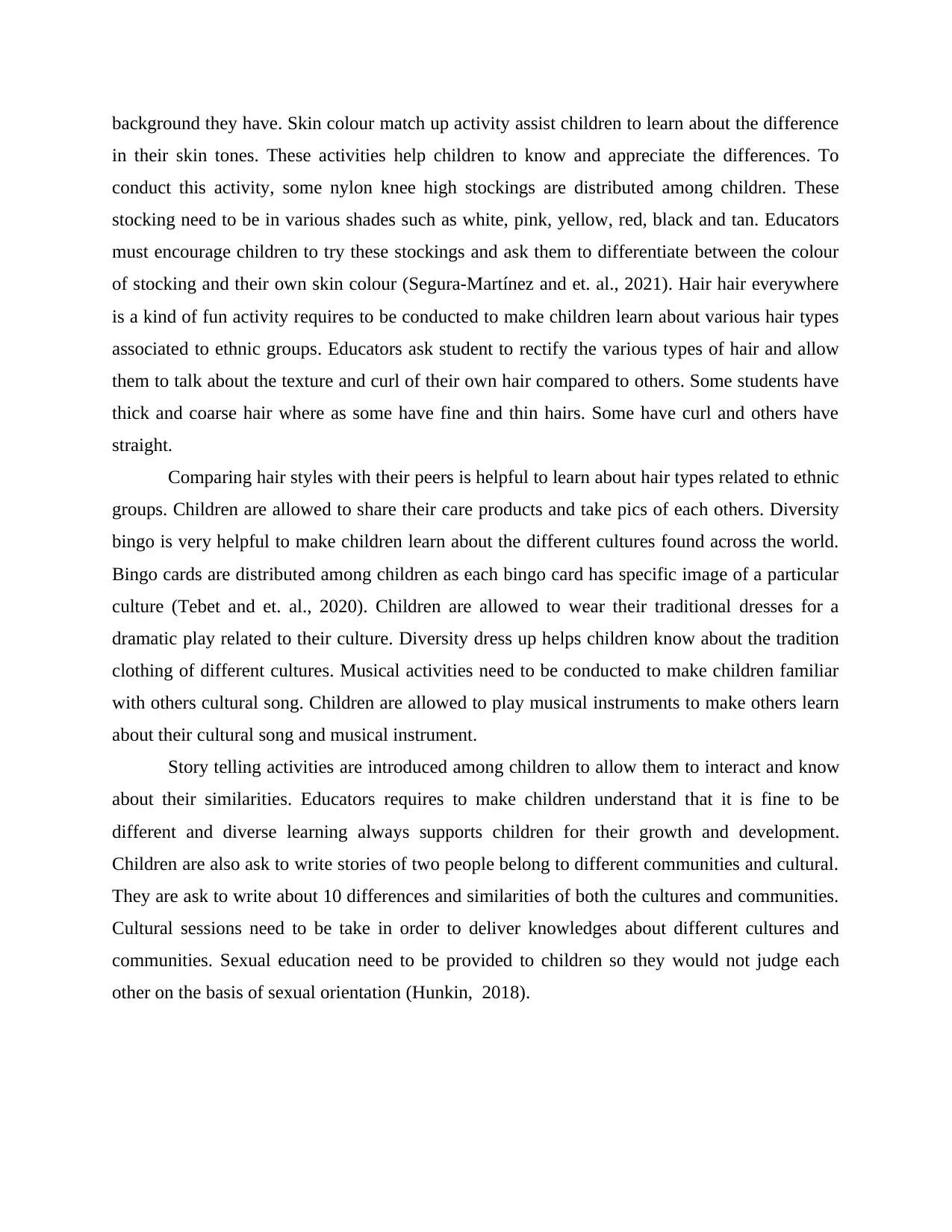
background they have. Skin colour match up activity assist children to learn about the difference
in their skin tones. These activities help children to know and appreciate the differences. To
conduct this activity, some nylon knee high stockings are distributed among children. These
stocking need to be in various shades such as white, pink, yellow, red, black and tan. Educators
must encourage children to try these stockings and ask them to differentiate between the colour
of stocking and their own skin colour (Segura-Martínez and et. al., 2021). Hair hair everywhere
is a kind of fun activity requires to be conducted to make children learn about various hair types
associated to ethnic groups. Educators ask student to rectify the various types of hair and allow
them to talk about the texture and curl of their own hair compared to others. Some students have
thick and coarse hair where as some have fine and thin hairs. Some have curl and others have
straight.
Comparing hair styles with their peers is helpful to learn about hair types related to ethnic
groups. Children are allowed to share their care products and take pics of each others. Diversity
bingo is very helpful to make children learn about the different cultures found across the world.
Bingo cards are distributed among children as each bingo card has specific image of a particular
culture (Tebet and et. al., 2020). Children are allowed to wear their traditional dresses for a
dramatic play related to their culture. Diversity dress up helps children know about the tradition
clothing of different cultures. Musical activities need to be conducted to make children familiar
with others cultural song. Children are allowed to play musical instruments to make others learn
about their cultural song and musical instrument.
Story telling activities are introduced among children to allow them to interact and know
about their similarities. Educators requires to make children understand that it is fine to be
different and diverse learning always supports children for their growth and development.
Children are also ask to write stories of two people belong to different communities and cultural.
They are ask to write about 10 differences and similarities of both the cultures and communities.
Cultural sessions need to be take in order to deliver knowledges about different cultures and
communities. Sexual education need to be provided to children so they would not judge each
other on the basis of sexual orientation (Hunkin, 2018).
in their skin tones. These activities help children to know and appreciate the differences. To
conduct this activity, some nylon knee high stockings are distributed among children. These
stocking need to be in various shades such as white, pink, yellow, red, black and tan. Educators
must encourage children to try these stockings and ask them to differentiate between the colour
of stocking and their own skin colour (Segura-Martínez and et. al., 2021). Hair hair everywhere
is a kind of fun activity requires to be conducted to make children learn about various hair types
associated to ethnic groups. Educators ask student to rectify the various types of hair and allow
them to talk about the texture and curl of their own hair compared to others. Some students have
thick and coarse hair where as some have fine and thin hairs. Some have curl and others have
straight.
Comparing hair styles with their peers is helpful to learn about hair types related to ethnic
groups. Children are allowed to share their care products and take pics of each others. Diversity
bingo is very helpful to make children learn about the different cultures found across the world.
Bingo cards are distributed among children as each bingo card has specific image of a particular
culture (Tebet and et. al., 2020). Children are allowed to wear their traditional dresses for a
dramatic play related to their culture. Diversity dress up helps children know about the tradition
clothing of different cultures. Musical activities need to be conducted to make children familiar
with others cultural song. Children are allowed to play musical instruments to make others learn
about their cultural song and musical instrument.
Story telling activities are introduced among children to allow them to interact and know
about their similarities. Educators requires to make children understand that it is fine to be
different and diverse learning always supports children for their growth and development.
Children are also ask to write stories of two people belong to different communities and cultural.
They are ask to write about 10 differences and similarities of both the cultures and communities.
Cultural sessions need to be take in order to deliver knowledges about different cultures and
communities. Sexual education need to be provided to children so they would not judge each
other on the basis of sexual orientation (Hunkin, 2018).
Secure Best Marks with AI Grader
Need help grading? Try our AI Grader for instant feedback on your assignments.
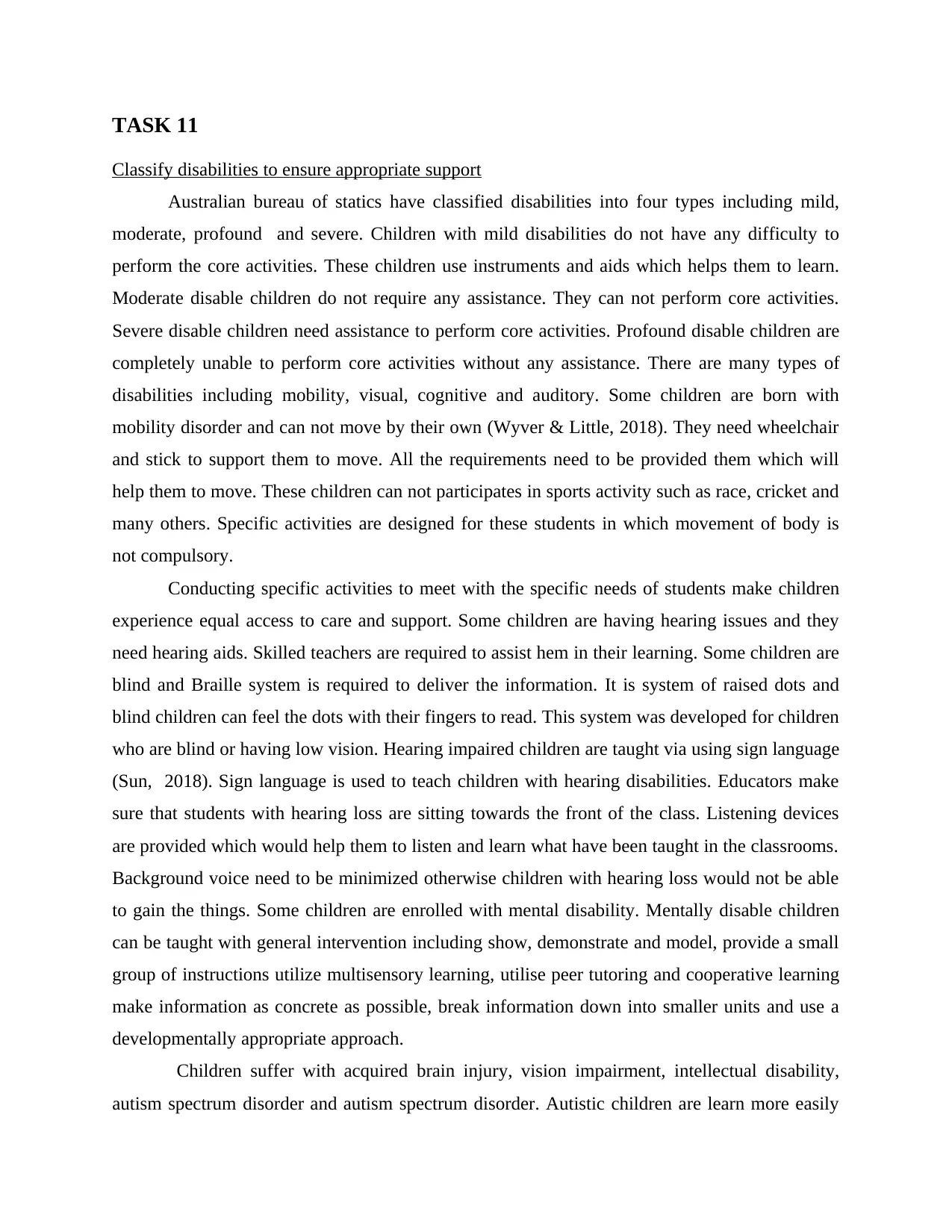
TASK 11
Classify disabilities to ensure appropriate support
Australian bureau of statics have classified disabilities into four types including mild,
moderate, profound and severe. Children with mild disabilities do not have any difficulty to
perform the core activities. These children use instruments and aids which helps them to learn.
Moderate disable children do not require any assistance. They can not perform core activities.
Severe disable children need assistance to perform core activities. Profound disable children are
completely unable to perform core activities without any assistance. There are many types of
disabilities including mobility, visual, cognitive and auditory. Some children are born with
mobility disorder and can not move by their own (Wyver & Little, 2018). They need wheelchair
and stick to support them to move. All the requirements need to be provided them which will
help them to move. These children can not participates in sports activity such as race, cricket and
many others. Specific activities are designed for these students in which movement of body is
not compulsory.
Conducting specific activities to meet with the specific needs of students make children
experience equal access to care and support. Some children are having hearing issues and they
need hearing aids. Skilled teachers are required to assist hem in their learning. Some children are
blind and Braille system is required to deliver the information. It is system of raised dots and
blind children can feel the dots with their fingers to read. This system was developed for children
who are blind or having low vision. Hearing impaired children are taught via using sign language
(Sun, 2018). Sign language is used to teach children with hearing disabilities. Educators make
sure that students with hearing loss are sitting towards the front of the class. Listening devices
are provided which would help them to listen and learn what have been taught in the classrooms.
Background voice need to be minimized otherwise children with hearing loss would not be able
to gain the things. Some children are enrolled with mental disability. Mentally disable children
can be taught with general intervention including show, demonstrate and model, provide a small
group of instructions utilize multisensory learning, utilise peer tutoring and cooperative learning
make information as concrete as possible, break information down into smaller units and use a
developmentally appropriate approach.
Children suffer with acquired brain injury, vision impairment, intellectual disability,
autism spectrum disorder and autism spectrum disorder. Autistic children are learn more easily
Classify disabilities to ensure appropriate support
Australian bureau of statics have classified disabilities into four types including mild,
moderate, profound and severe. Children with mild disabilities do not have any difficulty to
perform the core activities. These children use instruments and aids which helps them to learn.
Moderate disable children do not require any assistance. They can not perform core activities.
Severe disable children need assistance to perform core activities. Profound disable children are
completely unable to perform core activities without any assistance. There are many types of
disabilities including mobility, visual, cognitive and auditory. Some children are born with
mobility disorder and can not move by their own (Wyver & Little, 2018). They need wheelchair
and stick to support them to move. All the requirements need to be provided them which will
help them to move. These children can not participates in sports activity such as race, cricket and
many others. Specific activities are designed for these students in which movement of body is
not compulsory.
Conducting specific activities to meet with the specific needs of students make children
experience equal access to care and support. Some children are having hearing issues and they
need hearing aids. Skilled teachers are required to assist hem in their learning. Some children are
blind and Braille system is required to deliver the information. It is system of raised dots and
blind children can feel the dots with their fingers to read. This system was developed for children
who are blind or having low vision. Hearing impaired children are taught via using sign language
(Sun, 2018). Sign language is used to teach children with hearing disabilities. Educators make
sure that students with hearing loss are sitting towards the front of the class. Listening devices
are provided which would help them to listen and learn what have been taught in the classrooms.
Background voice need to be minimized otherwise children with hearing loss would not be able
to gain the things. Some children are enrolled with mental disability. Mentally disable children
can be taught with general intervention including show, demonstrate and model, provide a small
group of instructions utilize multisensory learning, utilise peer tutoring and cooperative learning
make information as concrete as possible, break information down into smaller units and use a
developmentally appropriate approach.
Children suffer with acquired brain injury, vision impairment, intellectual disability,
autism spectrum disorder and autism spectrum disorder. Autistic children are learn more easily
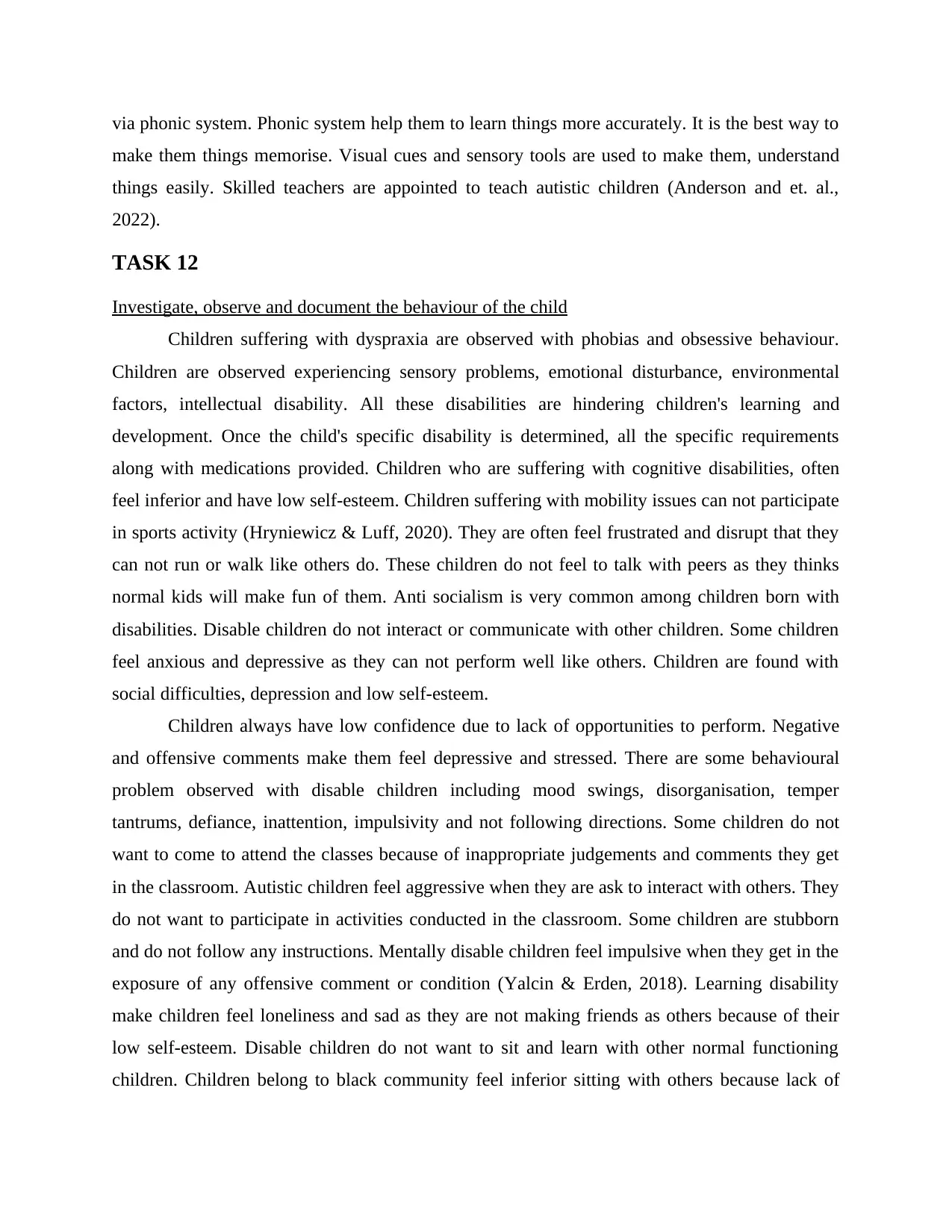
via phonic system. Phonic system help them to learn things more accurately. It is the best way to
make them things memorise. Visual cues and sensory tools are used to make them, understand
things easily. Skilled teachers are appointed to teach autistic children (Anderson and et. al.,
2022).
TASK 12
Investigate, observe and document the behaviour of the child
Children suffering with dyspraxia are observed with phobias and obsessive behaviour.
Children are observed experiencing sensory problems, emotional disturbance, environmental
factors, intellectual disability. All these disabilities are hindering children's learning and
development. Once the child's specific disability is determined, all the specific requirements
along with medications provided. Children who are suffering with cognitive disabilities, often
feel inferior and have low self-esteem. Children suffering with mobility issues can not participate
in sports activity (Hryniewicz & Luff, 2020). They are often feel frustrated and disrupt that they
can not run or walk like others do. These children do not feel to talk with peers as they thinks
normal kids will make fun of them. Anti socialism is very common among children born with
disabilities. Disable children do not interact or communicate with other children. Some children
feel anxious and depressive as they can not perform well like others. Children are found with
social difficulties, depression and low self-esteem.
Children always have low confidence due to lack of opportunities to perform. Negative
and offensive comments make them feel depressive and stressed. There are some behavioural
problem observed with disable children including mood swings, disorganisation, temper
tantrums, defiance, inattention, impulsivity and not following directions. Some children do not
want to come to attend the classes because of inappropriate judgements and comments they get
in the classroom. Autistic children feel aggressive when they are ask to interact with others. They
do not want to participate in activities conducted in the classroom. Some children are stubborn
and do not follow any instructions. Mentally disable children feel impulsive when they get in the
exposure of any offensive comment or condition (Yalcin & Erden, 2018). Learning disability
make children feel loneliness and sad as they are not making friends as others because of their
low self-esteem. Disable children do not want to sit and learn with other normal functioning
children. Children belong to black community feel inferior sitting with others because lack of
make them things memorise. Visual cues and sensory tools are used to make them, understand
things easily. Skilled teachers are appointed to teach autistic children (Anderson and et. al.,
2022).
TASK 12
Investigate, observe and document the behaviour of the child
Children suffering with dyspraxia are observed with phobias and obsessive behaviour.
Children are observed experiencing sensory problems, emotional disturbance, environmental
factors, intellectual disability. All these disabilities are hindering children's learning and
development. Once the child's specific disability is determined, all the specific requirements
along with medications provided. Children who are suffering with cognitive disabilities, often
feel inferior and have low self-esteem. Children suffering with mobility issues can not participate
in sports activity (Hryniewicz & Luff, 2020). They are often feel frustrated and disrupt that they
can not run or walk like others do. These children do not feel to talk with peers as they thinks
normal kids will make fun of them. Anti socialism is very common among children born with
disabilities. Disable children do not interact or communicate with other children. Some children
feel anxious and depressive as they can not perform well like others. Children are found with
social difficulties, depression and low self-esteem.
Children always have low confidence due to lack of opportunities to perform. Negative
and offensive comments make them feel depressive and stressed. There are some behavioural
problem observed with disable children including mood swings, disorganisation, temper
tantrums, defiance, inattention, impulsivity and not following directions. Some children do not
want to come to attend the classes because of inappropriate judgements and comments they get
in the classroom. Autistic children feel aggressive when they are ask to interact with others. They
do not want to participate in activities conducted in the classroom. Some children are stubborn
and do not follow any instructions. Mentally disable children feel impulsive when they get in the
exposure of any offensive comment or condition (Yalcin & Erden, 2018). Learning disability
make children feel loneliness and sad as they are not making friends as others because of their
low self-esteem. Disable children do not want to sit and learn with other normal functioning
children. Children belong to black community feel inferior sitting with others because lack of
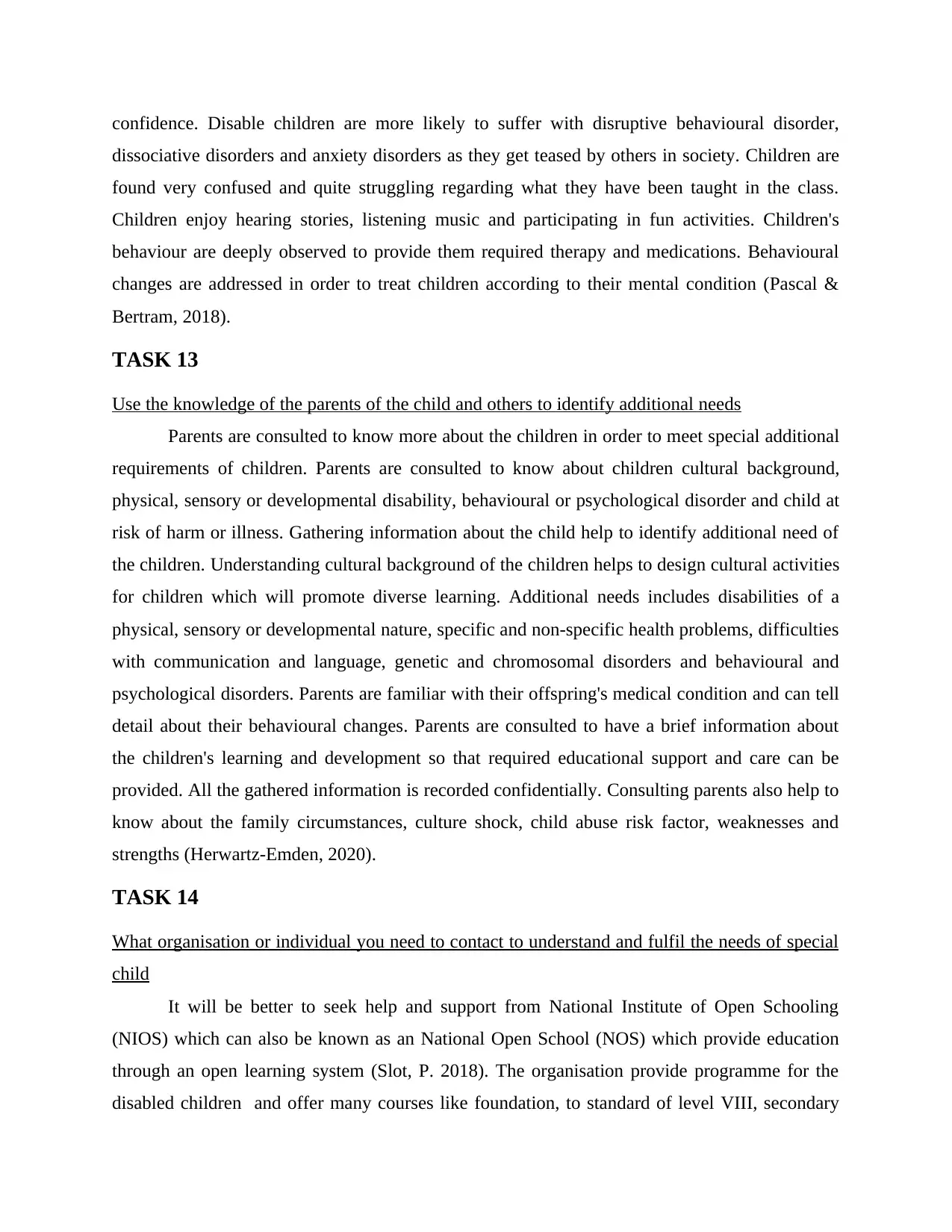
confidence. Disable children are more likely to suffer with disruptive behavioural disorder,
dissociative disorders and anxiety disorders as they get teased by others in society. Children are
found very confused and quite struggling regarding what they have been taught in the class.
Children enjoy hearing stories, listening music and participating in fun activities. Children's
behaviour are deeply observed to provide them required therapy and medications. Behavioural
changes are addressed in order to treat children according to their mental condition (Pascal &
Bertram, 2018).
TASK 13
Use the knowledge of the parents of the child and others to identify additional needs
Parents are consulted to know more about the children in order to meet special additional
requirements of children. Parents are consulted to know about children cultural background,
physical, sensory or developmental disability, behavioural or psychological disorder and child at
risk of harm or illness. Gathering information about the child help to identify additional need of
the children. Understanding cultural background of the children helps to design cultural activities
for children which will promote diverse learning. Additional needs includes disabilities of a
physical, sensory or developmental nature, specific and non-specific health problems, difficulties
with communication and language, genetic and chromosomal disorders and behavioural and
psychological disorders. Parents are familiar with their offspring's medical condition and can tell
detail about their behavioural changes. Parents are consulted to have a brief information about
the children's learning and development so that required educational support and care can be
provided. All the gathered information is recorded confidentially. Consulting parents also help to
know about the family circumstances, culture shock, child abuse risk factor, weaknesses and
strengths (Herwartz-Emden, 2020).
TASK 14
What organisation or individual you need to contact to understand and fulfil the needs of special
child
It will be better to seek help and support from National Institute of Open Schooling
(NIOS) which can also be known as an National Open School (NOS) which provide education
through an open learning system (Slot, P. 2018). The organisation provide programme for the
disabled children and offer many courses like foundation, to standard of level VIII, secondary
dissociative disorders and anxiety disorders as they get teased by others in society. Children are
found very confused and quite struggling regarding what they have been taught in the class.
Children enjoy hearing stories, listening music and participating in fun activities. Children's
behaviour are deeply observed to provide them required therapy and medications. Behavioural
changes are addressed in order to treat children according to their mental condition (Pascal &
Bertram, 2018).
TASK 13
Use the knowledge of the parents of the child and others to identify additional needs
Parents are consulted to know more about the children in order to meet special additional
requirements of children. Parents are consulted to know about children cultural background,
physical, sensory or developmental disability, behavioural or psychological disorder and child at
risk of harm or illness. Gathering information about the child help to identify additional need of
the children. Understanding cultural background of the children helps to design cultural activities
for children which will promote diverse learning. Additional needs includes disabilities of a
physical, sensory or developmental nature, specific and non-specific health problems, difficulties
with communication and language, genetic and chromosomal disorders and behavioural and
psychological disorders. Parents are familiar with their offspring's medical condition and can tell
detail about their behavioural changes. Parents are consulted to have a brief information about
the children's learning and development so that required educational support and care can be
provided. All the gathered information is recorded confidentially. Consulting parents also help to
know about the family circumstances, culture shock, child abuse risk factor, weaknesses and
strengths (Herwartz-Emden, 2020).
TASK 14
What organisation or individual you need to contact to understand and fulfil the needs of special
child
It will be better to seek help and support from National Institute of Open Schooling
(NIOS) which can also be known as an National Open School (NOS) which provide education
through an open learning system (Slot, P. 2018). The organisation provide programme for the
disabled children and offer many courses like foundation, to standard of level VIII, secondary
Paraphrase This Document
Need a fresh take? Get an instant paraphrase of this document with our AI Paraphraser
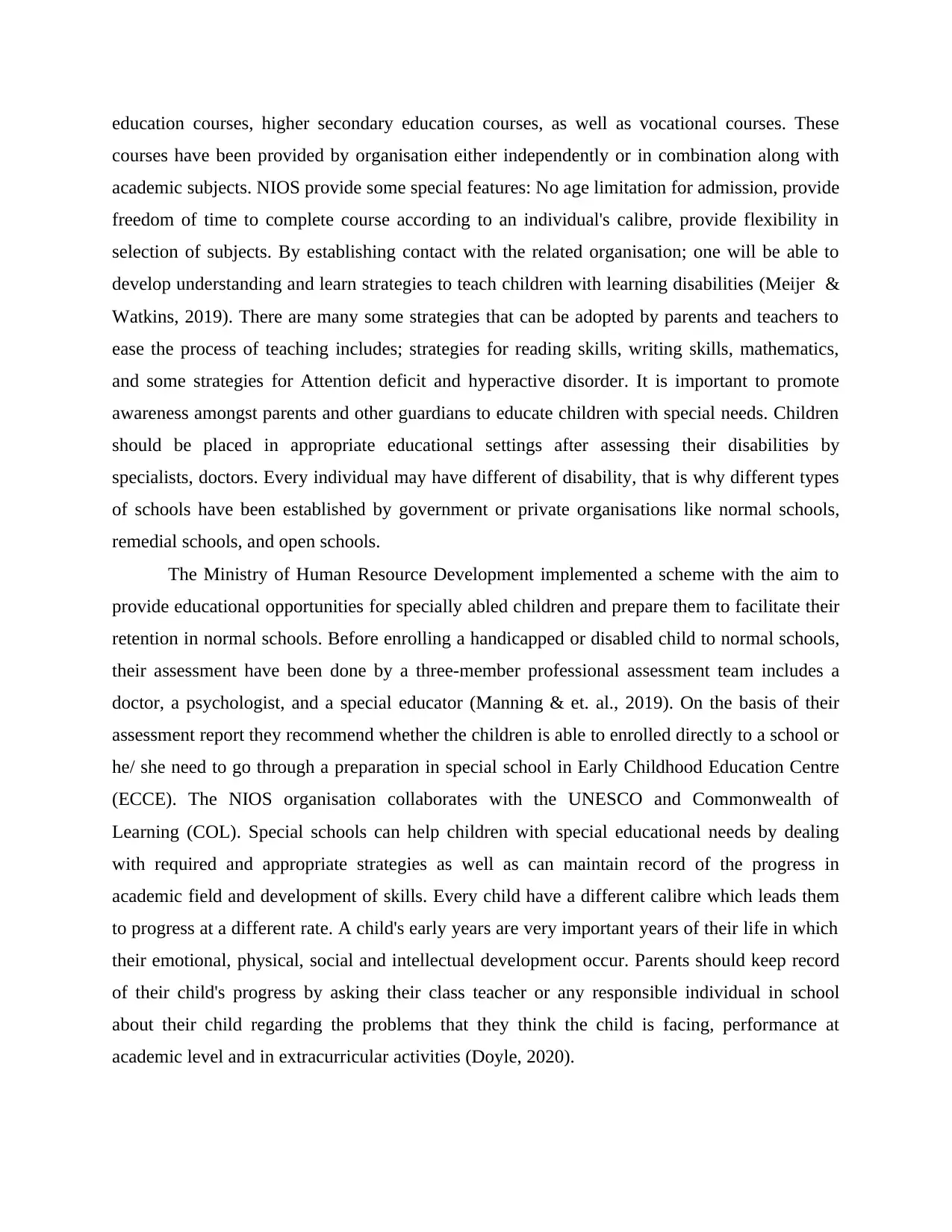
education courses, higher secondary education courses, as well as vocational courses. These
courses have been provided by organisation either independently or in combination along with
academic subjects. NIOS provide some special features: No age limitation for admission, provide
freedom of time to complete course according to an individual's calibre, provide flexibility in
selection of subjects. By establishing contact with the related organisation; one will be able to
develop understanding and learn strategies to teach children with learning disabilities (Meijer &
Watkins, 2019). There are many some strategies that can be adopted by parents and teachers to
ease the process of teaching includes; strategies for reading skills, writing skills, mathematics,
and some strategies for Attention deficit and hyperactive disorder. It is important to promote
awareness amongst parents and other guardians to educate children with special needs. Children
should be placed in appropriate educational settings after assessing their disabilities by
specialists, doctors. Every individual may have different of disability, that is why different types
of schools have been established by government or private organisations like normal schools,
remedial schools, and open schools.
The Ministry of Human Resource Development implemented a scheme with the aim to
provide educational opportunities for specially abled children and prepare them to facilitate their
retention in normal schools. Before enrolling a handicapped or disabled child to normal schools,
their assessment have been done by a three-member professional assessment team includes a
doctor, a psychologist, and a special educator (Manning & et. al., 2019). On the basis of their
assessment report they recommend whether the children is able to enrolled directly to a school or
he/ she need to go through a preparation in special school in Early Childhood Education Centre
(ECCE). The NIOS organisation collaborates with the UNESCO and Commonwealth of
Learning (COL). Special schools can help children with special educational needs by dealing
with required and appropriate strategies as well as can maintain record of the progress in
academic field and development of skills. Every child have a different calibre which leads them
to progress at a different rate. A child's early years are very important years of their life in which
their emotional, physical, social and intellectual development occur. Parents should keep record
of their child's progress by asking their class teacher or any responsible individual in school
about their child regarding the problems that they think the child is facing, performance at
academic level and in extracurricular activities (Doyle, 2020).
courses have been provided by organisation either independently or in combination along with
academic subjects. NIOS provide some special features: No age limitation for admission, provide
freedom of time to complete course according to an individual's calibre, provide flexibility in
selection of subjects. By establishing contact with the related organisation; one will be able to
develop understanding and learn strategies to teach children with learning disabilities (Meijer &
Watkins, 2019). There are many some strategies that can be adopted by parents and teachers to
ease the process of teaching includes; strategies for reading skills, writing skills, mathematics,
and some strategies for Attention deficit and hyperactive disorder. It is important to promote
awareness amongst parents and other guardians to educate children with special needs. Children
should be placed in appropriate educational settings after assessing their disabilities by
specialists, doctors. Every individual may have different of disability, that is why different types
of schools have been established by government or private organisations like normal schools,
remedial schools, and open schools.
The Ministry of Human Resource Development implemented a scheme with the aim to
provide educational opportunities for specially abled children and prepare them to facilitate their
retention in normal schools. Before enrolling a handicapped or disabled child to normal schools,
their assessment have been done by a three-member professional assessment team includes a
doctor, a psychologist, and a special educator (Manning & et. al., 2019). On the basis of their
assessment report they recommend whether the children is able to enrolled directly to a school or
he/ she need to go through a preparation in special school in Early Childhood Education Centre
(ECCE). The NIOS organisation collaborates with the UNESCO and Commonwealth of
Learning (COL). Special schools can help children with special educational needs by dealing
with required and appropriate strategies as well as can maintain record of the progress in
academic field and development of skills. Every child have a different calibre which leads them
to progress at a different rate. A child's early years are very important years of their life in which
their emotional, physical, social and intellectual development occur. Parents should keep record
of their child's progress by asking their class teacher or any responsible individual in school
about their child regarding the problems that they think the child is facing, performance at
academic level and in extracurricular activities (Doyle, 2020).
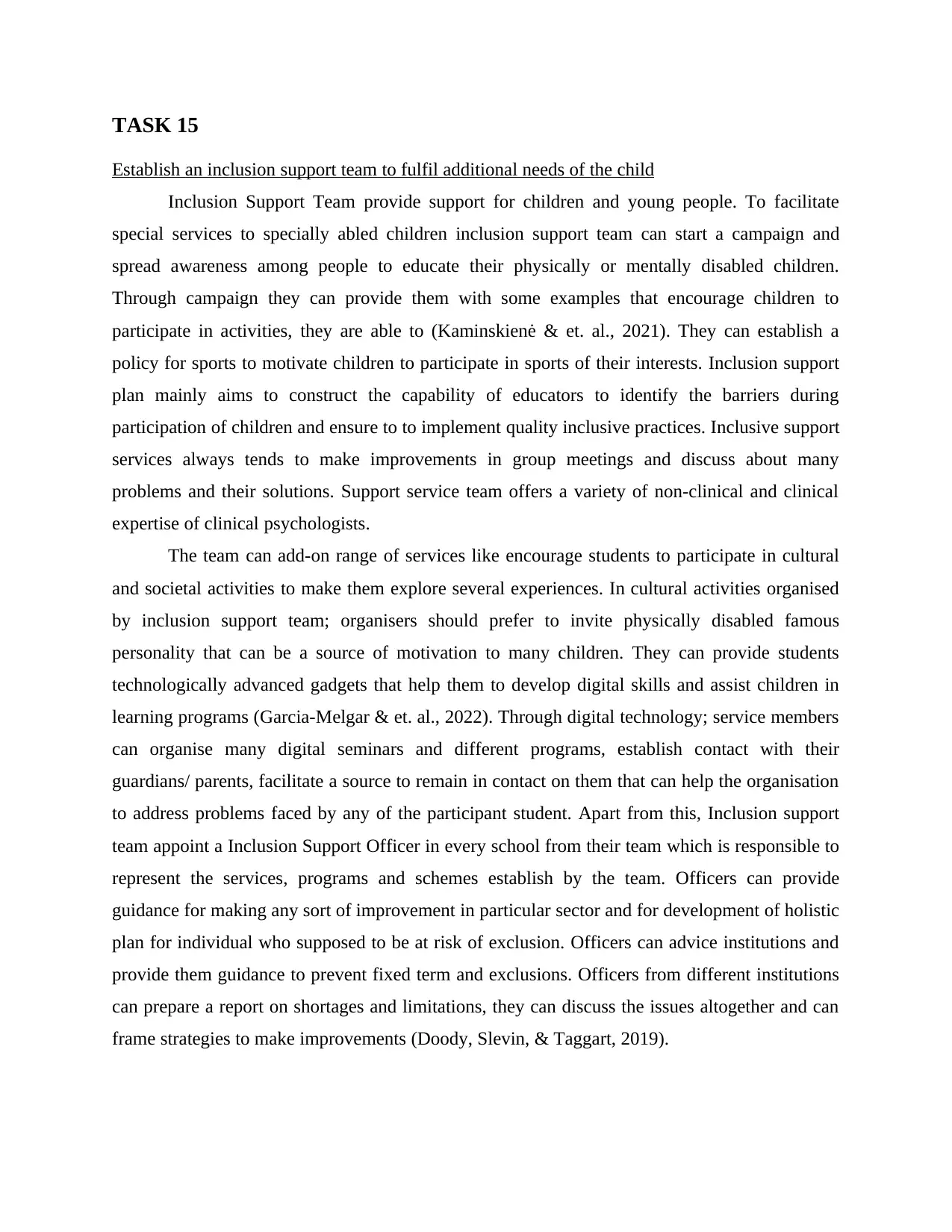
TASK 15
Establish an inclusion support team to fulfil additional needs of the child
Inclusion Support Team provide support for children and young people. To facilitate
special services to specially abled children inclusion support team can start a campaign and
spread awareness among people to educate their physically or mentally disabled children.
Through campaign they can provide them with some examples that encourage children to
participate in activities, they are able to (Kaminskienė & et. al., 2021). They can establish a
policy for sports to motivate children to participate in sports of their interests. Inclusion support
plan mainly aims to construct the capability of educators to identify the barriers during
participation of children and ensure to to implement quality inclusive practices. Inclusive support
services always tends to make improvements in group meetings and discuss about many
problems and their solutions. Support service team offers a variety of non-clinical and clinical
expertise of clinical psychologists.
The team can add-on range of services like encourage students to participate in cultural
and societal activities to make them explore several experiences. In cultural activities organised
by inclusion support team; organisers should prefer to invite physically disabled famous
personality that can be a source of motivation to many children. They can provide students
technologically advanced gadgets that help them to develop digital skills and assist children in
learning programs (Garcia-Melgar & et. al., 2022). Through digital technology; service members
can organise many digital seminars and different programs, establish contact with their
guardians/ parents, facilitate a source to remain in contact on them that can help the organisation
to address problems faced by any of the participant student. Apart from this, Inclusion support
team appoint a Inclusion Support Officer in every school from their team which is responsible to
represent the services, programs and schemes establish by the team. Officers can provide
guidance for making any sort of improvement in particular sector and for development of holistic
plan for individual who supposed to be at risk of exclusion. Officers can advice institutions and
provide them guidance to prevent fixed term and exclusions. Officers from different institutions
can prepare a report on shortages and limitations, they can discuss the issues altogether and can
frame strategies to make improvements (Doody, Slevin, & Taggart, 2019).
Establish an inclusion support team to fulfil additional needs of the child
Inclusion Support Team provide support for children and young people. To facilitate
special services to specially abled children inclusion support team can start a campaign and
spread awareness among people to educate their physically or mentally disabled children.
Through campaign they can provide them with some examples that encourage children to
participate in activities, they are able to (Kaminskienė & et. al., 2021). They can establish a
policy for sports to motivate children to participate in sports of their interests. Inclusion support
plan mainly aims to construct the capability of educators to identify the barriers during
participation of children and ensure to to implement quality inclusive practices. Inclusive support
services always tends to make improvements in group meetings and discuss about many
problems and their solutions. Support service team offers a variety of non-clinical and clinical
expertise of clinical psychologists.
The team can add-on range of services like encourage students to participate in cultural
and societal activities to make them explore several experiences. In cultural activities organised
by inclusion support team; organisers should prefer to invite physically disabled famous
personality that can be a source of motivation to many children. They can provide students
technologically advanced gadgets that help them to develop digital skills and assist children in
learning programs (Garcia-Melgar & et. al., 2022). Through digital technology; service members
can organise many digital seminars and different programs, establish contact with their
guardians/ parents, facilitate a source to remain in contact on them that can help the organisation
to address problems faced by any of the participant student. Apart from this, Inclusion support
team appoint a Inclusion Support Officer in every school from their team which is responsible to
represent the services, programs and schemes establish by the team. Officers can provide
guidance for making any sort of improvement in particular sector and for development of holistic
plan for individual who supposed to be at risk of exclusion. Officers can advice institutions and
provide them guidance to prevent fixed term and exclusions. Officers from different institutions
can prepare a report on shortages and limitations, they can discuss the issues altogether and can
frame strategies to make improvements (Doody, Slevin, & Taggart, 2019).
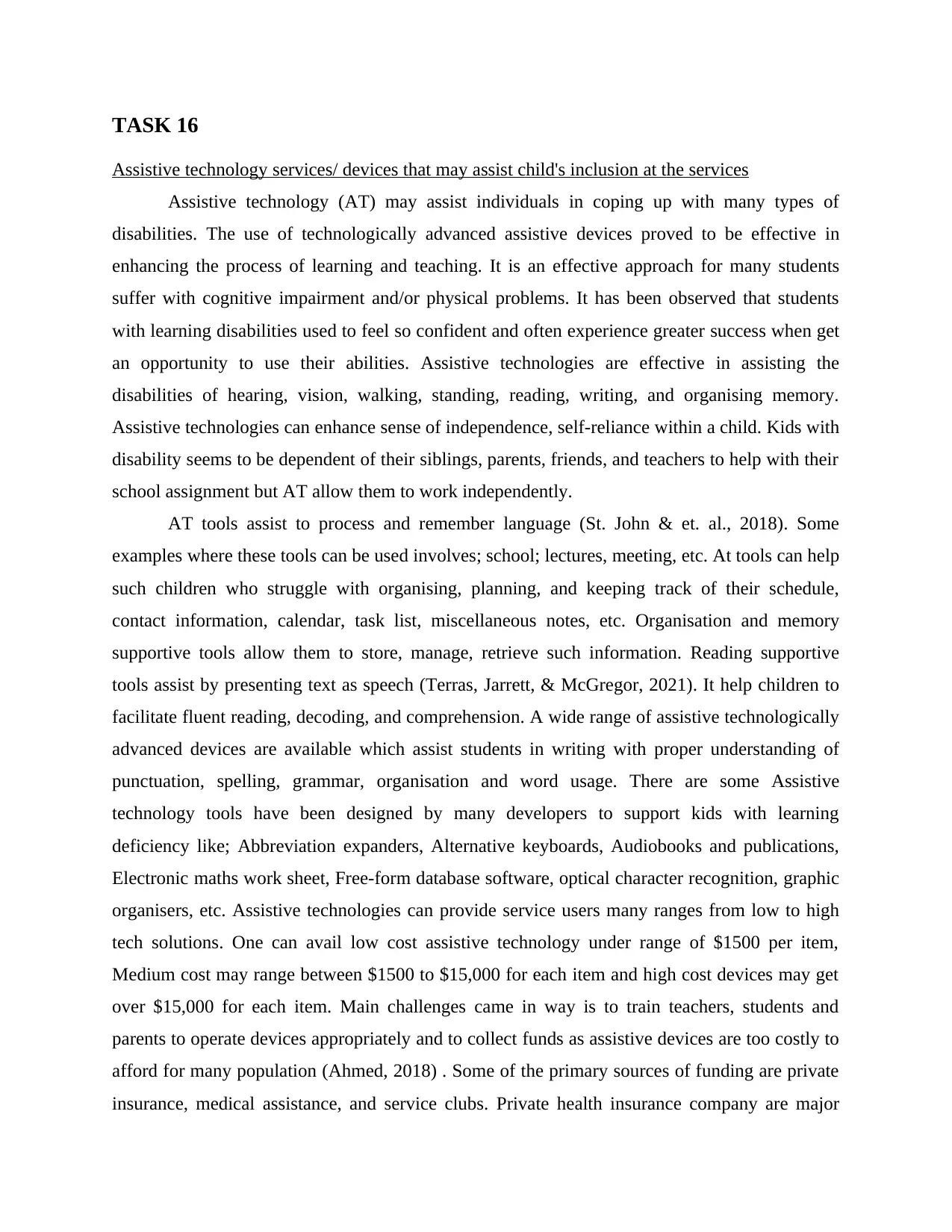
TASK 16
Assistive technology services/ devices that may assist child's inclusion at the services
Assistive technology (AT) may assist individuals in coping up with many types of
disabilities. The use of technologically advanced assistive devices proved to be effective in
enhancing the process of learning and teaching. It is an effective approach for many students
suffer with cognitive impairment and/or physical problems. It has been observed that students
with learning disabilities used to feel so confident and often experience greater success when get
an opportunity to use their abilities. Assistive technologies are effective in assisting the
disabilities of hearing, vision, walking, standing, reading, writing, and organising memory.
Assistive technologies can enhance sense of independence, self-reliance within a child. Kids with
disability seems to be dependent of their siblings, parents, friends, and teachers to help with their
school assignment but AT allow them to work independently.
AT tools assist to process and remember language (St. John & et. al., 2018). Some
examples where these tools can be used involves; school; lectures, meeting, etc. At tools can help
such children who struggle with organising, planning, and keeping track of their schedule,
contact information, calendar, task list, miscellaneous notes, etc. Organisation and memory
supportive tools allow them to store, manage, retrieve such information. Reading supportive
tools assist by presenting text as speech (Terras, Jarrett, & McGregor, 2021). It help children to
facilitate fluent reading, decoding, and comprehension. A wide range of assistive technologically
advanced devices are available which assist students in writing with proper understanding of
punctuation, spelling, grammar, organisation and word usage. There are some Assistive
technology tools have been designed by many developers to support kids with learning
deficiency like; Abbreviation expanders, Alternative keyboards, Audiobooks and publications,
Electronic maths work sheet, Free-form database software, optical character recognition, graphic
organisers, etc. Assistive technologies can provide service users many ranges from low to high
tech solutions. One can avail low cost assistive technology under range of $1500 per item,
Medium cost may range between $1500 to $15,000 for each item and high cost devices may get
over $15,000 for each item. Main challenges came in way is to train teachers, students and
parents to operate devices appropriately and to collect funds as assistive devices are too costly to
afford for many population (Ahmed, 2018) . Some of the primary sources of funding are private
insurance, medical assistance, and service clubs. Private health insurance company are major
Assistive technology services/ devices that may assist child's inclusion at the services
Assistive technology (AT) may assist individuals in coping up with many types of
disabilities. The use of technologically advanced assistive devices proved to be effective in
enhancing the process of learning and teaching. It is an effective approach for many students
suffer with cognitive impairment and/or physical problems. It has been observed that students
with learning disabilities used to feel so confident and often experience greater success when get
an opportunity to use their abilities. Assistive technologies are effective in assisting the
disabilities of hearing, vision, walking, standing, reading, writing, and organising memory.
Assistive technologies can enhance sense of independence, self-reliance within a child. Kids with
disability seems to be dependent of their siblings, parents, friends, and teachers to help with their
school assignment but AT allow them to work independently.
AT tools assist to process and remember language (St. John & et. al., 2018). Some
examples where these tools can be used involves; school; lectures, meeting, etc. At tools can help
such children who struggle with organising, planning, and keeping track of their schedule,
contact information, calendar, task list, miscellaneous notes, etc. Organisation and memory
supportive tools allow them to store, manage, retrieve such information. Reading supportive
tools assist by presenting text as speech (Terras, Jarrett, & McGregor, 2021). It help children to
facilitate fluent reading, decoding, and comprehension. A wide range of assistive technologically
advanced devices are available which assist students in writing with proper understanding of
punctuation, spelling, grammar, organisation and word usage. There are some Assistive
technology tools have been designed by many developers to support kids with learning
deficiency like; Abbreviation expanders, Alternative keyboards, Audiobooks and publications,
Electronic maths work sheet, Free-form database software, optical character recognition, graphic
organisers, etc. Assistive technologies can provide service users many ranges from low to high
tech solutions. One can avail low cost assistive technology under range of $1500 per item,
Medium cost may range between $1500 to $15,000 for each item and high cost devices may get
over $15,000 for each item. Main challenges came in way is to train teachers, students and
parents to operate devices appropriately and to collect funds as assistive devices are too costly to
afford for many population (Ahmed, 2018) . Some of the primary sources of funding are private
insurance, medical assistance, and service clubs. Private health insurance company are major
Secure Best Marks with AI Grader
Need help grading? Try our AI Grader for instant feedback on your assignments.
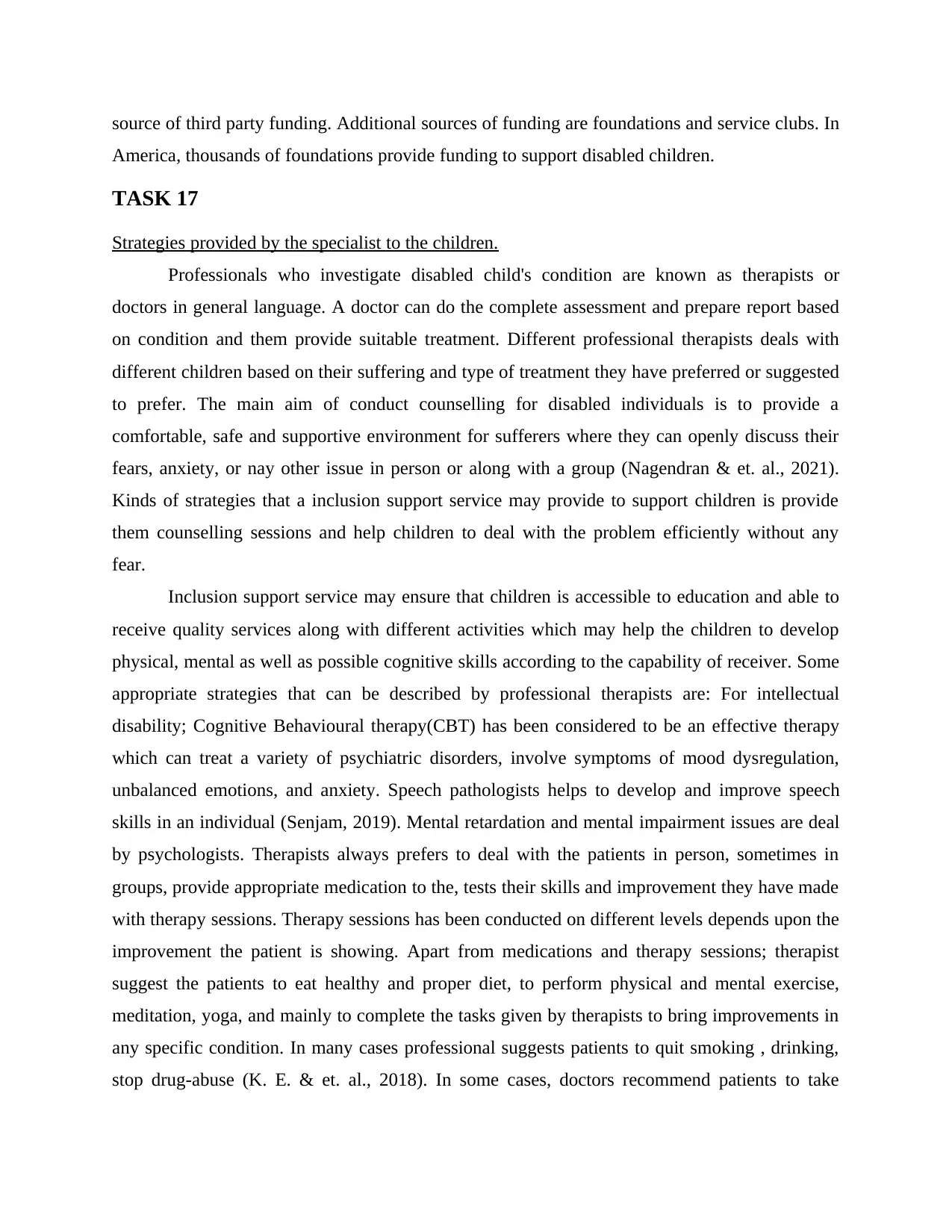
source of third party funding. Additional sources of funding are foundations and service clubs. In
America, thousands of foundations provide funding to support disabled children.
TASK 17
Strategies provided by the specialist to the children.
Professionals who investigate disabled child's condition are known as therapists or
doctors in general language. A doctor can do the complete assessment and prepare report based
on condition and them provide suitable treatment. Different professional therapists deals with
different children based on their suffering and type of treatment they have preferred or suggested
to prefer. The main aim of conduct counselling for disabled individuals is to provide a
comfortable, safe and supportive environment for sufferers where they can openly discuss their
fears, anxiety, or nay other issue in person or along with a group (Nagendran & et. al., 2021).
Kinds of strategies that a inclusion support service may provide to support children is provide
them counselling sessions and help children to deal with the problem efficiently without any
fear.
Inclusion support service may ensure that children is accessible to education and able to
receive quality services along with different activities which may help the children to develop
physical, mental as well as possible cognitive skills according to the capability of receiver. Some
appropriate strategies that can be described by professional therapists are: For intellectual
disability; Cognitive Behavioural therapy(CBT) has been considered to be an effective therapy
which can treat a variety of psychiatric disorders, involve symptoms of mood dysregulation,
unbalanced emotions, and anxiety. Speech pathologists helps to develop and improve speech
skills in an individual (Senjam, 2019). Mental retardation and mental impairment issues are deal
by psychologists. Therapists always prefers to deal with the patients in person, sometimes in
groups, provide appropriate medication to the, tests their skills and improvement they have made
with therapy sessions. Therapy sessions has been conducted on different levels depends upon the
improvement the patient is showing. Apart from medications and therapy sessions; therapist
suggest the patients to eat healthy and proper diet, to perform physical and mental exercise,
meditation, yoga, and mainly to complete the tasks given by therapists to bring improvements in
any specific condition. In many cases professional suggests patients to quit smoking , drinking,
stop drug-abuse (K. E. & et. al., 2018). In some cases, doctors recommend patients to take
America, thousands of foundations provide funding to support disabled children.
TASK 17
Strategies provided by the specialist to the children.
Professionals who investigate disabled child's condition are known as therapists or
doctors in general language. A doctor can do the complete assessment and prepare report based
on condition and them provide suitable treatment. Different professional therapists deals with
different children based on their suffering and type of treatment they have preferred or suggested
to prefer. The main aim of conduct counselling for disabled individuals is to provide a
comfortable, safe and supportive environment for sufferers where they can openly discuss their
fears, anxiety, or nay other issue in person or along with a group (Nagendran & et. al., 2021).
Kinds of strategies that a inclusion support service may provide to support children is provide
them counselling sessions and help children to deal with the problem efficiently without any
fear.
Inclusion support service may ensure that children is accessible to education and able to
receive quality services along with different activities which may help the children to develop
physical, mental as well as possible cognitive skills according to the capability of receiver. Some
appropriate strategies that can be described by professional therapists are: For intellectual
disability; Cognitive Behavioural therapy(CBT) has been considered to be an effective therapy
which can treat a variety of psychiatric disorders, involve symptoms of mood dysregulation,
unbalanced emotions, and anxiety. Speech pathologists helps to develop and improve speech
skills in an individual (Senjam, 2019). Mental retardation and mental impairment issues are deal
by psychologists. Therapists always prefers to deal with the patients in person, sometimes in
groups, provide appropriate medication to the, tests their skills and improvement they have made
with therapy sessions. Therapy sessions has been conducted on different levels depends upon the
improvement the patient is showing. Apart from medications and therapy sessions; therapist
suggest the patients to eat healthy and proper diet, to perform physical and mental exercise,
meditation, yoga, and mainly to complete the tasks given by therapists to bring improvements in
any specific condition. In many cases professional suggests patients to quit smoking , drinking,
stop drug-abuse (K. E. & et. al., 2018). In some cases, doctors recommend patients to take
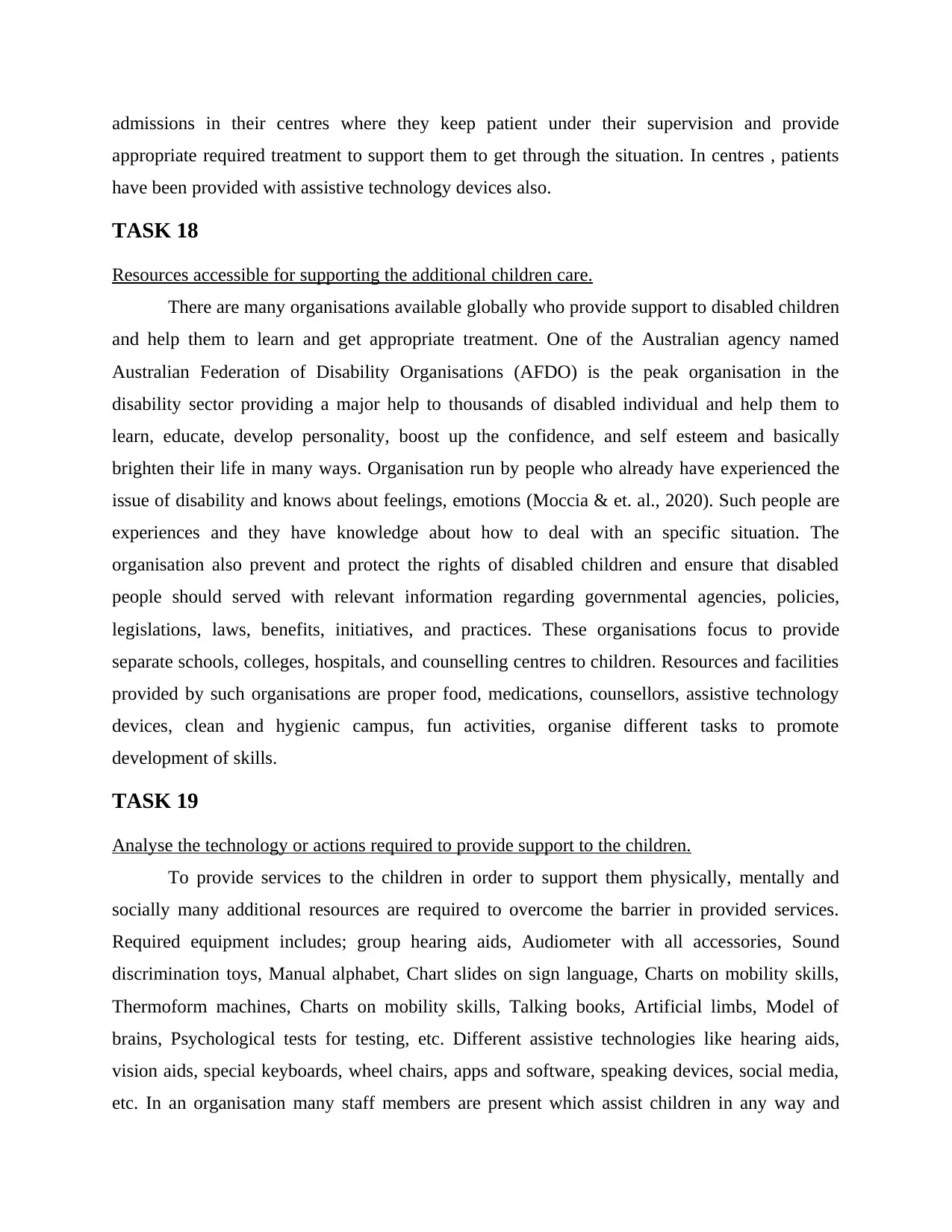
admissions in their centres where they keep patient under their supervision and provide
appropriate required treatment to support them to get through the situation. In centres , patients
have been provided with assistive technology devices also.
TASK 18
Resources accessible for supporting the additional children care.
There are many organisations available globally who provide support to disabled children
and help them to learn and get appropriate treatment. One of the Australian agency named
Australian Federation of Disability Organisations (AFDO) is the peak organisation in the
disability sector providing a major help to thousands of disabled individual and help them to
learn, educate, develop personality, boost up the confidence, and self esteem and basically
brighten their life in many ways. Organisation run by people who already have experienced the
issue of disability and knows about feelings, emotions (Moccia & et. al., 2020). Such people are
experiences and they have knowledge about how to deal with an specific situation. The
organisation also prevent and protect the rights of disabled children and ensure that disabled
people should served with relevant information regarding governmental agencies, policies,
legislations, laws, benefits, initiatives, and practices. These organisations focus to provide
separate schools, colleges, hospitals, and counselling centres to children. Resources and facilities
provided by such organisations are proper food, medications, counsellors, assistive technology
devices, clean and hygienic campus, fun activities, organise different tasks to promote
development of skills.
TASK 19
Analyse the technology or actions required to provide support to the children.
To provide services to the children in order to support them physically, mentally and
socially many additional resources are required to overcome the barrier in provided services.
Required equipment includes; group hearing aids, Audiometer with all accessories, Sound
discrimination toys, Manual alphabet, Chart slides on sign language, Charts on mobility skills,
Thermoform machines, Charts on mobility skills, Talking books, Artificial limbs, Model of
brains, Psychological tests for testing, etc. Different assistive technologies like hearing aids,
vision aids, special keyboards, wheel chairs, apps and software, speaking devices, social media,
etc. In an organisation many staff members are present which assist children in any way and
appropriate required treatment to support them to get through the situation. In centres , patients
have been provided with assistive technology devices also.
TASK 18
Resources accessible for supporting the additional children care.
There are many organisations available globally who provide support to disabled children
and help them to learn and get appropriate treatment. One of the Australian agency named
Australian Federation of Disability Organisations (AFDO) is the peak organisation in the
disability sector providing a major help to thousands of disabled individual and help them to
learn, educate, develop personality, boost up the confidence, and self esteem and basically
brighten their life in many ways. Organisation run by people who already have experienced the
issue of disability and knows about feelings, emotions (Moccia & et. al., 2020). Such people are
experiences and they have knowledge about how to deal with an specific situation. The
organisation also prevent and protect the rights of disabled children and ensure that disabled
people should served with relevant information regarding governmental agencies, policies,
legislations, laws, benefits, initiatives, and practices. These organisations focus to provide
separate schools, colleges, hospitals, and counselling centres to children. Resources and facilities
provided by such organisations are proper food, medications, counsellors, assistive technology
devices, clean and hygienic campus, fun activities, organise different tasks to promote
development of skills.
TASK 19
Analyse the technology or actions required to provide support to the children.
To provide services to the children in order to support them physically, mentally and
socially many additional resources are required to overcome the barrier in provided services.
Required equipment includes; group hearing aids, Audiometer with all accessories, Sound
discrimination toys, Manual alphabet, Chart slides on sign language, Charts on mobility skills,
Thermoform machines, Charts on mobility skills, Talking books, Artificial limbs, Model of
brains, Psychological tests for testing, etc. Different assistive technologies like hearing aids,
vision aids, special keyboards, wheel chairs, apps and software, speaking devices, social media,
etc. In an organisation many staff members are present which assist children in any way and
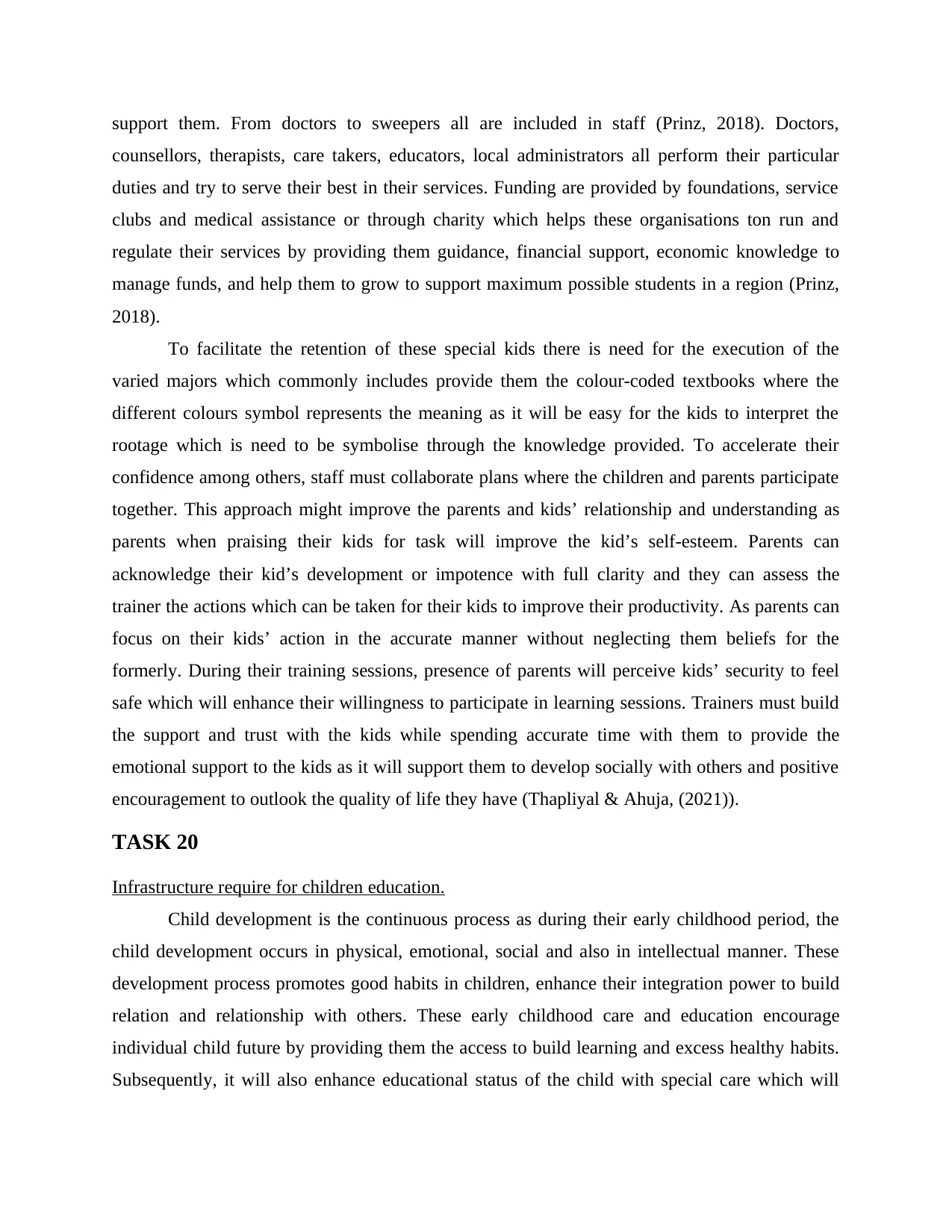
support them. From doctors to sweepers all are included in staff (Prinz, 2018). Doctors,
counsellors, therapists, care takers, educators, local administrators all perform their particular
duties and try to serve their best in their services. Funding are provided by foundations, service
clubs and medical assistance or through charity which helps these organisations ton run and
regulate their services by providing them guidance, financial support, economic knowledge to
manage funds, and help them to grow to support maximum possible students in a region (Prinz,
2018).
To facilitate the retention of these special kids there is need for the execution of the
varied majors which commonly includes provide them the colour-coded textbooks where the
different colours symbol represents the meaning as it will be easy for the kids to interpret the
rootage which is need to be symbolise through the knowledge provided. To accelerate their
confidence among others, staff must collaborate plans where the children and parents participate
together. This approach might improve the parents and kids’ relationship and understanding as
parents when praising their kids for task will improve the kid’s self-esteem. Parents can
acknowledge their kid’s development or impotence with full clarity and they can assess the
trainer the actions which can be taken for their kids to improve their productivity. As parents can
focus on their kids’ action in the accurate manner without neglecting them beliefs for the
formerly. During their training sessions, presence of parents will perceive kids’ security to feel
safe which will enhance their willingness to participate in learning sessions. Trainers must build
the support and trust with the kids while spending accurate time with them to provide the
emotional support to the kids as it will support them to develop socially with others and positive
encouragement to outlook the quality of life they have (Thapliyal & Ahuja, (2021)).
TASK 20
Infrastructure require for children education.
Child development is the continuous process as during their early childhood period, the
child development occurs in physical, emotional, social and also in intellectual manner. These
development process promotes good habits in children, enhance their integration power to build
relation and relationship with others. These early childhood care and education encourage
individual child future by providing them the access to build learning and excess healthy habits.
Subsequently, it will also enhance educational status of the child with special care which will
counsellors, therapists, care takers, educators, local administrators all perform their particular
duties and try to serve their best in their services. Funding are provided by foundations, service
clubs and medical assistance or through charity which helps these organisations ton run and
regulate their services by providing them guidance, financial support, economic knowledge to
manage funds, and help them to grow to support maximum possible students in a region (Prinz,
2018).
To facilitate the retention of these special kids there is need for the execution of the
varied majors which commonly includes provide them the colour-coded textbooks where the
different colours symbol represents the meaning as it will be easy for the kids to interpret the
rootage which is need to be symbolise through the knowledge provided. To accelerate their
confidence among others, staff must collaborate plans where the children and parents participate
together. This approach might improve the parents and kids’ relationship and understanding as
parents when praising their kids for task will improve the kid’s self-esteem. Parents can
acknowledge their kid’s development or impotence with full clarity and they can assess the
trainer the actions which can be taken for their kids to improve their productivity. As parents can
focus on their kids’ action in the accurate manner without neglecting them beliefs for the
formerly. During their training sessions, presence of parents will perceive kids’ security to feel
safe which will enhance their willingness to participate in learning sessions. Trainers must build
the support and trust with the kids while spending accurate time with them to provide the
emotional support to the kids as it will support them to develop socially with others and positive
encouragement to outlook the quality of life they have (Thapliyal & Ahuja, (2021)).
TASK 20
Infrastructure require for children education.
Child development is the continuous process as during their early childhood period, the
child development occurs in physical, emotional, social and also in intellectual manner. These
development process promotes good habits in children, enhance their integration power to build
relation and relationship with others. These early childhood care and education encourage
individual child future by providing them the access to build learning and excess healthy habits.
Subsequently, it will also enhance educational status of the child with special care which will
Paraphrase This Document
Need a fresh take? Get an instant paraphrase of this document with our AI Paraphraser
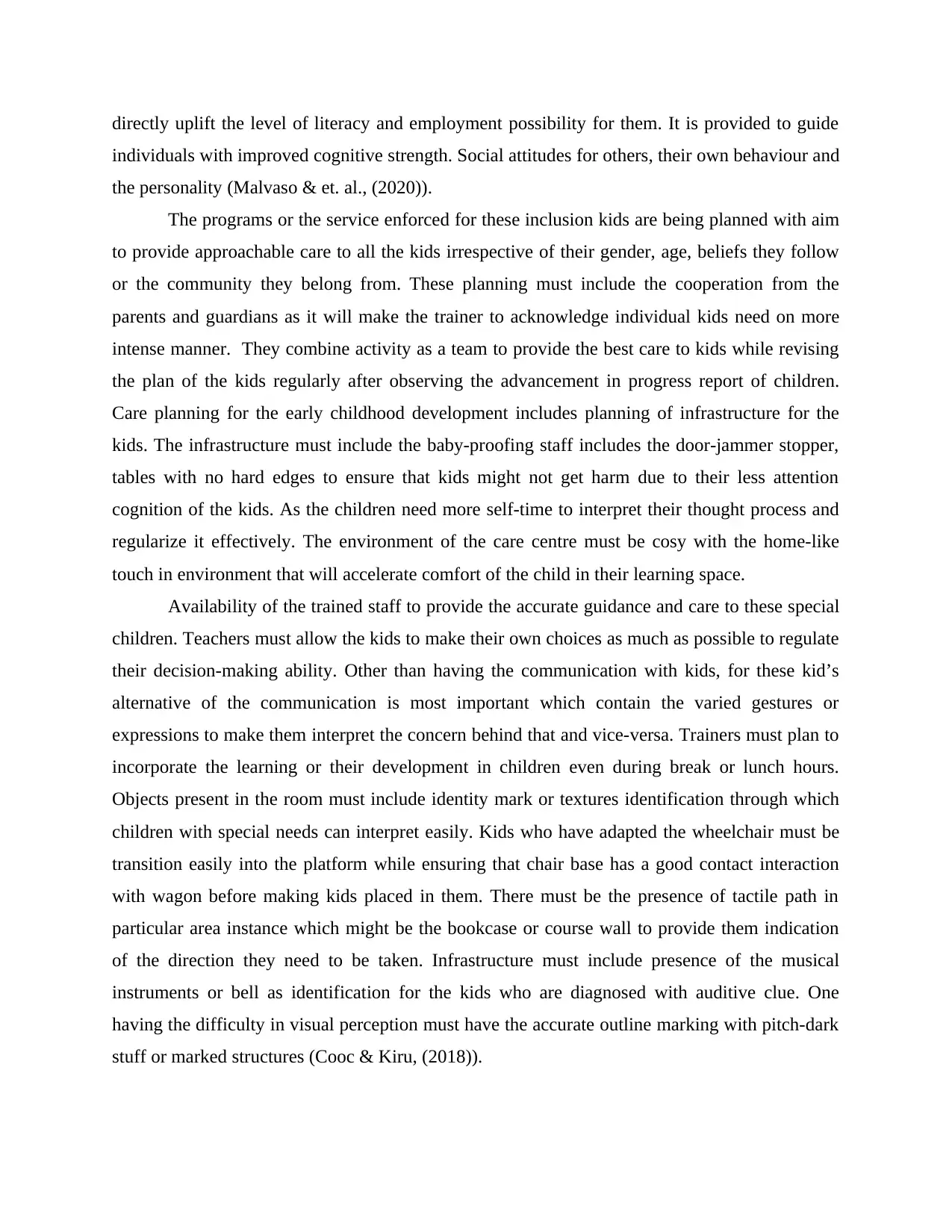
directly uplift the level of literacy and employment possibility for them. It is provided to guide
individuals with improved cognitive strength. Social attitudes for others, their own behaviour and
the personality (Malvaso & et. al., (2020)).
The programs or the service enforced for these inclusion kids are being planned with aim
to provide approachable care to all the kids irrespective of their gender, age, beliefs they follow
or the community they belong from. These planning must include the cooperation from the
parents and guardians as it will make the trainer to acknowledge individual kids need on more
intense manner. They combine activity as a team to provide the best care to kids while revising
the plan of the kids regularly after observing the advancement in progress report of children.
Care planning for the early childhood development includes planning of infrastructure for the
kids. The infrastructure must include the baby-proofing staff includes the door-jammer stopper,
tables with no hard edges to ensure that kids might not get harm due to their less attention
cognition of the kids. As the children need more self-time to interpret their thought process and
regularize it effectively. The environment of the care centre must be cosy with the home-like
touch in environment that will accelerate comfort of the child in their learning space.
Availability of the trained staff to provide the accurate guidance and care to these special
children. Teachers must allow the kids to make their own choices as much as possible to regulate
their decision-making ability. Other than having the communication with kids, for these kid’s
alternative of the communication is most important which contain the varied gestures or
expressions to make them interpret the concern behind that and vice-versa. Trainers must plan to
incorporate the learning or their development in children even during break or lunch hours.
Objects present in the room must include identity mark or textures identification through which
children with special needs can interpret easily. Kids who have adapted the wheelchair must be
transition easily into the platform while ensuring that chair base has a good contact interaction
with wagon before making kids placed in them. There must be the presence of tactile path in
particular area instance which might be the bookcase or course wall to provide them indication
of the direction they need to be taken. Infrastructure must include presence of the musical
instruments or bell as identification for the kids who are diagnosed with auditive clue. One
having the difficulty in visual perception must have the accurate outline marking with pitch-dark
stuff or marked structures (Cooc & Kiru, (2018)).
individuals with improved cognitive strength. Social attitudes for others, their own behaviour and
the personality (Malvaso & et. al., (2020)).
The programs or the service enforced for these inclusion kids are being planned with aim
to provide approachable care to all the kids irrespective of their gender, age, beliefs they follow
or the community they belong from. These planning must include the cooperation from the
parents and guardians as it will make the trainer to acknowledge individual kids need on more
intense manner. They combine activity as a team to provide the best care to kids while revising
the plan of the kids regularly after observing the advancement in progress report of children.
Care planning for the early childhood development includes planning of infrastructure for the
kids. The infrastructure must include the baby-proofing staff includes the door-jammer stopper,
tables with no hard edges to ensure that kids might not get harm due to their less attention
cognition of the kids. As the children need more self-time to interpret their thought process and
regularize it effectively. The environment of the care centre must be cosy with the home-like
touch in environment that will accelerate comfort of the child in their learning space.
Availability of the trained staff to provide the accurate guidance and care to these special
children. Teachers must allow the kids to make their own choices as much as possible to regulate
their decision-making ability. Other than having the communication with kids, for these kid’s
alternative of the communication is most important which contain the varied gestures or
expressions to make them interpret the concern behind that and vice-versa. Trainers must plan to
incorporate the learning or their development in children even during break or lunch hours.
Objects present in the room must include identity mark or textures identification through which
children with special needs can interpret easily. Kids who have adapted the wheelchair must be
transition easily into the platform while ensuring that chair base has a good contact interaction
with wagon before making kids placed in them. There must be the presence of tactile path in
particular area instance which might be the bookcase or course wall to provide them indication
of the direction they need to be taken. Infrastructure must include presence of the musical
instruments or bell as identification for the kids who are diagnosed with auditive clue. One
having the difficulty in visual perception must have the accurate outline marking with pitch-dark
stuff or marked structures (Cooc & Kiru, (2018)).
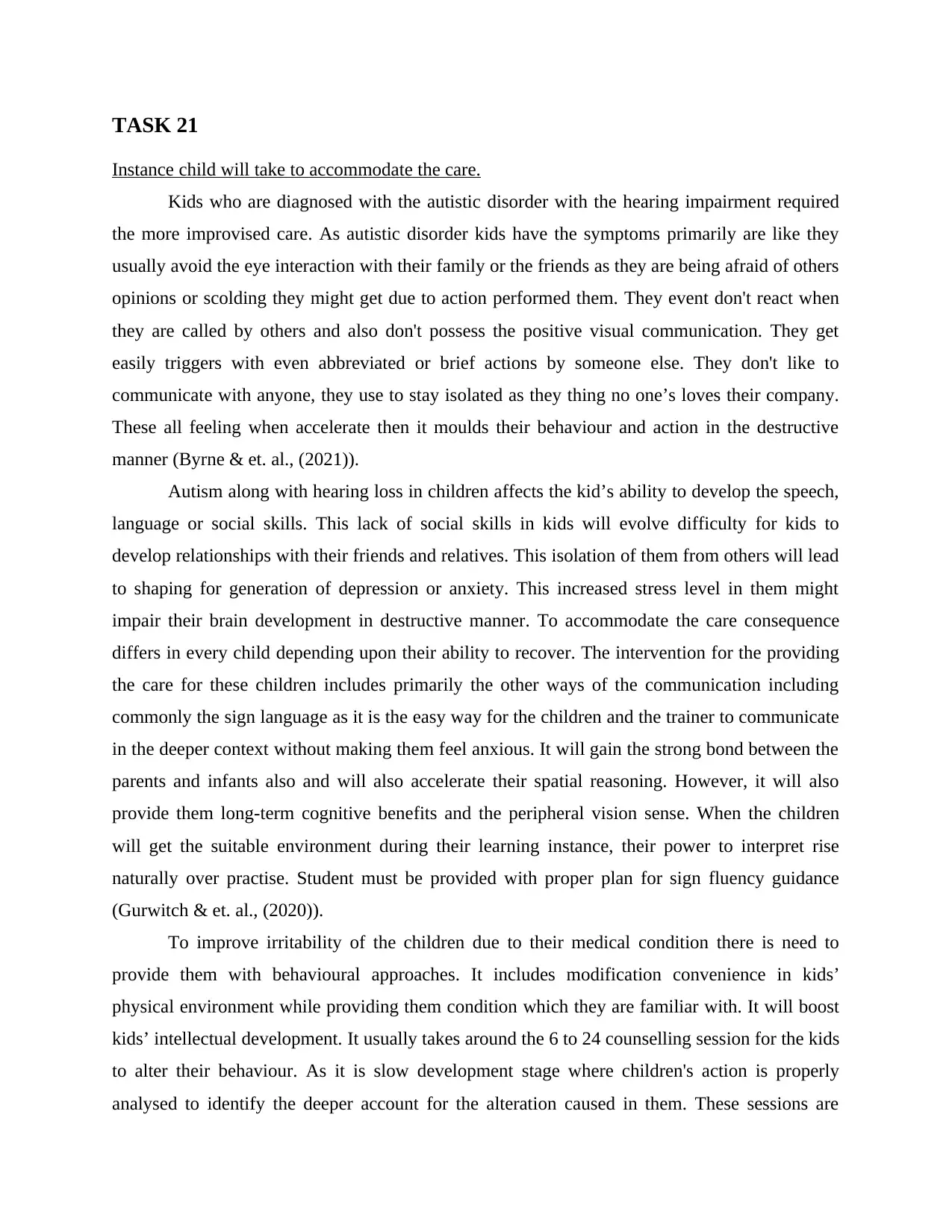
TASK 21
Instance child will take to accommodate the care.
Kids who are diagnosed with the autistic disorder with the hearing impairment required
the more improvised care. As autistic disorder kids have the symptoms primarily are like they
usually avoid the eye interaction with their family or the friends as they are being afraid of others
opinions or scolding they might get due to action performed them. They event don't react when
they are called by others and also don't possess the positive visual communication. They get
easily triggers with even abbreviated or brief actions by someone else. They don't like to
communicate with anyone, they use to stay isolated as they thing no one’s loves their company.
These all feeling when accelerate then it moulds their behaviour and action in the destructive
manner (Byrne & et. al., (2021)).
Autism along with hearing loss in children affects the kid’s ability to develop the speech,
language or social skills. This lack of social skills in kids will evolve difficulty for kids to
develop relationships with their friends and relatives. This isolation of them from others will lead
to shaping for generation of depression or anxiety. This increased stress level in them might
impair their brain development in destructive manner. To accommodate the care consequence
differs in every child depending upon their ability to recover. The intervention for the providing
the care for these children includes primarily the other ways of the communication including
commonly the sign language as it is the easy way for the children and the trainer to communicate
in the deeper context without making them feel anxious. It will gain the strong bond between the
parents and infants also and will also accelerate their spatial reasoning. However, it will also
provide them long-term cognitive benefits and the peripheral vision sense. When the children
will get the suitable environment during their learning instance, their power to interpret rise
naturally over practise. Student must be provided with proper plan for sign fluency guidance
(Gurwitch & et. al., (2020)).
To improve irritability of the children due to their medical condition there is need to
provide them with behavioural approaches. It includes modification convenience in kids’
physical environment while providing them condition which they are familiar with. It will boost
kids’ intellectual development. It usually takes around the 6 to 24 counselling session for the kids
to alter their behaviour. As it is slow development stage where children's action is properly
analysed to identify the deeper account for the alteration caused in them. These sessions are
Instance child will take to accommodate the care.
Kids who are diagnosed with the autistic disorder with the hearing impairment required
the more improvised care. As autistic disorder kids have the symptoms primarily are like they
usually avoid the eye interaction with their family or the friends as they are being afraid of others
opinions or scolding they might get due to action performed them. They event don't react when
they are called by others and also don't possess the positive visual communication. They get
easily triggers with even abbreviated or brief actions by someone else. They don't like to
communicate with anyone, they use to stay isolated as they thing no one’s loves their company.
These all feeling when accelerate then it moulds their behaviour and action in the destructive
manner (Byrne & et. al., (2021)).
Autism along with hearing loss in children affects the kid’s ability to develop the speech,
language or social skills. This lack of social skills in kids will evolve difficulty for kids to
develop relationships with their friends and relatives. This isolation of them from others will lead
to shaping for generation of depression or anxiety. This increased stress level in them might
impair their brain development in destructive manner. To accommodate the care consequence
differs in every child depending upon their ability to recover. The intervention for the providing
the care for these children includes primarily the other ways of the communication including
commonly the sign language as it is the easy way for the children and the trainer to communicate
in the deeper context without making them feel anxious. It will gain the strong bond between the
parents and infants also and will also accelerate their spatial reasoning. However, it will also
provide them long-term cognitive benefits and the peripheral vision sense. When the children
will get the suitable environment during their learning instance, their power to interpret rise
naturally over practise. Student must be provided with proper plan for sign fluency guidance
(Gurwitch & et. al., (2020)).
To improve irritability of the children due to their medical condition there is need to
provide them with behavioural approaches. It includes modification convenience in kids’
physical environment while providing them condition which they are familiar with. It will boost
kids’ intellectual development. It usually takes around the 6 to 24 counselling session for the kids
to alter their behaviour. As it is slow development stage where children's action is properly
analysed to identify the deeper account for the alteration caused in them. These sessions are
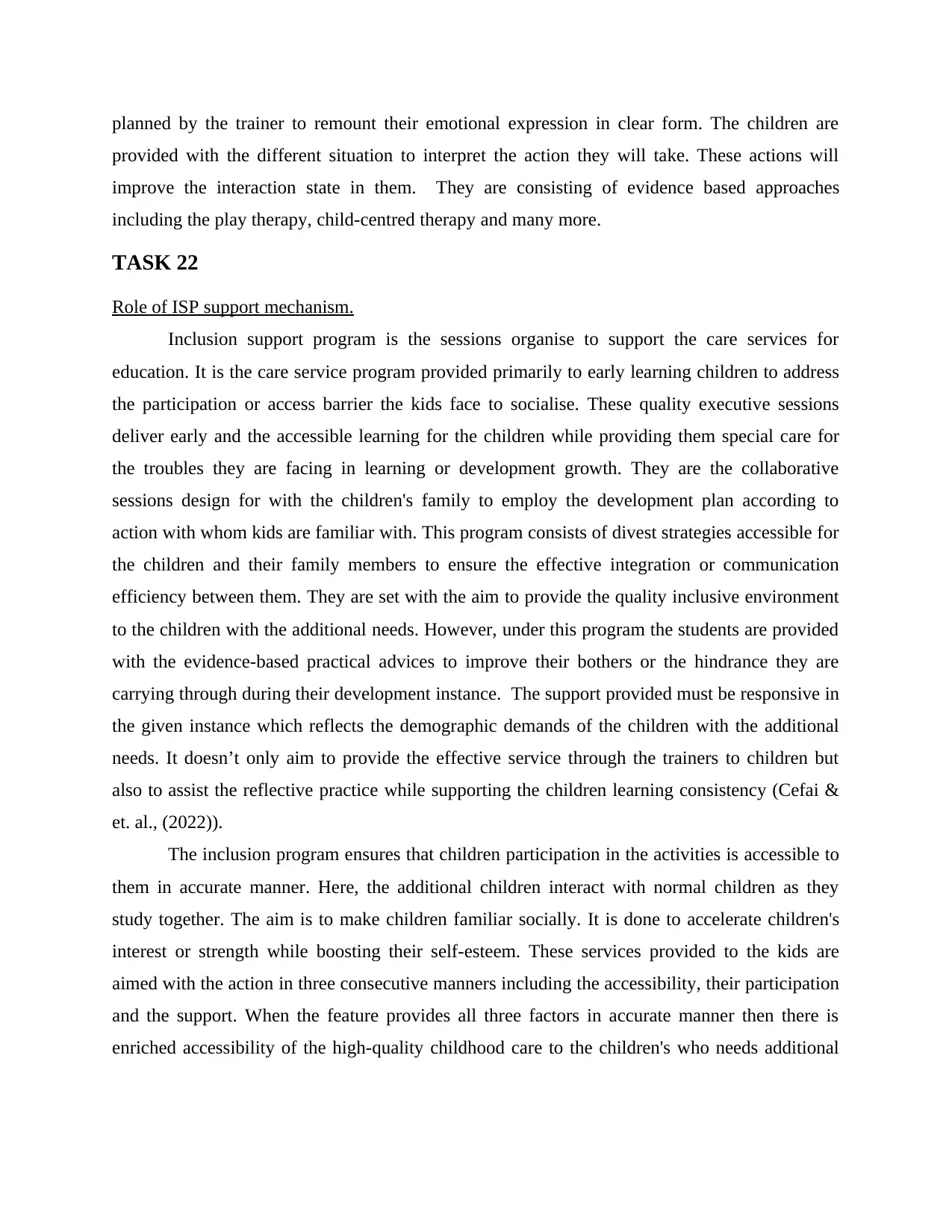
planned by the trainer to remount their emotional expression in clear form. The children are
provided with the different situation to interpret the action they will take. These actions will
improve the interaction state in them. They are consisting of evidence based approaches
including the play therapy, child-centred therapy and many more.
TASK 22
Role of ISP support mechanism.
Inclusion support program is the sessions organise to support the care services for
education. It is the care service program provided primarily to early learning children to address
the participation or access barrier the kids face to socialise. These quality executive sessions
deliver early and the accessible learning for the children while providing them special care for
the troubles they are facing in learning or development growth. They are the collaborative
sessions design for with the children's family to employ the development plan according to
action with whom kids are familiar with. This program consists of divest strategies accessible for
the children and their family members to ensure the effective integration or communication
efficiency between them. They are set with the aim to provide the quality inclusive environment
to the children with the additional needs. However, under this program the students are provided
with the evidence-based practical advices to improve their bothers or the hindrance they are
carrying through during their development instance. The support provided must be responsive in
the given instance which reflects the demographic demands of the children with the additional
needs. It doesn’t only aim to provide the effective service through the trainers to children but
also to assist the reflective practice while supporting the children learning consistency (Cefai &
et. al., (2022)).
The inclusion program ensures that children participation in the activities is accessible to
them in accurate manner. Here, the additional children interact with normal children as they
study together. The aim is to make children familiar socially. It is done to accelerate children's
interest or strength while boosting their self-esteem. These services provided to the kids are
aimed with the action in three consecutive manners including the accessibility, their participation
and the support. When the feature provides all three factors in accurate manner then there is
enriched accessibility of the high-quality childhood care to the children's who needs additional
provided with the different situation to interpret the action they will take. These actions will
improve the interaction state in them. They are consisting of evidence based approaches
including the play therapy, child-centred therapy and many more.
TASK 22
Role of ISP support mechanism.
Inclusion support program is the sessions organise to support the care services for
education. It is the care service program provided primarily to early learning children to address
the participation or access barrier the kids face to socialise. These quality executive sessions
deliver early and the accessible learning for the children while providing them special care for
the troubles they are facing in learning or development growth. They are the collaborative
sessions design for with the children's family to employ the development plan according to
action with whom kids are familiar with. This program consists of divest strategies accessible for
the children and their family members to ensure the effective integration or communication
efficiency between them. They are set with the aim to provide the quality inclusive environment
to the children with the additional needs. However, under this program the students are provided
with the evidence-based practical advices to improve their bothers or the hindrance they are
carrying through during their development instance. The support provided must be responsive in
the given instance which reflects the demographic demands of the children with the additional
needs. It doesn’t only aim to provide the effective service through the trainers to children but
also to assist the reflective practice while supporting the children learning consistency (Cefai &
et. al., (2022)).
The inclusion program ensures that children participation in the activities is accessible to
them in accurate manner. Here, the additional children interact with normal children as they
study together. The aim is to make children familiar socially. It is done to accelerate children's
interest or strength while boosting their self-esteem. These services provided to the kids are
aimed with the action in three consecutive manners including the accessibility, their participation
and the support. When the feature provides all three factors in accurate manner then there is
enriched accessibility of the high-quality childhood care to the children's who needs additional
Secure Best Marks with AI Grader
Need help grading? Try our AI Grader for instant feedback on your assignments.
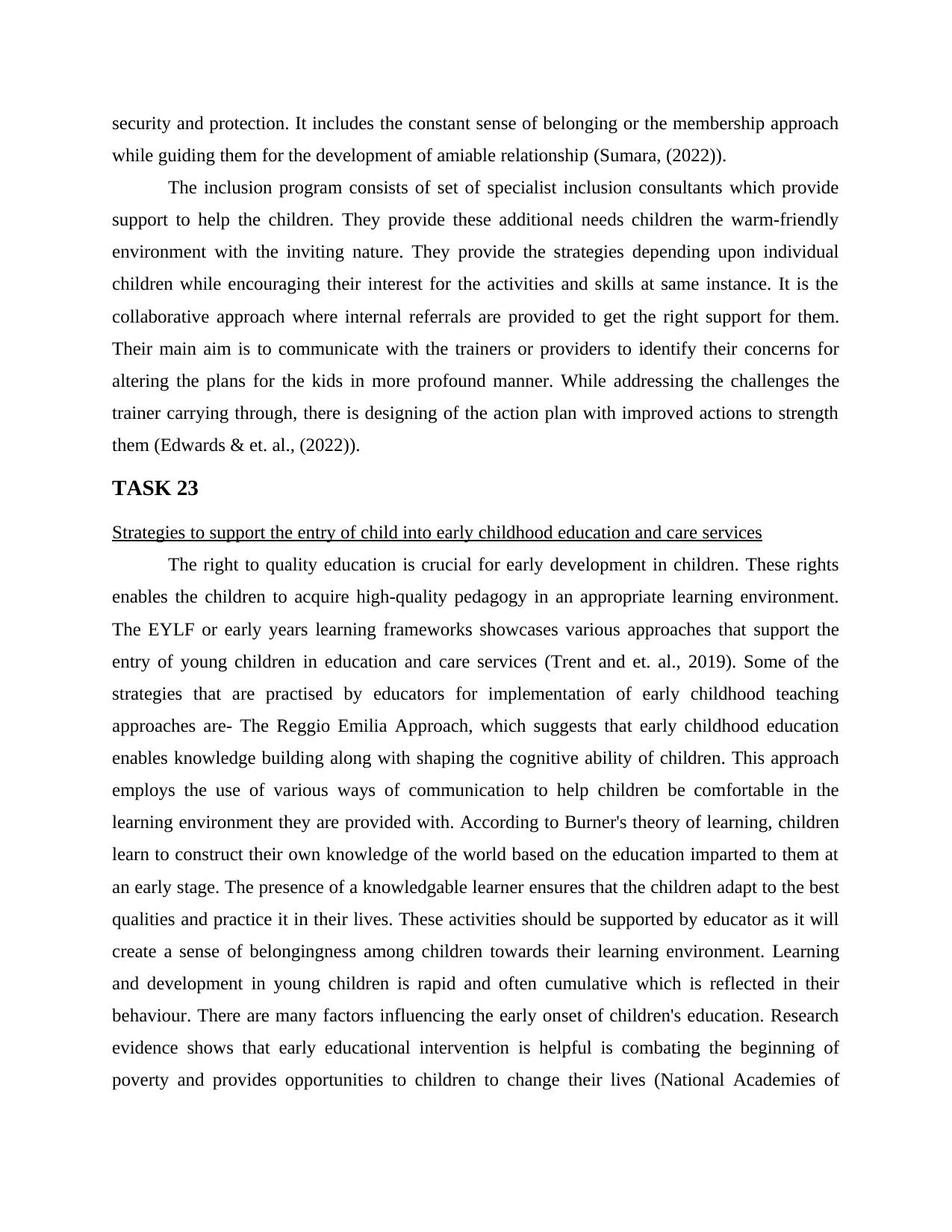
security and protection. It includes the constant sense of belonging or the membership approach
while guiding them for the development of amiable relationship (Sumara, (2022)).
The inclusion program consists of set of specialist inclusion consultants which provide
support to help the children. They provide these additional needs children the warm-friendly
environment with the inviting nature. They provide the strategies depending upon individual
children while encouraging their interest for the activities and skills at same instance. It is the
collaborative approach where internal referrals are provided to get the right support for them.
Their main aim is to communicate with the trainers or providers to identify their concerns for
altering the plans for the kids in more profound manner. While addressing the challenges the
trainer carrying through, there is designing of the action plan with improved actions to strength
them (Edwards & et. al., (2022)).
TASK 23
Strategies to support the entry of child into early childhood education and care services
The right to quality education is crucial for early development in children. These rights
enables the children to acquire high-quality pedagogy in an appropriate learning environment.
The EYLF or early years learning frameworks showcases various approaches that support the
entry of young children in education and care services (Trent and et. al., 2019). Some of the
strategies that are practised by educators for implementation of early childhood teaching
approaches are- The Reggio Emilia Approach, which suggests that early childhood education
enables knowledge building along with shaping the cognitive ability of children. This approach
employs the use of various ways of communication to help children be comfortable in the
learning environment they are provided with. According to Burner's theory of learning, children
learn to construct their own knowledge of the world based on the education imparted to them at
an early stage. The presence of a knowledgable learner ensures that the children adapt to the best
qualities and practice it in their lives. These activities should be supported by educator as it will
create a sense of belongingness among children towards their learning environment. Learning
and development in young children is rapid and often cumulative which is reflected in their
behaviour. There are many factors influencing the early onset of children's education. Research
evidence shows that early educational intervention is helpful is combating the beginning of
poverty and provides opportunities to children to change their lives (National Academies of
while guiding them for the development of amiable relationship (Sumara, (2022)).
The inclusion program consists of set of specialist inclusion consultants which provide
support to help the children. They provide these additional needs children the warm-friendly
environment with the inviting nature. They provide the strategies depending upon individual
children while encouraging their interest for the activities and skills at same instance. It is the
collaborative approach where internal referrals are provided to get the right support for them.
Their main aim is to communicate with the trainers or providers to identify their concerns for
altering the plans for the kids in more profound manner. While addressing the challenges the
trainer carrying through, there is designing of the action plan with improved actions to strength
them (Edwards & et. al., (2022)).
TASK 23
Strategies to support the entry of child into early childhood education and care services
The right to quality education is crucial for early development in children. These rights
enables the children to acquire high-quality pedagogy in an appropriate learning environment.
The EYLF or early years learning frameworks showcases various approaches that support the
entry of young children in education and care services (Trent and et. al., 2019). Some of the
strategies that are practised by educators for implementation of early childhood teaching
approaches are- The Reggio Emilia Approach, which suggests that early childhood education
enables knowledge building along with shaping the cognitive ability of children. This approach
employs the use of various ways of communication to help children be comfortable in the
learning environment they are provided with. According to Burner's theory of learning, children
learn to construct their own knowledge of the world based on the education imparted to them at
an early stage. The presence of a knowledgable learner ensures that the children adapt to the best
qualities and practice it in their lives. These activities should be supported by educator as it will
create a sense of belongingness among children towards their learning environment. Learning
and development in young children is rapid and often cumulative which is reflected in their
behaviour. There are many factors influencing the early onset of children's education. Research
evidence shows that early educational intervention is helpful is combating the beginning of
poverty and provides opportunities to children to change their lives (National Academies of
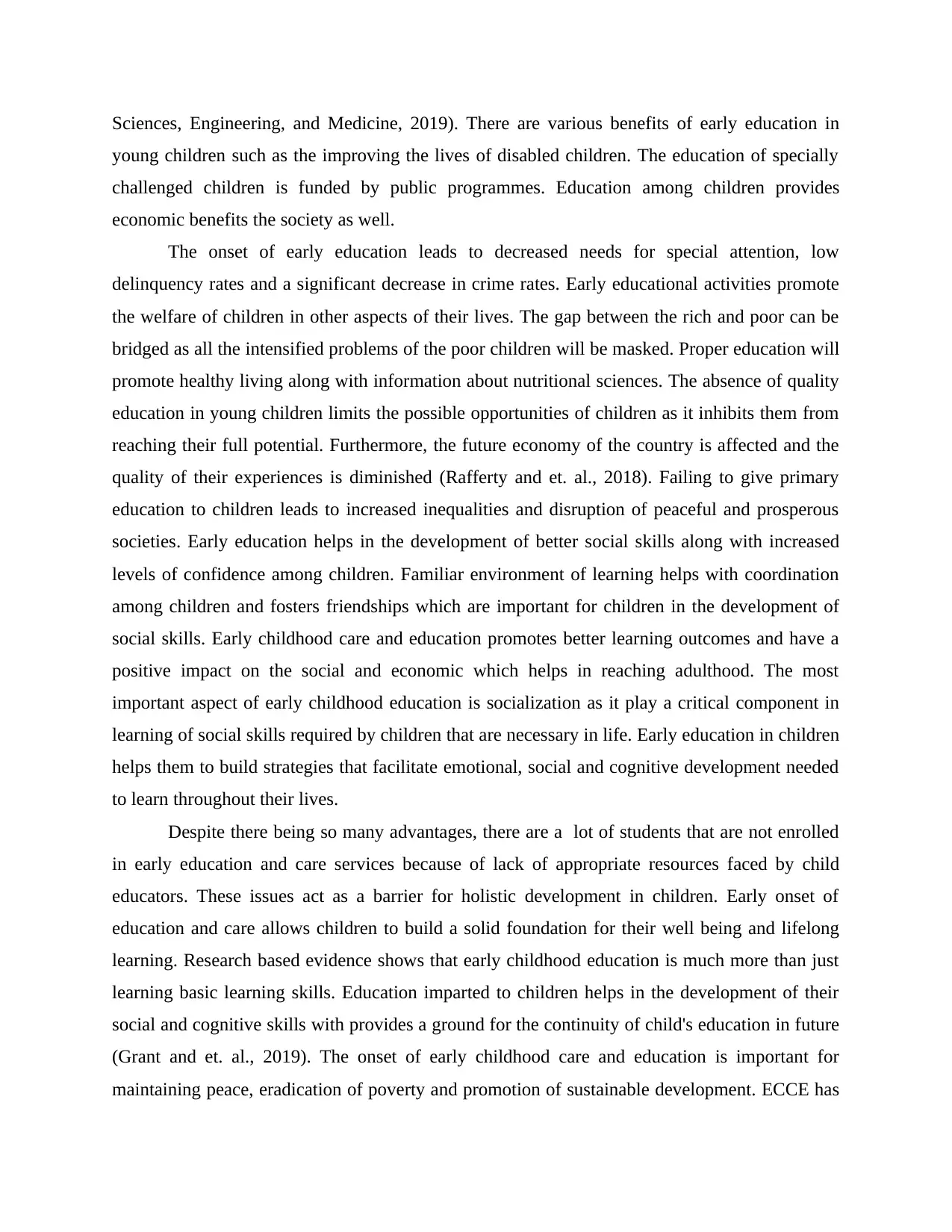
Sciences, Engineering, and Medicine, 2019). There are various benefits of early education in
young children such as the improving the lives of disabled children. The education of specially
challenged children is funded by public programmes. Education among children provides
economic benefits the society as well.
The onset of early education leads to decreased needs for special attention, low
delinquency rates and a significant decrease in crime rates. Early educational activities promote
the welfare of children in other aspects of their lives. The gap between the rich and poor can be
bridged as all the intensified problems of the poor children will be masked. Proper education will
promote healthy living along with information about nutritional sciences. The absence of quality
education in young children limits the possible opportunities of children as it inhibits them from
reaching their full potential. Furthermore, the future economy of the country is affected and the
quality of their experiences is diminished (Rafferty and et. al., 2018). Failing to give primary
education to children leads to increased inequalities and disruption of peaceful and prosperous
societies. Early education helps in the development of better social skills along with increased
levels of confidence among children. Familiar environment of learning helps with coordination
among children and fosters friendships which are important for children in the development of
social skills. Early childhood care and education promotes better learning outcomes and have a
positive impact on the social and economic which helps in reaching adulthood. The most
important aspect of early childhood education is socialization as it play a critical component in
learning of social skills required by children that are necessary in life. Early education in children
helps them to build strategies that facilitate emotional, social and cognitive development needed
to learn throughout their lives.
Despite there being so many advantages, there are a lot of students that are not enrolled
in early education and care services because of lack of appropriate resources faced by child
educators. These issues act as a barrier for holistic development in children. Early onset of
education and care allows children to build a solid foundation for their well being and lifelong
learning. Research based evidence shows that early childhood education is much more than just
learning basic learning skills. Education imparted to children helps in the development of their
social and cognitive skills with provides a ground for the continuity of child's education in future
(Grant and et. al., 2019). The onset of early childhood care and education is important for
maintaining peace, eradication of poverty and promotion of sustainable development. ECCE has
young children such as the improving the lives of disabled children. The education of specially
challenged children is funded by public programmes. Education among children provides
economic benefits the society as well.
The onset of early education leads to decreased needs for special attention, low
delinquency rates and a significant decrease in crime rates. Early educational activities promote
the welfare of children in other aspects of their lives. The gap between the rich and poor can be
bridged as all the intensified problems of the poor children will be masked. Proper education will
promote healthy living along with information about nutritional sciences. The absence of quality
education in young children limits the possible opportunities of children as it inhibits them from
reaching their full potential. Furthermore, the future economy of the country is affected and the
quality of their experiences is diminished (Rafferty and et. al., 2018). Failing to give primary
education to children leads to increased inequalities and disruption of peaceful and prosperous
societies. Early education helps in the development of better social skills along with increased
levels of confidence among children. Familiar environment of learning helps with coordination
among children and fosters friendships which are important for children in the development of
social skills. Early childhood care and education promotes better learning outcomes and have a
positive impact on the social and economic which helps in reaching adulthood. The most
important aspect of early childhood education is socialization as it play a critical component in
learning of social skills required by children that are necessary in life. Early education in children
helps them to build strategies that facilitate emotional, social and cognitive development needed
to learn throughout their lives.
Despite there being so many advantages, there are a lot of students that are not enrolled
in early education and care services because of lack of appropriate resources faced by child
educators. These issues act as a barrier for holistic development in children. Early onset of
education and care allows children to build a solid foundation for their well being and lifelong
learning. Research based evidence shows that early childhood education is much more than just
learning basic learning skills. Education imparted to children helps in the development of their
social and cognitive skills with provides a ground for the continuity of child's education in future
(Grant and et. al., 2019). The onset of early childhood care and education is important for
maintaining peace, eradication of poverty and promotion of sustainable development. ECCE has
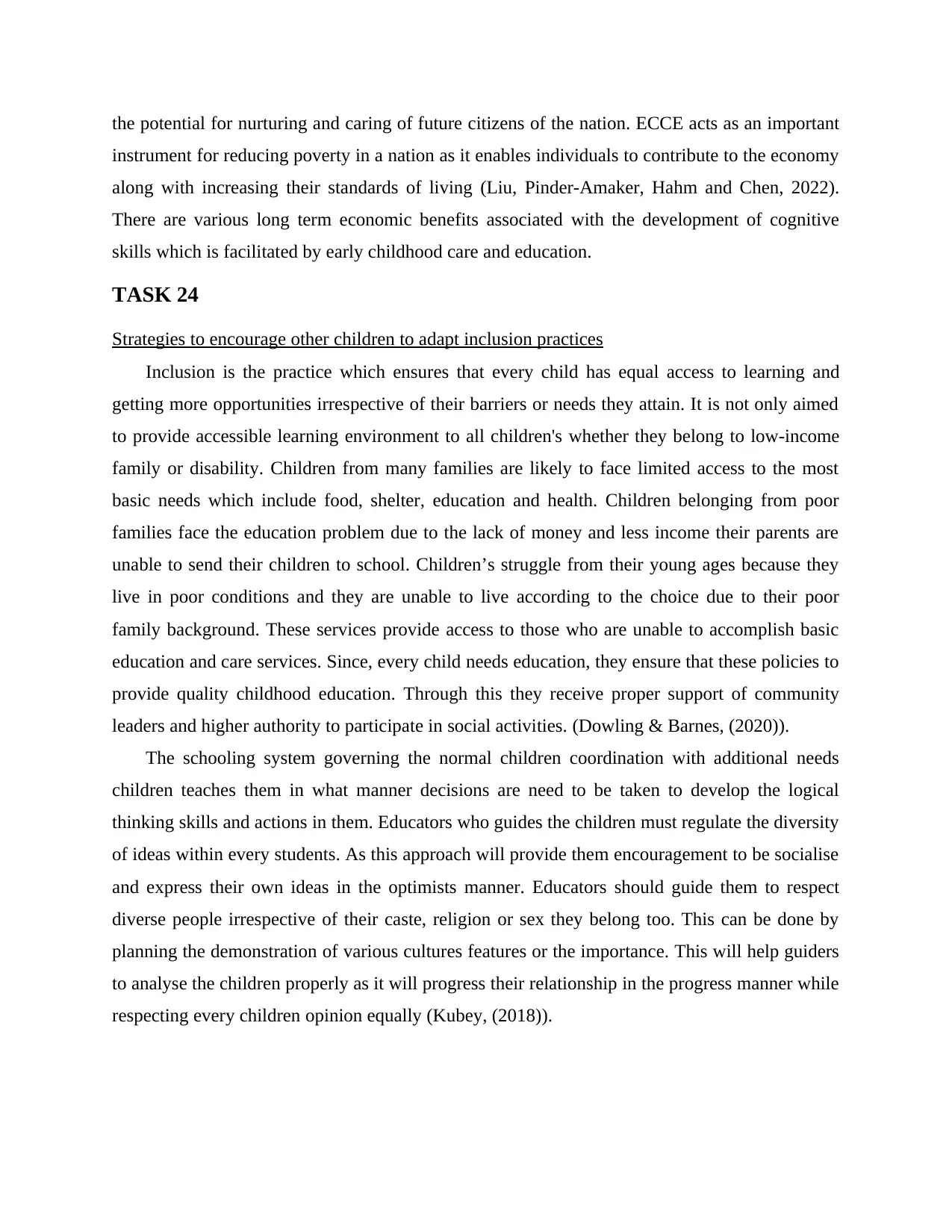
the potential for nurturing and caring of future citizens of the nation. ECCE acts as an important
instrument for reducing poverty in a nation as it enables individuals to contribute to the economy
along with increasing their standards of living (Liu, Pinder-Amaker, Hahm and Chen, 2022).
There are various long term economic benefits associated with the development of cognitive
skills which is facilitated by early childhood care and education.
TASK 24
Strategies to encourage other children to adapt inclusion practices
Inclusion is the practice which ensures that every child has equal access to learning and
getting more opportunities irrespective of their barriers or needs they attain. It is not only aimed
to provide accessible learning environment to all children's whether they belong to low-income
family or disability. Children from many families are likely to face limited access to the most
basic needs which include food, shelter, education and health. Children belonging from poor
families face the education problem due to the lack of money and less income their parents are
unable to send their children to school. Children’s struggle from their young ages because they
live in poor conditions and they are unable to live according to the choice due to their poor
family background. These services provide access to those who are unable to accomplish basic
education and care services. Since, every child needs education, they ensure that these policies to
provide quality childhood education. Through this they receive proper support of community
leaders and higher authority to participate in social activities. (Dowling & Barnes, (2020)).
The schooling system governing the normal children coordination with additional needs
children teaches them in what manner decisions are need to be taken to develop the logical
thinking skills and actions in them. Educators who guides the children must regulate the diversity
of ideas within every students. As this approach will provide them encouragement to be socialise
and express their own ideas in the optimists manner. Educators should guide them to respect
diverse people irrespective of their caste, religion or sex they belong too. This can be done by
planning the demonstration of various cultures features or the importance. This will help guiders
to analyse the children properly as it will progress their relationship in the progress manner while
respecting every children opinion equally (Kubey, (2018)).
instrument for reducing poverty in a nation as it enables individuals to contribute to the economy
along with increasing their standards of living (Liu, Pinder-Amaker, Hahm and Chen, 2022).
There are various long term economic benefits associated with the development of cognitive
skills which is facilitated by early childhood care and education.
TASK 24
Strategies to encourage other children to adapt inclusion practices
Inclusion is the practice which ensures that every child has equal access to learning and
getting more opportunities irrespective of their barriers or needs they attain. It is not only aimed
to provide accessible learning environment to all children's whether they belong to low-income
family or disability. Children from many families are likely to face limited access to the most
basic needs which include food, shelter, education and health. Children belonging from poor
families face the education problem due to the lack of money and less income their parents are
unable to send their children to school. Children’s struggle from their young ages because they
live in poor conditions and they are unable to live according to the choice due to their poor
family background. These services provide access to those who are unable to accomplish basic
education and care services. Since, every child needs education, they ensure that these policies to
provide quality childhood education. Through this they receive proper support of community
leaders and higher authority to participate in social activities. (Dowling & Barnes, (2020)).
The schooling system governing the normal children coordination with additional needs
children teaches them in what manner decisions are need to be taken to develop the logical
thinking skills and actions in them. Educators who guides the children must regulate the diversity
of ideas within every students. As this approach will provide them encouragement to be socialise
and express their own ideas in the optimists manner. Educators should guide them to respect
diverse people irrespective of their caste, religion or sex they belong too. This can be done by
planning the demonstration of various cultures features or the importance. This will help guiders
to analyse the children properly as it will progress their relationship in the progress manner while
respecting every children opinion equally (Kubey, (2018)).
Paraphrase This Document
Need a fresh take? Get an instant paraphrase of this document with our AI Paraphraser
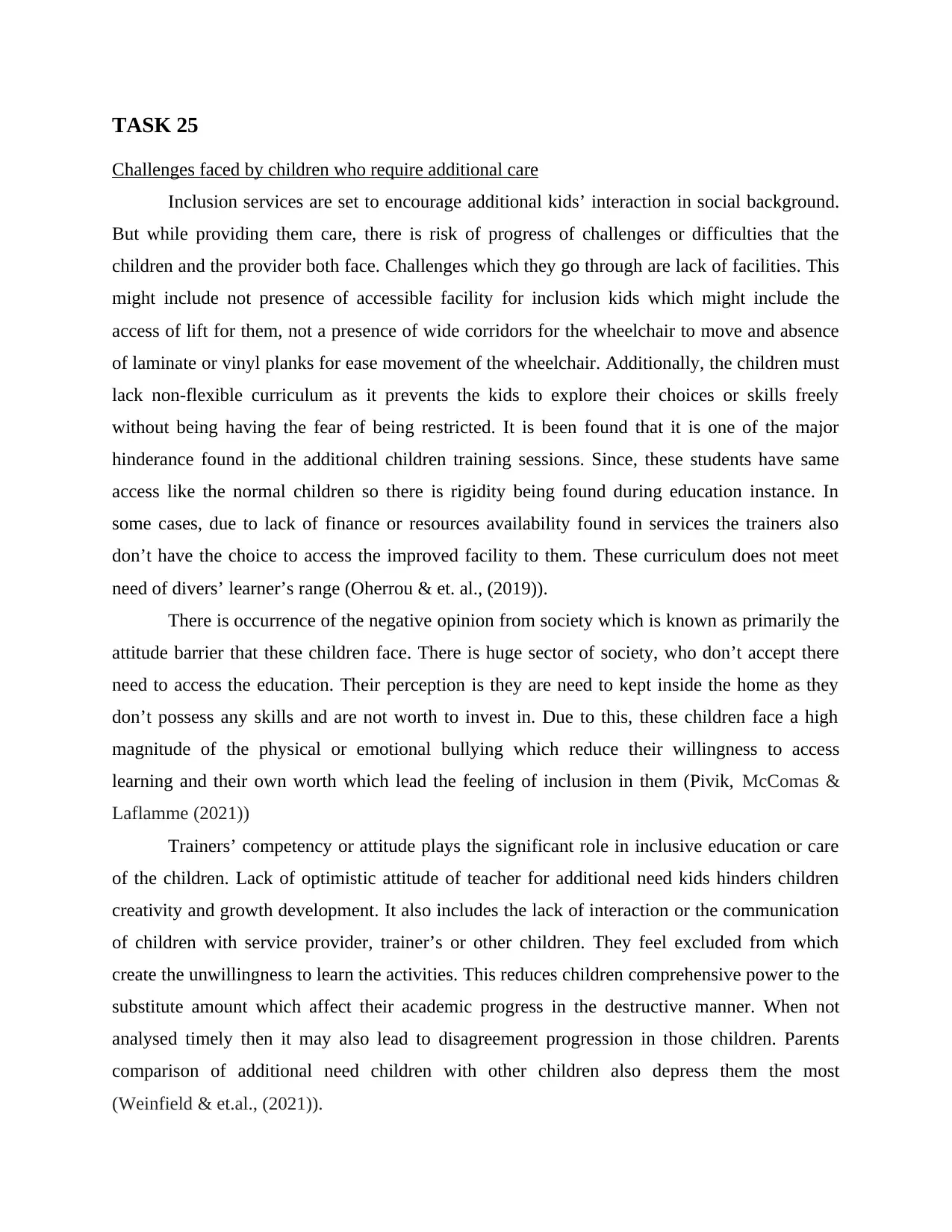
TASK 25
Challenges faced by children who require additional care
Inclusion services are set to encourage additional kids’ interaction in social background.
But while providing them care, there is risk of progress of challenges or difficulties that the
children and the provider both face. Challenges which they go through are lack of facilities. This
might include not presence of accessible facility for inclusion kids which might include the
access of lift for them, not a presence of wide corridors for the wheelchair to move and absence
of laminate or vinyl planks for ease movement of the wheelchair. Additionally, the children must
lack non-flexible curriculum as it prevents the kids to explore their choices or skills freely
without being having the fear of being restricted. It is been found that it is one of the major
hinderance found in the additional children training sessions. Since, these students have same
access like the normal children so there is rigidity being found during education instance. In
some cases, due to lack of finance or resources availability found in services the trainers also
don’t have the choice to access the improved facility to them. These curriculum does not meet
need of divers’ learner’s range (Oherrou & et. al., (2019)).
There is occurrence of the negative opinion from society which is known as primarily the
attitude barrier that these children face. There is huge sector of society, who don’t accept there
need to access the education. Their perception is they are need to kept inside the home as they
don’t possess any skills and are not worth to invest in. Due to this, these children face a high
magnitude of the physical or emotional bullying which reduce their willingness to access
learning and their own worth which lead the feeling of inclusion in them (Pivik, McComas &
Laflamme (2021))
Trainers’ competency or attitude plays the significant role in inclusive education or care
of the children. Lack of optimistic attitude of teacher for additional need kids hinders children
creativity and growth development. It also includes the lack of interaction or the communication
of children with service provider, trainer’s or other children. They feel excluded from which
create the unwillingness to learn the activities. This reduces children comprehensive power to the
substitute amount which affect their academic progress in the destructive manner. When not
analysed timely then it may also lead to disagreement progression in those children. Parents
comparison of additional need children with other children also depress them the most
(Weinfield & et.al., (2021)).
Challenges faced by children who require additional care
Inclusion services are set to encourage additional kids’ interaction in social background.
But while providing them care, there is risk of progress of challenges or difficulties that the
children and the provider both face. Challenges which they go through are lack of facilities. This
might include not presence of accessible facility for inclusion kids which might include the
access of lift for them, not a presence of wide corridors for the wheelchair to move and absence
of laminate or vinyl planks for ease movement of the wheelchair. Additionally, the children must
lack non-flexible curriculum as it prevents the kids to explore their choices or skills freely
without being having the fear of being restricted. It is been found that it is one of the major
hinderance found in the additional children training sessions. Since, these students have same
access like the normal children so there is rigidity being found during education instance. In
some cases, due to lack of finance or resources availability found in services the trainers also
don’t have the choice to access the improved facility to them. These curriculum does not meet
need of divers’ learner’s range (Oherrou & et. al., (2019)).
There is occurrence of the negative opinion from society which is known as primarily the
attitude barrier that these children face. There is huge sector of society, who don’t accept there
need to access the education. Their perception is they are need to kept inside the home as they
don’t possess any skills and are not worth to invest in. Due to this, these children face a high
magnitude of the physical or emotional bullying which reduce their willingness to access
learning and their own worth which lead the feeling of inclusion in them (Pivik, McComas &
Laflamme (2021))
Trainers’ competency or attitude plays the significant role in inclusive education or care
of the children. Lack of optimistic attitude of teacher for additional need kids hinders children
creativity and growth development. It also includes the lack of interaction or the communication
of children with service provider, trainer’s or other children. They feel excluded from which
create the unwillingness to learn the activities. This reduces children comprehensive power to the
substitute amount which affect their academic progress in the destructive manner. When not
analysed timely then it may also lead to disagreement progression in those children. Parents
comparison of additional need children with other children also depress them the most
(Weinfield & et.al., (2021)).

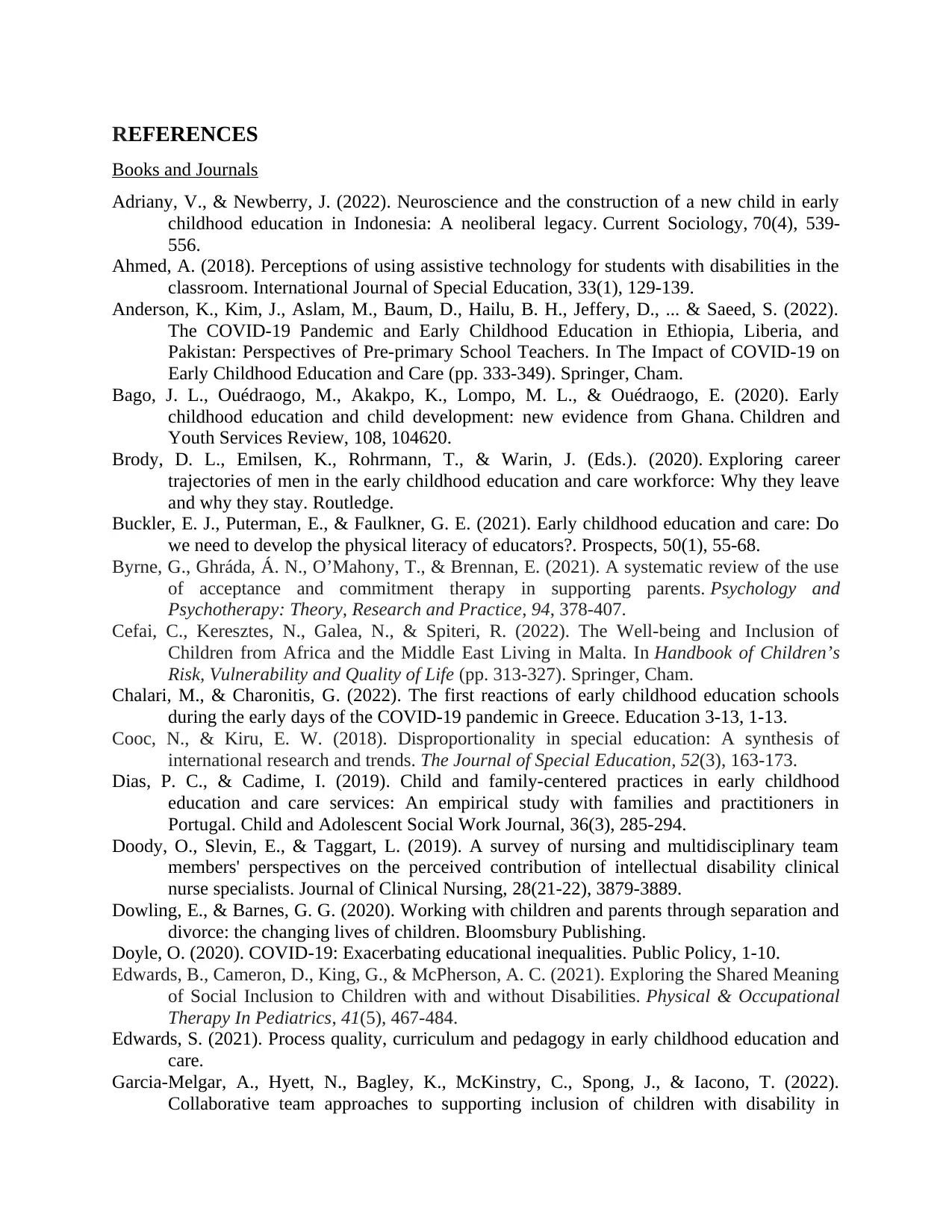
REFERENCES
Books and Journals
Adriany, V., & Newberry, J. (2022). Neuroscience and the construction of a new child in early
childhood education in Indonesia: A neoliberal legacy. Current Sociology, 70(4), 539-
556.
Ahmed, A. (2018). Perceptions of using assistive technology for students with disabilities in the
classroom. International Journal of Special Education, 33(1), 129-139.
Anderson, K., Kim, J., Aslam, M., Baum, D., Hailu, B. H., Jeffery, D., ... & Saeed, S. (2022).
The COVID-19 Pandemic and Early Childhood Education in Ethiopia, Liberia, and
Pakistan: Perspectives of Pre-primary School Teachers. In The Impact of COVID-19 on
Early Childhood Education and Care (pp. 333-349). Springer, Cham.
Bago, J. L., Ouédraogo, M., Akakpo, K., Lompo, M. L., & Ouédraogo, E. (2020). Early
childhood education and child development: new evidence from Ghana. Children and
Youth Services Review, 108, 104620.
Brody, D. L., Emilsen, K., Rohrmann, T., & Warin, J. (Eds.). (2020). Exploring career
trajectories of men in the early childhood education and care workforce: Why they leave
and why they stay. Routledge.
Buckler, E. J., Puterman, E., & Faulkner, G. E. (2021). Early childhood education and care: Do
we need to develop the physical literacy of educators?. Prospects, 50(1), 55-68.
Byrne, G., Ghráda, Á. N., O’Mahony, T., & Brennan, E. (2021). A systematic review of the use
of acceptance and commitment therapy in supporting parents. Psychology and
Psychotherapy: Theory, Research and Practice, 94, 378-407.
Cefai, C., Keresztes, N., Galea, N., & Spiteri, R. (2022). The Well-being and Inclusion of
Children from Africa and the Middle East Living in Malta. In Handbook of Children’s
Risk, Vulnerability and Quality of Life (pp. 313-327). Springer, Cham.
Chalari, M., & Charonitis, G. (2022). The first reactions of early childhood education schools
during the early days of the COVID-19 pandemic in Greece. Education 3-13, 1-13.
Cooc, N., & Kiru, E. W. (2018). Disproportionality in special education: A synthesis of
international research and trends. The Journal of Special Education, 52(3), 163-173.
Dias, P. C., & Cadime, I. (2019). Child and family-centered practices in early childhood
education and care services: An empirical study with families and practitioners in
Portugal. Child and Adolescent Social Work Journal, 36(3), 285-294.
Doody, O., Slevin, E., & Taggart, L. (2019). A survey of nursing and multidisciplinary team
members' perspectives on the perceived contribution of intellectual disability clinical
nurse specialists. Journal of Clinical Nursing, 28(21-22), 3879-3889.
Dowling, E., & Barnes, G. G. (2020). Working with children and parents through separation and
divorce: the changing lives of children. Bloomsbury Publishing.
Doyle, O. (2020). COVID-19: Exacerbating educational inequalities. Public Policy, 1-10.
Edwards, B., Cameron, D., King, G., & McPherson, A. C. (2021). Exploring the Shared Meaning
of Social Inclusion to Children with and without Disabilities. Physical & Occupational
Therapy In Pediatrics, 41(5), 467-484.
Edwards, S. (2021). Process quality, curriculum and pedagogy in early childhood education and
care.
Garcia-Melgar, A., Hyett, N., Bagley, K., McKinstry, C., Spong, J., & Iacono, T. (2022).
Collaborative team approaches to supporting inclusion of children with disability in
Books and Journals
Adriany, V., & Newberry, J. (2022). Neuroscience and the construction of a new child in early
childhood education in Indonesia: A neoliberal legacy. Current Sociology, 70(4), 539-
556.
Ahmed, A. (2018). Perceptions of using assistive technology for students with disabilities in the
classroom. International Journal of Special Education, 33(1), 129-139.
Anderson, K., Kim, J., Aslam, M., Baum, D., Hailu, B. H., Jeffery, D., ... & Saeed, S. (2022).
The COVID-19 Pandemic and Early Childhood Education in Ethiopia, Liberia, and
Pakistan: Perspectives of Pre-primary School Teachers. In The Impact of COVID-19 on
Early Childhood Education and Care (pp. 333-349). Springer, Cham.
Bago, J. L., Ouédraogo, M., Akakpo, K., Lompo, M. L., & Ouédraogo, E. (2020). Early
childhood education and child development: new evidence from Ghana. Children and
Youth Services Review, 108, 104620.
Brody, D. L., Emilsen, K., Rohrmann, T., & Warin, J. (Eds.). (2020). Exploring career
trajectories of men in the early childhood education and care workforce: Why they leave
and why they stay. Routledge.
Buckler, E. J., Puterman, E., & Faulkner, G. E. (2021). Early childhood education and care: Do
we need to develop the physical literacy of educators?. Prospects, 50(1), 55-68.
Byrne, G., Ghráda, Á. N., O’Mahony, T., & Brennan, E. (2021). A systematic review of the use
of acceptance and commitment therapy in supporting parents. Psychology and
Psychotherapy: Theory, Research and Practice, 94, 378-407.
Cefai, C., Keresztes, N., Galea, N., & Spiteri, R. (2022). The Well-being and Inclusion of
Children from Africa and the Middle East Living in Malta. In Handbook of Children’s
Risk, Vulnerability and Quality of Life (pp. 313-327). Springer, Cham.
Chalari, M., & Charonitis, G. (2022). The first reactions of early childhood education schools
during the early days of the COVID-19 pandemic in Greece. Education 3-13, 1-13.
Cooc, N., & Kiru, E. W. (2018). Disproportionality in special education: A synthesis of
international research and trends. The Journal of Special Education, 52(3), 163-173.
Dias, P. C., & Cadime, I. (2019). Child and family-centered practices in early childhood
education and care services: An empirical study with families and practitioners in
Portugal. Child and Adolescent Social Work Journal, 36(3), 285-294.
Doody, O., Slevin, E., & Taggart, L. (2019). A survey of nursing and multidisciplinary team
members' perspectives on the perceived contribution of intellectual disability clinical
nurse specialists. Journal of Clinical Nursing, 28(21-22), 3879-3889.
Dowling, E., & Barnes, G. G. (2020). Working with children and parents through separation and
divorce: the changing lives of children. Bloomsbury Publishing.
Doyle, O. (2020). COVID-19: Exacerbating educational inequalities. Public Policy, 1-10.
Edwards, B., Cameron, D., King, G., & McPherson, A. C. (2021). Exploring the Shared Meaning
of Social Inclusion to Children with and without Disabilities. Physical & Occupational
Therapy In Pediatrics, 41(5), 467-484.
Edwards, S. (2021). Process quality, curriculum and pedagogy in early childhood education and
care.
Garcia-Melgar, A., Hyett, N., Bagley, K., McKinstry, C., Spong, J., & Iacono, T. (2022).
Collaborative team approaches to supporting inclusion of children with disability in
Secure Best Marks with AI Grader
Need help grading? Try our AI Grader for instant feedback on your assignments.
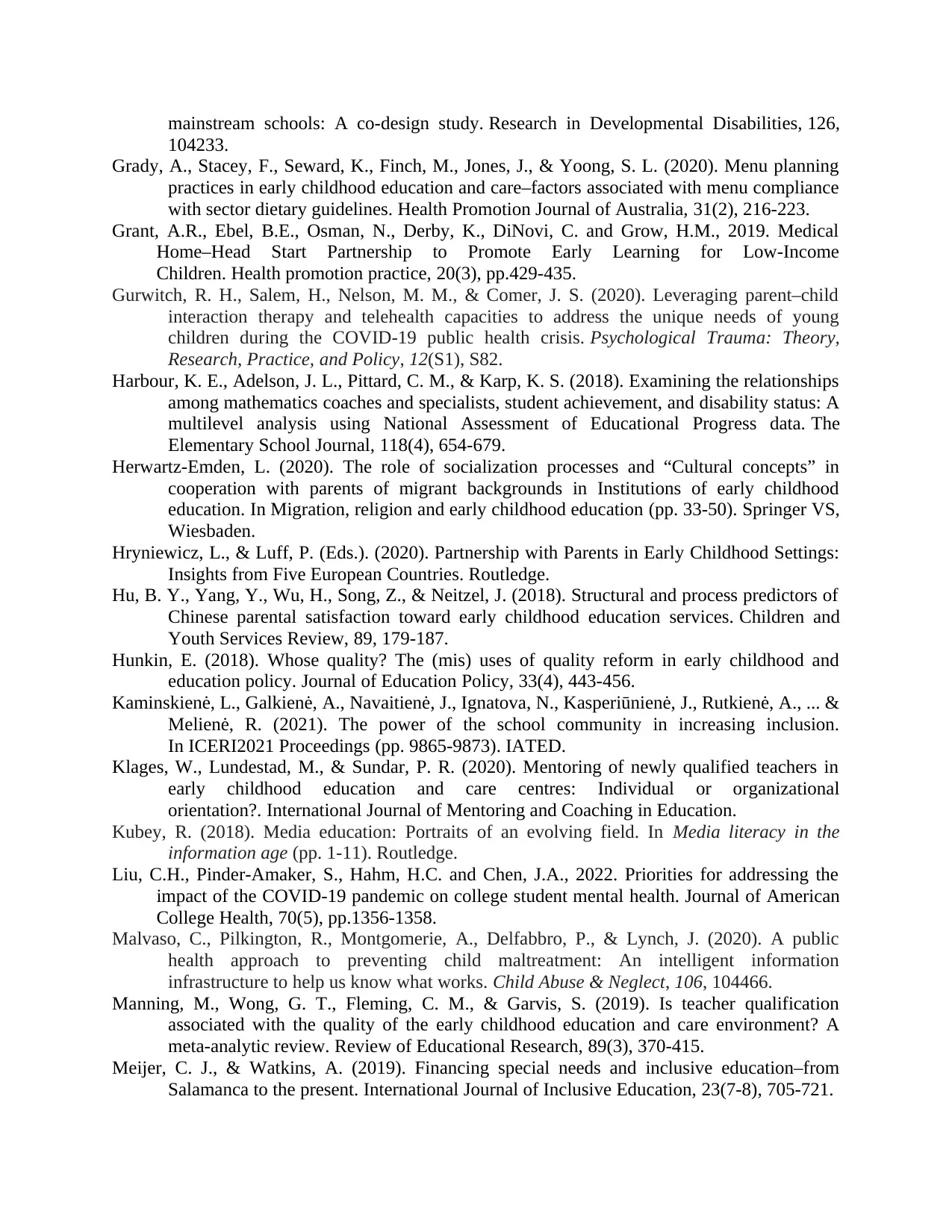
mainstream schools: A co-design study. Research in Developmental Disabilities, 126,
104233.
Grady, A., Stacey, F., Seward, K., Finch, M., Jones, J., & Yoong, S. L. (2020). Menu planning
practices in early childhood education and care–factors associated with menu compliance
with sector dietary guidelines. Health Promotion Journal of Australia, 31(2), 216-223.
Grant, A.R., Ebel, B.E., Osman, N., Derby, K., DiNovi, C. and Grow, H.M., 2019. Medical
Home–Head Start Partnership to Promote Early Learning for Low-Income
Children. Health promotion practice, 20(3), pp.429-435.
Gurwitch, R. H., Salem, H., Nelson, M. M., & Comer, J. S. (2020). Leveraging parent–child
interaction therapy and telehealth capacities to address the unique needs of young
children during the COVID-19 public health crisis. Psychological Trauma: Theory,
Research, Practice, and Policy, 12(S1), S82.
Harbour, K. E., Adelson, J. L., Pittard, C. M., & Karp, K. S. (2018). Examining the relationships
among mathematics coaches and specialists, student achievement, and disability status: A
multilevel analysis using National Assessment of Educational Progress data. The
Elementary School Journal, 118(4), 654-679.
Herwartz-Emden, L. (2020). The role of socialization processes and “Cultural concepts” in
cooperation with parents of migrant backgrounds in Institutions of early childhood
education. In Migration, religion and early childhood education (pp. 33-50). Springer VS,
Wiesbaden.
Hryniewicz, L., & Luff, P. (Eds.). (2020). Partnership with Parents in Early Childhood Settings:
Insights from Five European Countries. Routledge.
Hu, B. Y., Yang, Y., Wu, H., Song, Z., & Neitzel, J. (2018). Structural and process predictors of
Chinese parental satisfaction toward early childhood education services. Children and
Youth Services Review, 89, 179-187.
Hunkin, E. (2018). Whose quality? The (mis) uses of quality reform in early childhood and
education policy. Journal of Education Policy, 33(4), 443-456.
Kaminskienė, L., Galkienė, A., Navaitienė, J., Ignatova, N., Kasperiūnienė, J., Rutkienė, A., ... &
Melienė, R. (2021). The power of the school community in increasing inclusion.
In ICERI2021 Proceedings (pp. 9865-9873). IATED.
Klages, W., Lundestad, M., & Sundar, P. R. (2020). Mentoring of newly qualified teachers in
early childhood education and care centres: Individual or organizational
orientation?. International Journal of Mentoring and Coaching in Education.
Kubey, R. (2018). Media education: Portraits of an evolving field. In Media literacy in the
information age (pp. 1-11). Routledge.
Liu, C.H., Pinder-Amaker, S., Hahm, H.C. and Chen, J.A., 2022. Priorities for addressing the
impact of the COVID-19 pandemic on college student mental health. Journal of American
College Health, 70(5), pp.1356-1358.
Malvaso, C., Pilkington, R., Montgomerie, A., Delfabbro, P., & Lynch, J. (2020). A public
health approach to preventing child maltreatment: An intelligent information
infrastructure to help us know what works. Child Abuse & Neglect, 106, 104466.
Manning, M., Wong, G. T., Fleming, C. M., & Garvis, S. (2019). Is teacher qualification
associated with the quality of the early childhood education and care environment? A
meta-analytic review. Review of Educational Research, 89(3), 370-415.
Meijer, C. J., & Watkins, A. (2019). Financing special needs and inclusive education–from
Salamanca to the present. International Journal of Inclusive Education, 23(7-8), 705-721.
104233.
Grady, A., Stacey, F., Seward, K., Finch, M., Jones, J., & Yoong, S. L. (2020). Menu planning
practices in early childhood education and care–factors associated with menu compliance
with sector dietary guidelines. Health Promotion Journal of Australia, 31(2), 216-223.
Grant, A.R., Ebel, B.E., Osman, N., Derby, K., DiNovi, C. and Grow, H.M., 2019. Medical
Home–Head Start Partnership to Promote Early Learning for Low-Income
Children. Health promotion practice, 20(3), pp.429-435.
Gurwitch, R. H., Salem, H., Nelson, M. M., & Comer, J. S. (2020). Leveraging parent–child
interaction therapy and telehealth capacities to address the unique needs of young
children during the COVID-19 public health crisis. Psychological Trauma: Theory,
Research, Practice, and Policy, 12(S1), S82.
Harbour, K. E., Adelson, J. L., Pittard, C. M., & Karp, K. S. (2018). Examining the relationships
among mathematics coaches and specialists, student achievement, and disability status: A
multilevel analysis using National Assessment of Educational Progress data. The
Elementary School Journal, 118(4), 654-679.
Herwartz-Emden, L. (2020). The role of socialization processes and “Cultural concepts” in
cooperation with parents of migrant backgrounds in Institutions of early childhood
education. In Migration, religion and early childhood education (pp. 33-50). Springer VS,
Wiesbaden.
Hryniewicz, L., & Luff, P. (Eds.). (2020). Partnership with Parents in Early Childhood Settings:
Insights from Five European Countries. Routledge.
Hu, B. Y., Yang, Y., Wu, H., Song, Z., & Neitzel, J. (2018). Structural and process predictors of
Chinese parental satisfaction toward early childhood education services. Children and
Youth Services Review, 89, 179-187.
Hunkin, E. (2018). Whose quality? The (mis) uses of quality reform in early childhood and
education policy. Journal of Education Policy, 33(4), 443-456.
Kaminskienė, L., Galkienė, A., Navaitienė, J., Ignatova, N., Kasperiūnienė, J., Rutkienė, A., ... &
Melienė, R. (2021). The power of the school community in increasing inclusion.
In ICERI2021 Proceedings (pp. 9865-9873). IATED.
Klages, W., Lundestad, M., & Sundar, P. R. (2020). Mentoring of newly qualified teachers in
early childhood education and care centres: Individual or organizational
orientation?. International Journal of Mentoring and Coaching in Education.
Kubey, R. (2018). Media education: Portraits of an evolving field. In Media literacy in the
information age (pp. 1-11). Routledge.
Liu, C.H., Pinder-Amaker, S., Hahm, H.C. and Chen, J.A., 2022. Priorities for addressing the
impact of the COVID-19 pandemic on college student mental health. Journal of American
College Health, 70(5), pp.1356-1358.
Malvaso, C., Pilkington, R., Montgomerie, A., Delfabbro, P., & Lynch, J. (2020). A public
health approach to preventing child maltreatment: An intelligent information
infrastructure to help us know what works. Child Abuse & Neglect, 106, 104466.
Manning, M., Wong, G. T., Fleming, C. M., & Garvis, S. (2019). Is teacher qualification
associated with the quality of the early childhood education and care environment? A
meta-analytic review. Review of Educational Research, 89(3), 370-415.
Meijer, C. J., & Watkins, A. (2019). Financing special needs and inclusive education–from
Salamanca to the present. International Journal of Inclusive Education, 23(7-8), 705-721.
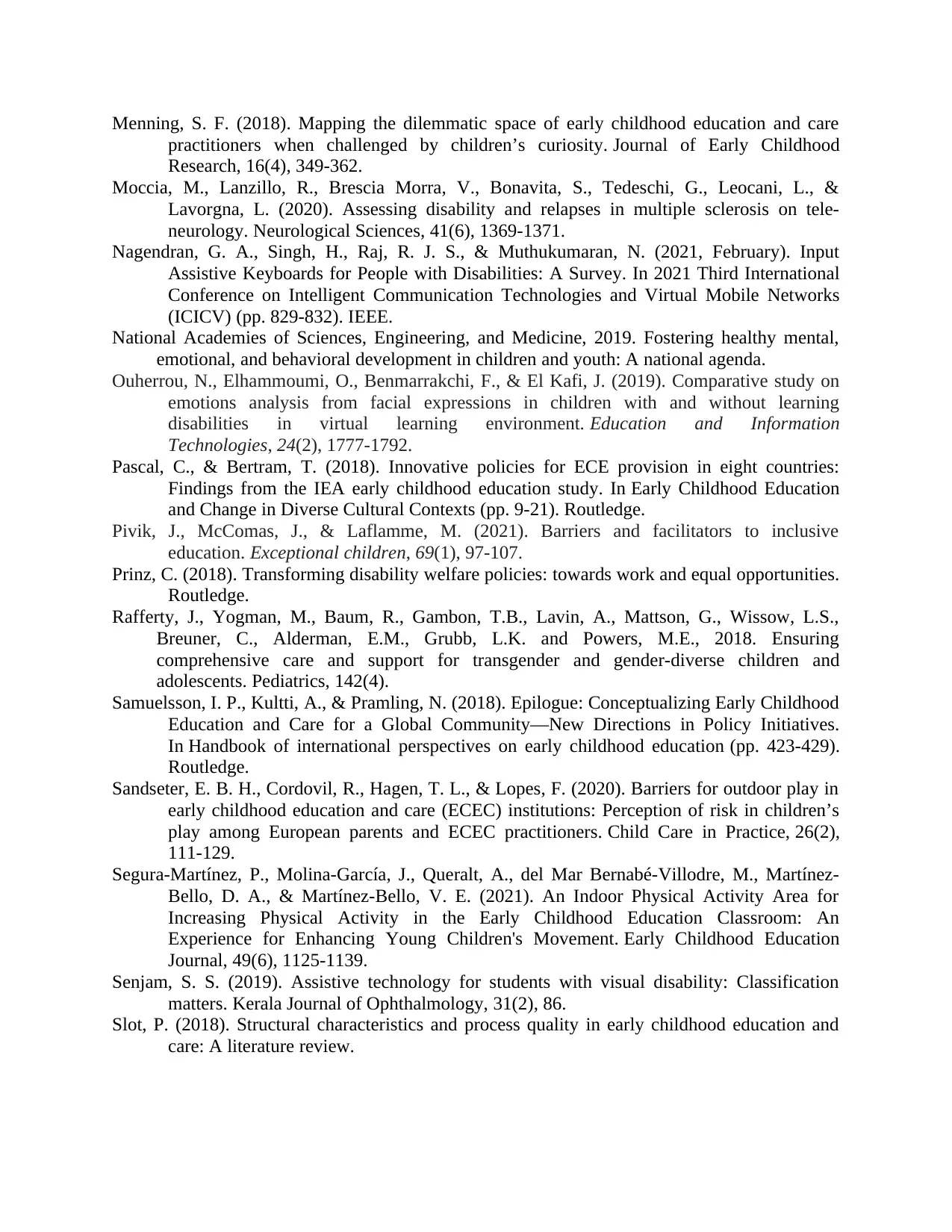
Menning, S. F. (2018). Mapping the dilemmatic space of early childhood education and care
practitioners when challenged by children’s curiosity. Journal of Early Childhood
Research, 16(4), 349-362.
Moccia, M., Lanzillo, R., Brescia Morra, V., Bonavita, S., Tedeschi, G., Leocani, L., &
Lavorgna, L. (2020). Assessing disability and relapses in multiple sclerosis on tele-
neurology. Neurological Sciences, 41(6), 1369-1371.
Nagendran, G. A., Singh, H., Raj, R. J. S., & Muthukumaran, N. (2021, February). Input
Assistive Keyboards for People with Disabilities: A Survey. In 2021 Third International
Conference on Intelligent Communication Technologies and Virtual Mobile Networks
(ICICV) (pp. 829-832). IEEE.
National Academies of Sciences, Engineering, and Medicine, 2019. Fostering healthy mental,
emotional, and behavioral development in children and youth: A national agenda.
Ouherrou, N., Elhammoumi, O., Benmarrakchi, F., & El Kafi, J. (2019). Comparative study on
emotions analysis from facial expressions in children with and without learning
disabilities in virtual learning environment. Education and Information
Technologies, 24(2), 1777-1792.
Pascal, C., & Bertram, T. (2018). Innovative policies for ECE provision in eight countries:
Findings from the IEA early childhood education study. In Early Childhood Education
and Change in Diverse Cultural Contexts (pp. 9-21). Routledge.
Pivik, J., McComas, J., & Laflamme, M. (2021). Barriers and facilitators to inclusive
education. Exceptional children, 69(1), 97-107.
Prinz, C. (2018). Transforming disability welfare policies: towards work and equal opportunities.
Routledge.
Rafferty, J., Yogman, M., Baum, R., Gambon, T.B., Lavin, A., Mattson, G., Wissow, L.S.,
Breuner, C., Alderman, E.M., Grubb, L.K. and Powers, M.E., 2018. Ensuring
comprehensive care and support for transgender and gender-diverse children and
adolescents. Pediatrics, 142(4).
Samuelsson, I. P., Kultti, A., & Pramling, N. (2018). Epilogue: Conceptualizing Early Childhood
Education and Care for a Global Community—New Directions in Policy Initiatives.
In Handbook of international perspectives on early childhood education (pp. 423-429).
Routledge.
Sandseter, E. B. H., Cordovil, R., Hagen, T. L., & Lopes, F. (2020). Barriers for outdoor play in
early childhood education and care (ECEC) institutions: Perception of risk in children’s
play among European parents and ECEC practitioners. Child Care in Practice, 26(2),
111-129.
Segura-Martínez, P., Molina-García, J., Queralt, A., del Mar Bernabé-Villodre, M., Martínez-
Bello, D. A., & Martínez-Bello, V. E. (2021). An Indoor Physical Activity Area for
Increasing Physical Activity in the Early Childhood Education Classroom: An
Experience for Enhancing Young Children's Movement. Early Childhood Education
Journal, 49(6), 1125-1139.
Senjam, S. S. (2019). Assistive technology for students with visual disability: Classification
matters. Kerala Journal of Ophthalmology, 31(2), 86.
Slot, P. (2018). Structural characteristics and process quality in early childhood education and
care: A literature review.
practitioners when challenged by children’s curiosity. Journal of Early Childhood
Research, 16(4), 349-362.
Moccia, M., Lanzillo, R., Brescia Morra, V., Bonavita, S., Tedeschi, G., Leocani, L., &
Lavorgna, L. (2020). Assessing disability and relapses in multiple sclerosis on tele-
neurology. Neurological Sciences, 41(6), 1369-1371.
Nagendran, G. A., Singh, H., Raj, R. J. S., & Muthukumaran, N. (2021, February). Input
Assistive Keyboards for People with Disabilities: A Survey. In 2021 Third International
Conference on Intelligent Communication Technologies and Virtual Mobile Networks
(ICICV) (pp. 829-832). IEEE.
National Academies of Sciences, Engineering, and Medicine, 2019. Fostering healthy mental,
emotional, and behavioral development in children and youth: A national agenda.
Ouherrou, N., Elhammoumi, O., Benmarrakchi, F., & El Kafi, J. (2019). Comparative study on
emotions analysis from facial expressions in children with and without learning
disabilities in virtual learning environment. Education and Information
Technologies, 24(2), 1777-1792.
Pascal, C., & Bertram, T. (2018). Innovative policies for ECE provision in eight countries:
Findings from the IEA early childhood education study. In Early Childhood Education
and Change in Diverse Cultural Contexts (pp. 9-21). Routledge.
Pivik, J., McComas, J., & Laflamme, M. (2021). Barriers and facilitators to inclusive
education. Exceptional children, 69(1), 97-107.
Prinz, C. (2018). Transforming disability welfare policies: towards work and equal opportunities.
Routledge.
Rafferty, J., Yogman, M., Baum, R., Gambon, T.B., Lavin, A., Mattson, G., Wissow, L.S.,
Breuner, C., Alderman, E.M., Grubb, L.K. and Powers, M.E., 2018. Ensuring
comprehensive care and support for transgender and gender-diverse children and
adolescents. Pediatrics, 142(4).
Samuelsson, I. P., Kultti, A., & Pramling, N. (2018). Epilogue: Conceptualizing Early Childhood
Education and Care for a Global Community—New Directions in Policy Initiatives.
In Handbook of international perspectives on early childhood education (pp. 423-429).
Routledge.
Sandseter, E. B. H., Cordovil, R., Hagen, T. L., & Lopes, F. (2020). Barriers for outdoor play in
early childhood education and care (ECEC) institutions: Perception of risk in children’s
play among European parents and ECEC practitioners. Child Care in Practice, 26(2),
111-129.
Segura-Martínez, P., Molina-García, J., Queralt, A., del Mar Bernabé-Villodre, M., Martínez-
Bello, D. A., & Martínez-Bello, V. E. (2021). An Indoor Physical Activity Area for
Increasing Physical Activity in the Early Childhood Education Classroom: An
Experience for Enhancing Young Children's Movement. Early Childhood Education
Journal, 49(6), 1125-1139.
Senjam, S. S. (2019). Assistive technology for students with visual disability: Classification
matters. Kerala Journal of Ophthalmology, 31(2), 86.
Slot, P. (2018). Structural characteristics and process quality in early childhood education and
care: A literature review.
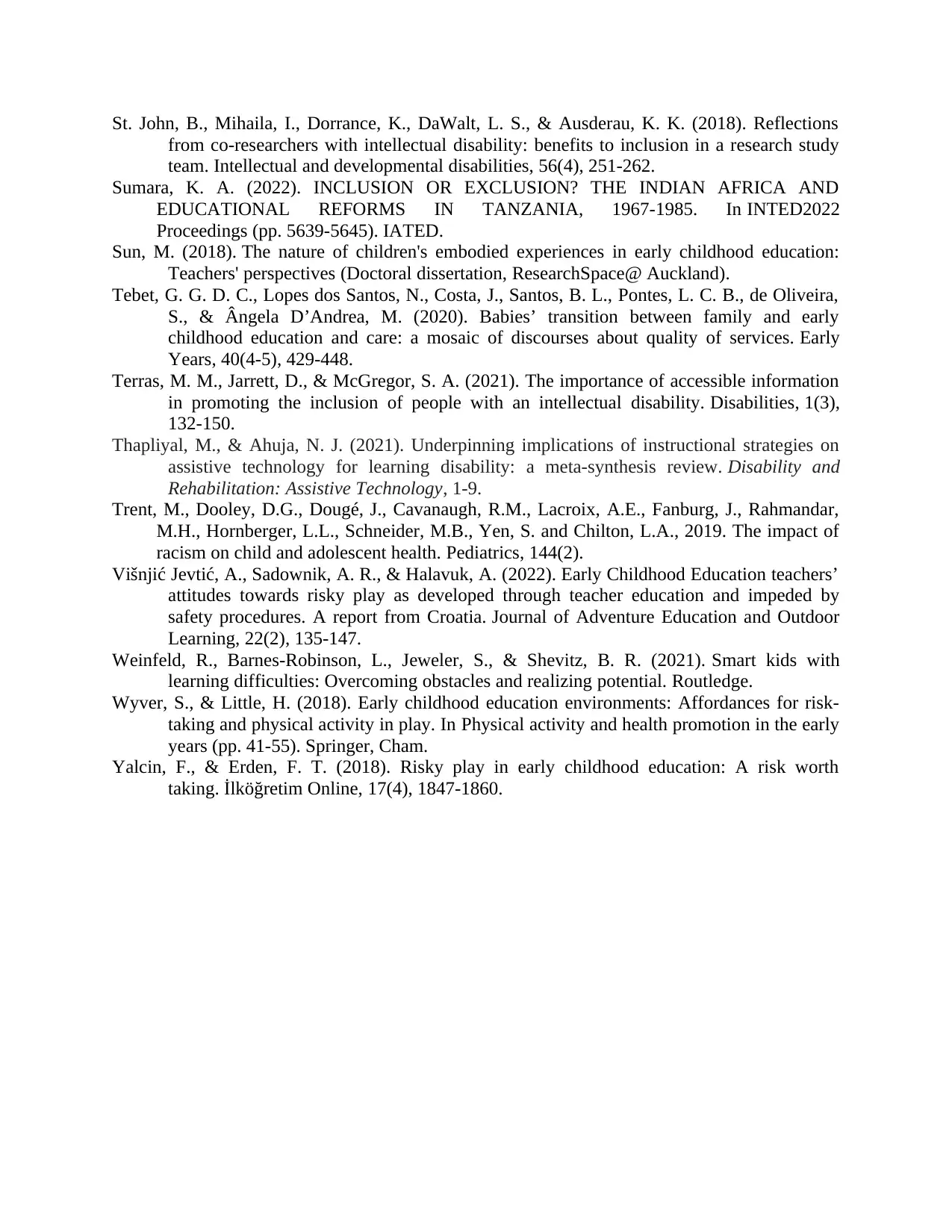
St. John, B., Mihaila, I., Dorrance, K., DaWalt, L. S., & Ausderau, K. K. (2018). Reflections
from co-researchers with intellectual disability: benefits to inclusion in a research study
team. Intellectual and developmental disabilities, 56(4), 251-262.
Sumara, K. A. (2022). INCLUSION OR EXCLUSION? THE INDIAN AFRICA AND
EDUCATIONAL REFORMS IN TANZANIA, 1967-1985. In INTED2022
Proceedings (pp. 5639-5645). IATED.
Sun, M. (2018). The nature of children's embodied experiences in early childhood education:
Teachers' perspectives (Doctoral dissertation, ResearchSpace@ Auckland).
Tebet, G. G. D. C., Lopes dos Santos, N., Costa, J., Santos, B. L., Pontes, L. C. B., de Oliveira,
S., & Ângela D’Andrea, M. (2020). Babies’ transition between family and early
childhood education and care: a mosaic of discourses about quality of services. Early
Years, 40(4-5), 429-448.
Terras, M. M., Jarrett, D., & McGregor, S. A. (2021). The importance of accessible information
in promoting the inclusion of people with an intellectual disability. Disabilities, 1(3),
132-150.
Thapliyal, M., & Ahuja, N. J. (2021). Underpinning implications of instructional strategies on
assistive technology for learning disability: a meta-synthesis review. Disability and
Rehabilitation: Assistive Technology, 1-9.
Trent, M., Dooley, D.G., Dougé, J., Cavanaugh, R.M., Lacroix, A.E., Fanburg, J., Rahmandar,
M.H., Hornberger, L.L., Schneider, M.B., Yen, S. and Chilton, L.A., 2019. The impact of
racism on child and adolescent health. Pediatrics, 144(2).
Višnjić Jevtić, A., Sadownik, A. R., & Halavuk, A. (2022). Early Childhood Education teachers’
attitudes towards risky play as developed through teacher education and impeded by
safety procedures. A report from Croatia. Journal of Adventure Education and Outdoor
Learning, 22(2), 135-147.
Weinfeld, R., Barnes-Robinson, L., Jeweler, S., & Shevitz, B. R. (2021). Smart kids with
learning difficulties: Overcoming obstacles and realizing potential. Routledge.
Wyver, S., & Little, H. (2018). Early childhood education environments: Affordances for risk-
taking and physical activity in play. In Physical activity and health promotion in the early
years (pp. 41-55). Springer, Cham.
Yalcin, F., & Erden, F. T. (2018). Risky play in early childhood education: A risk worth
taking. İlköğretim Online, 17(4), 1847-1860.
from co-researchers with intellectual disability: benefits to inclusion in a research study
team. Intellectual and developmental disabilities, 56(4), 251-262.
Sumara, K. A. (2022). INCLUSION OR EXCLUSION? THE INDIAN AFRICA AND
EDUCATIONAL REFORMS IN TANZANIA, 1967-1985. In INTED2022
Proceedings (pp. 5639-5645). IATED.
Sun, M. (2018). The nature of children's embodied experiences in early childhood education:
Teachers' perspectives (Doctoral dissertation, ResearchSpace@ Auckland).
Tebet, G. G. D. C., Lopes dos Santos, N., Costa, J., Santos, B. L., Pontes, L. C. B., de Oliveira,
S., & Ângela D’Andrea, M. (2020). Babies’ transition between family and early
childhood education and care: a mosaic of discourses about quality of services. Early
Years, 40(4-5), 429-448.
Terras, M. M., Jarrett, D., & McGregor, S. A. (2021). The importance of accessible information
in promoting the inclusion of people with an intellectual disability. Disabilities, 1(3),
132-150.
Thapliyal, M., & Ahuja, N. J. (2021). Underpinning implications of instructional strategies on
assistive technology for learning disability: a meta-synthesis review. Disability and
Rehabilitation: Assistive Technology, 1-9.
Trent, M., Dooley, D.G., Dougé, J., Cavanaugh, R.M., Lacroix, A.E., Fanburg, J., Rahmandar,
M.H., Hornberger, L.L., Schneider, M.B., Yen, S. and Chilton, L.A., 2019. The impact of
racism on child and adolescent health. Pediatrics, 144(2).
Višnjić Jevtić, A., Sadownik, A. R., & Halavuk, A. (2022). Early Childhood Education teachers’
attitudes towards risky play as developed through teacher education and impeded by
safety procedures. A report from Croatia. Journal of Adventure Education and Outdoor
Learning, 22(2), 135-147.
Weinfeld, R., Barnes-Robinson, L., Jeweler, S., & Shevitz, B. R. (2021). Smart kids with
learning difficulties: Overcoming obstacles and realizing potential. Routledge.
Wyver, S., & Little, H. (2018). Early childhood education environments: Affordances for risk-
taking and physical activity in play. In Physical activity and health promotion in the early
years (pp. 41-55). Springer, Cham.
Yalcin, F., & Erden, F. T. (2018). Risky play in early childhood education: A risk worth
taking. İlköğretim Online, 17(4), 1847-1860.
1 out of 31
Related Documents
Your All-in-One AI-Powered Toolkit for Academic Success.
+13062052269
info@desklib.com
Available 24*7 on WhatsApp / Email
![[object Object]](/_next/static/media/star-bottom.7253800d.svg)
Unlock your academic potential
© 2024 | Zucol Services PVT LTD | All rights reserved.





